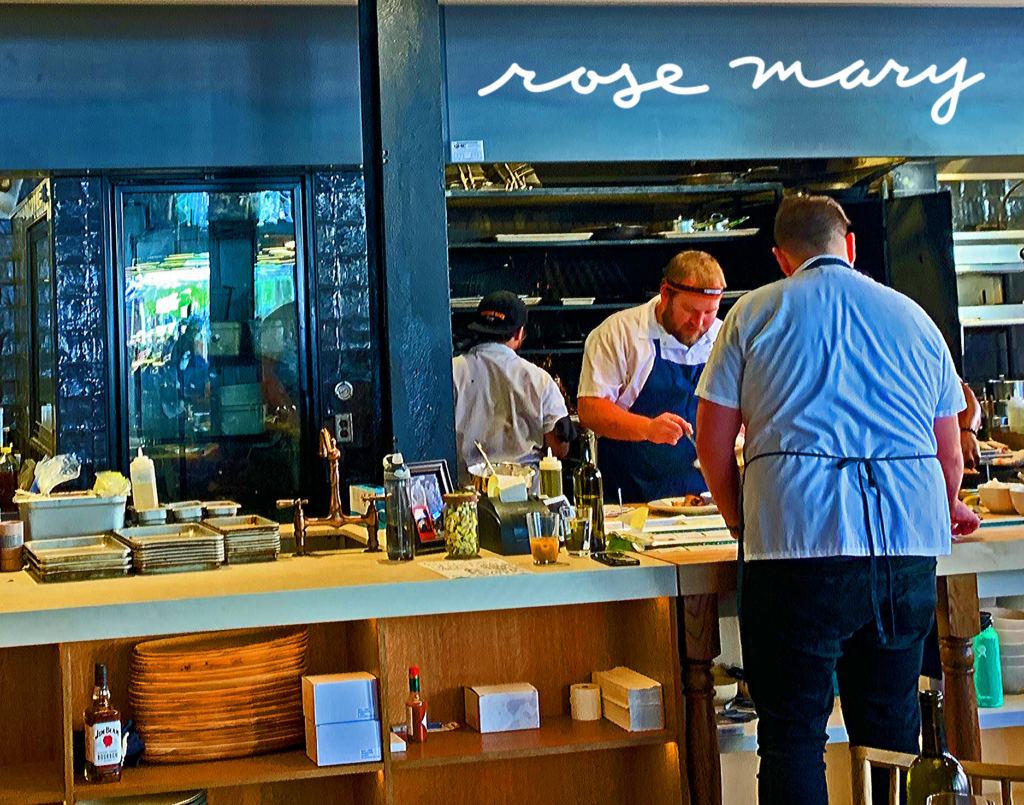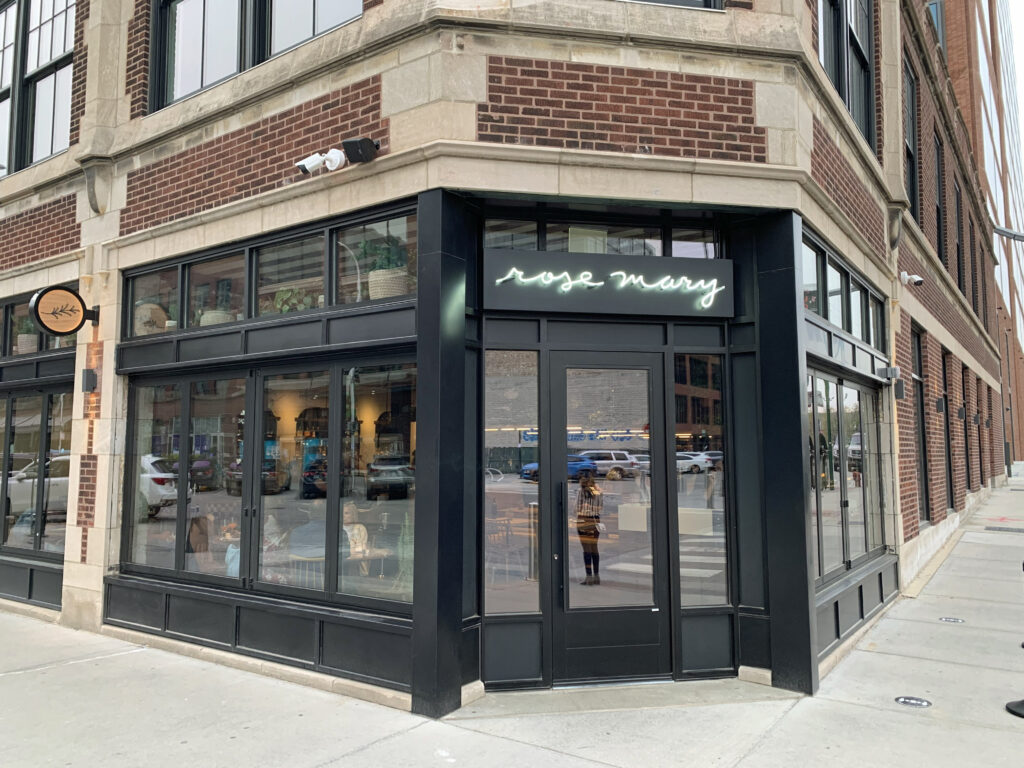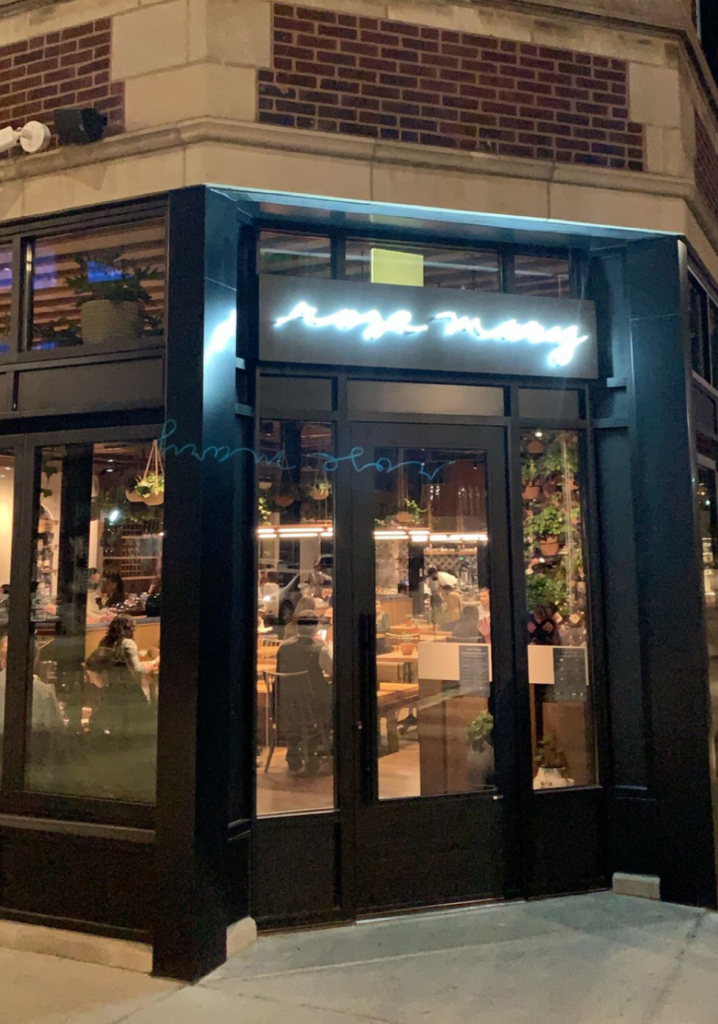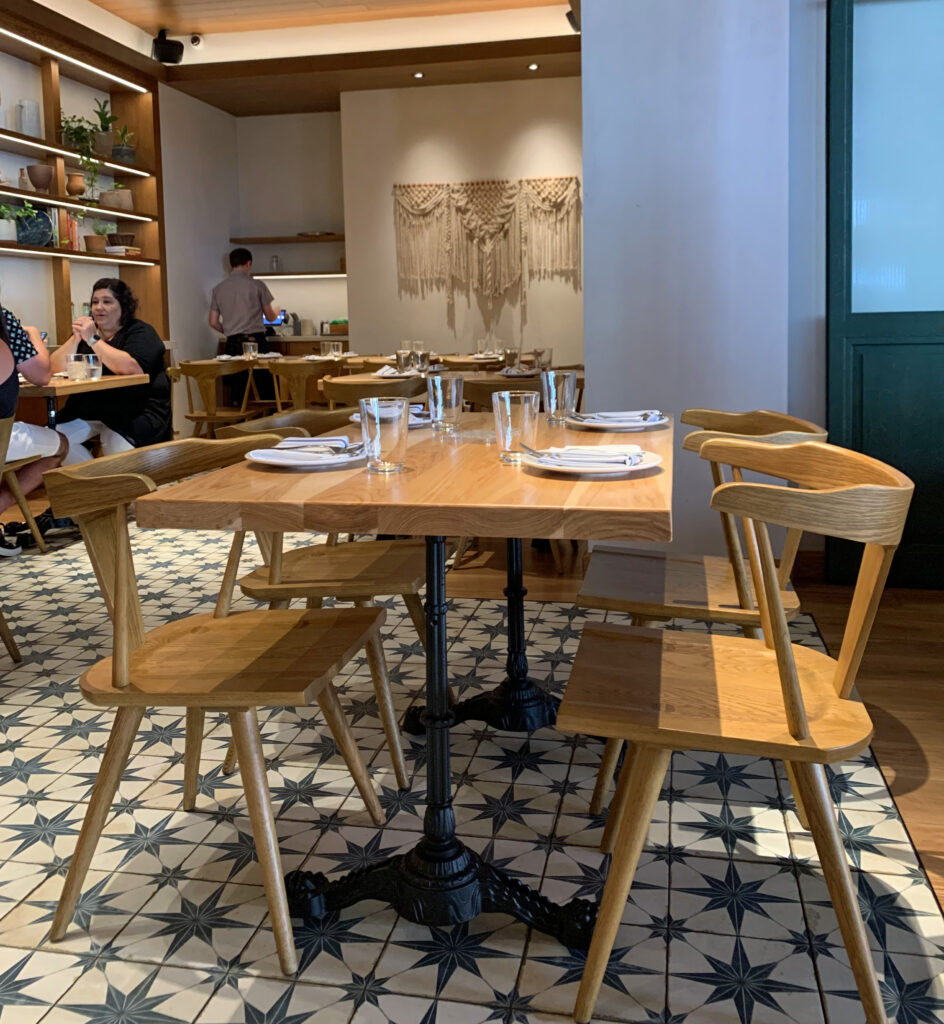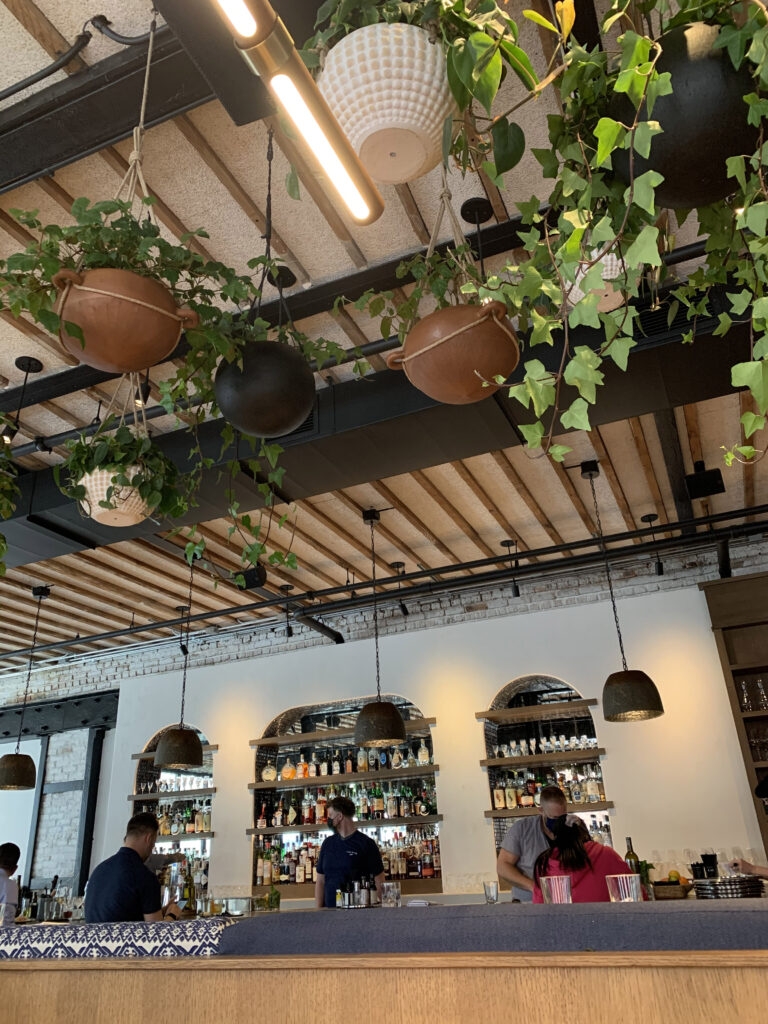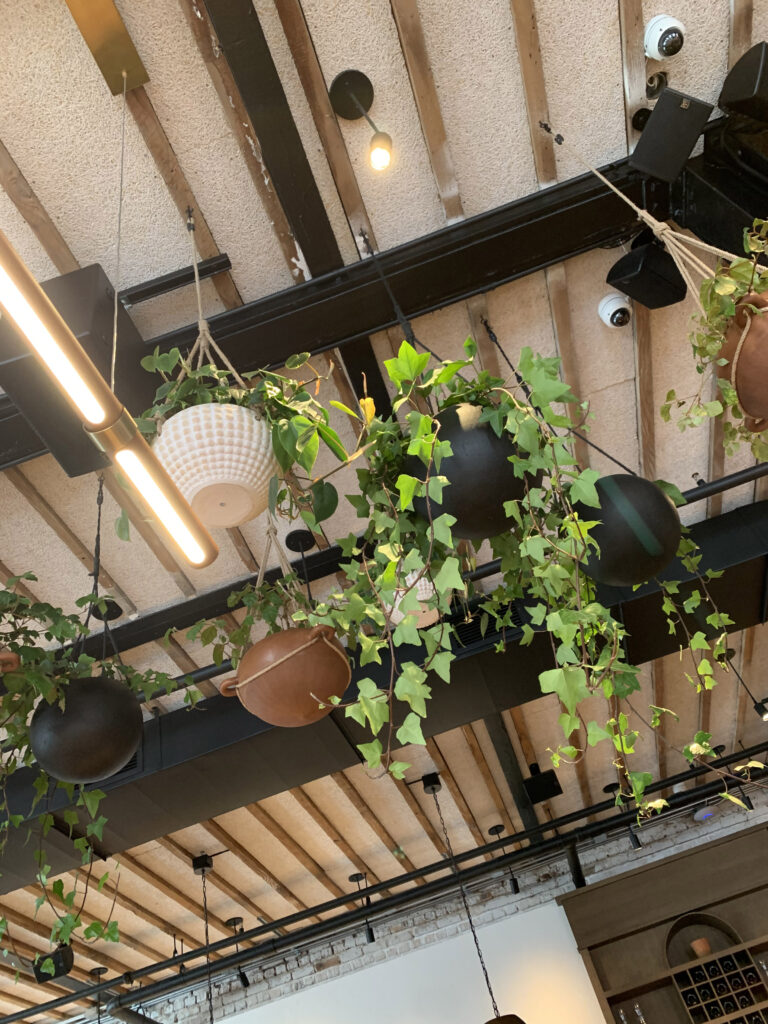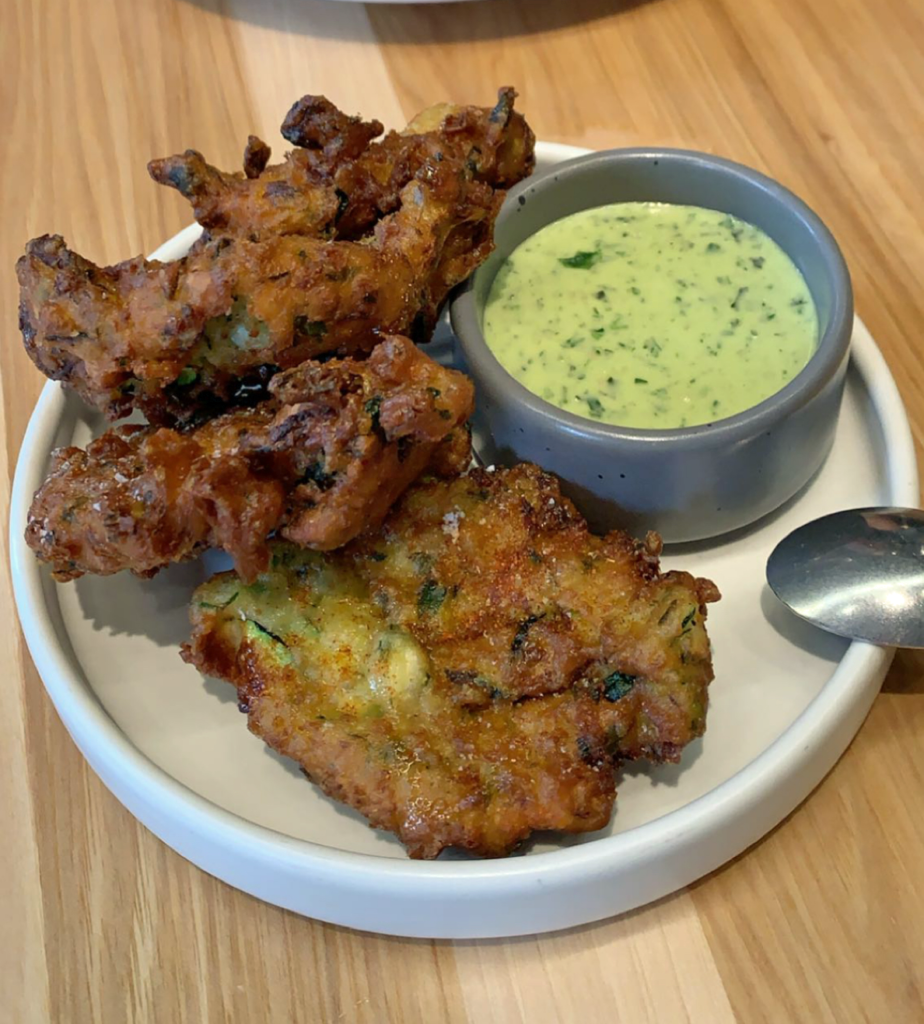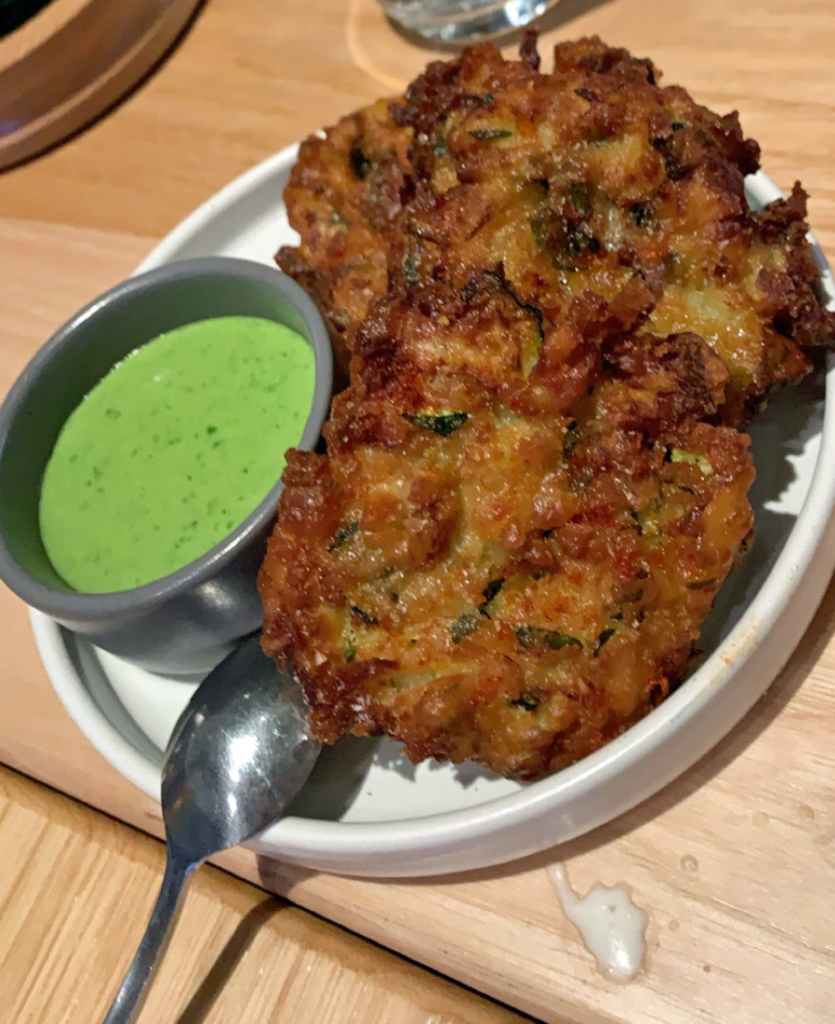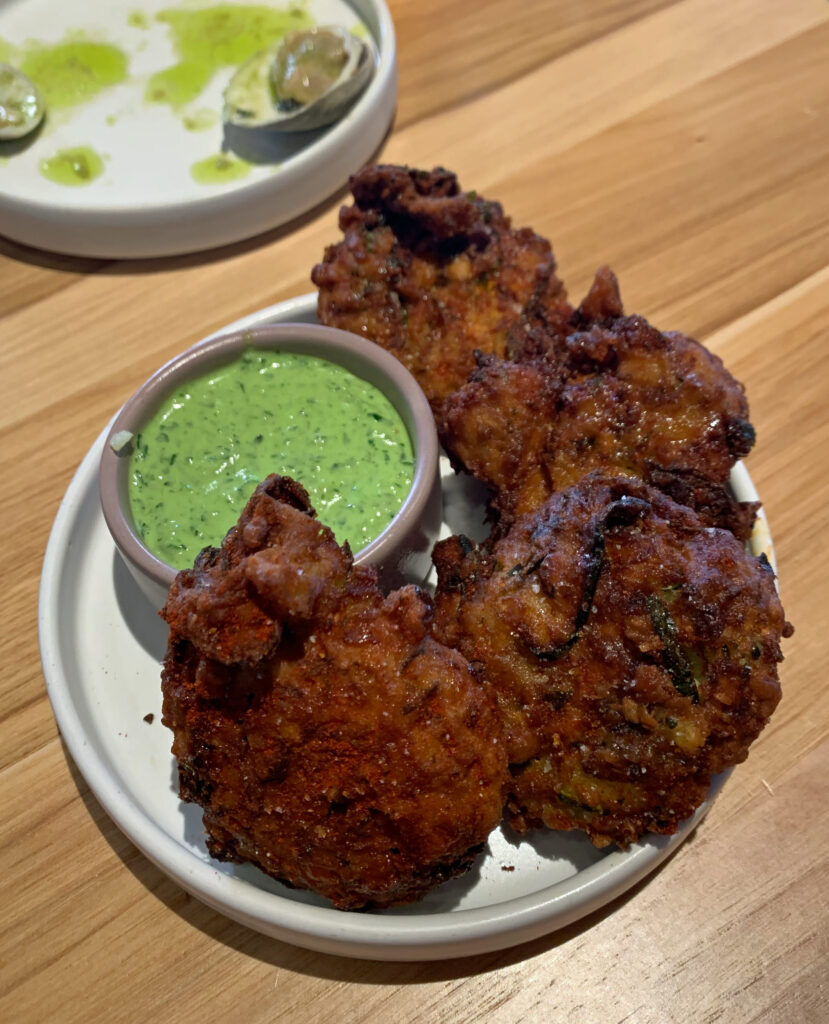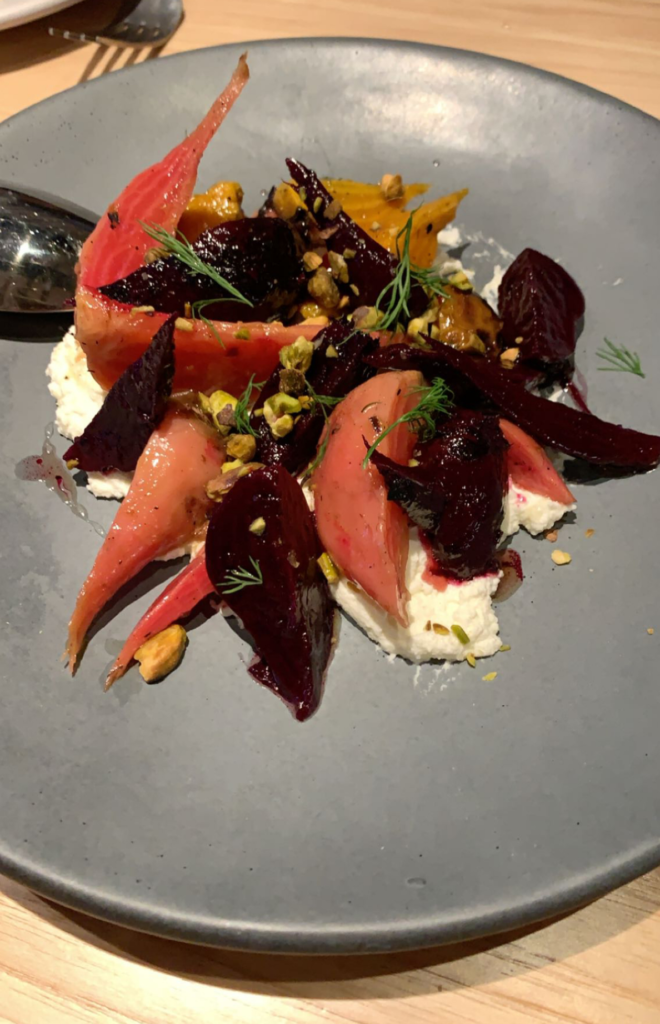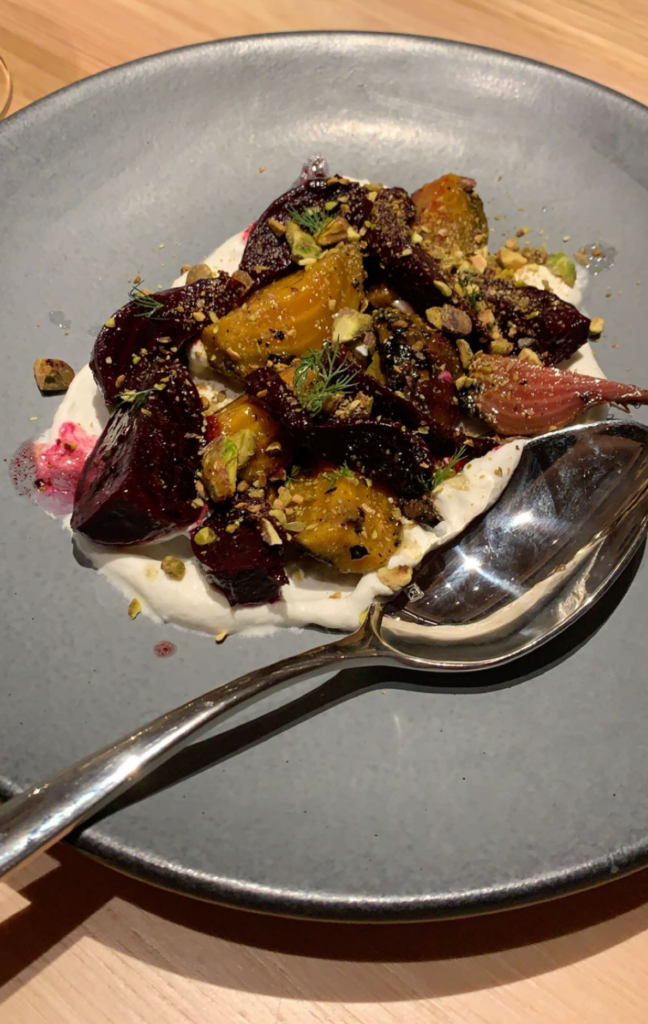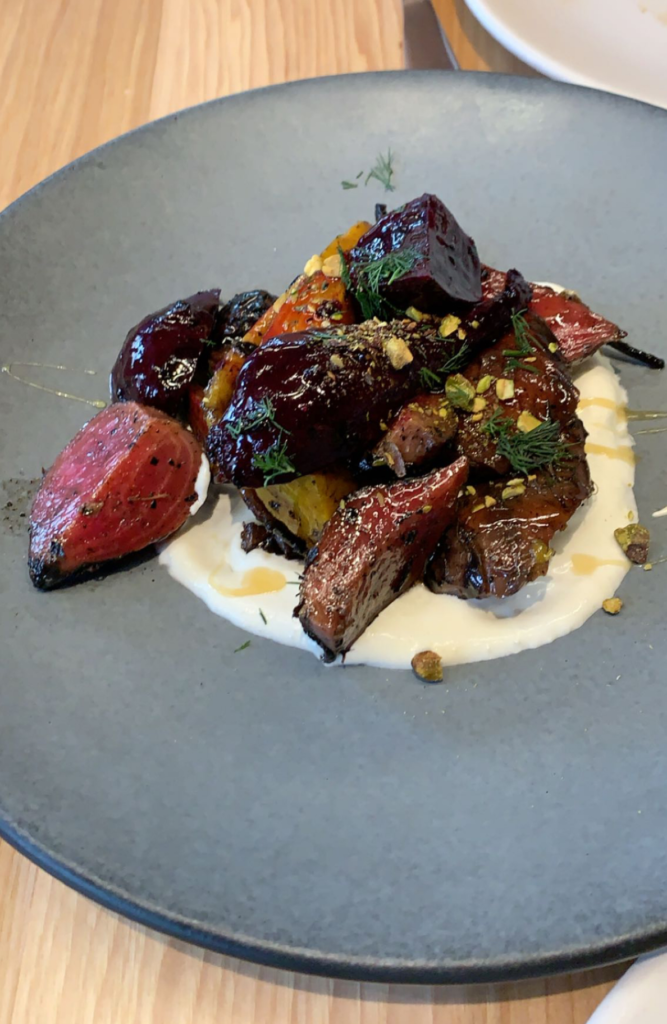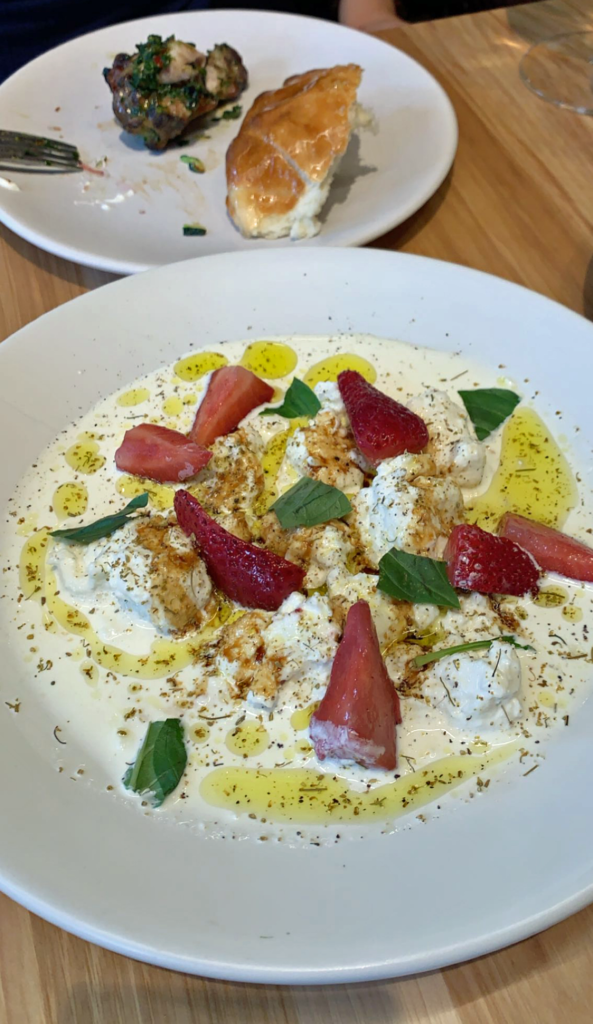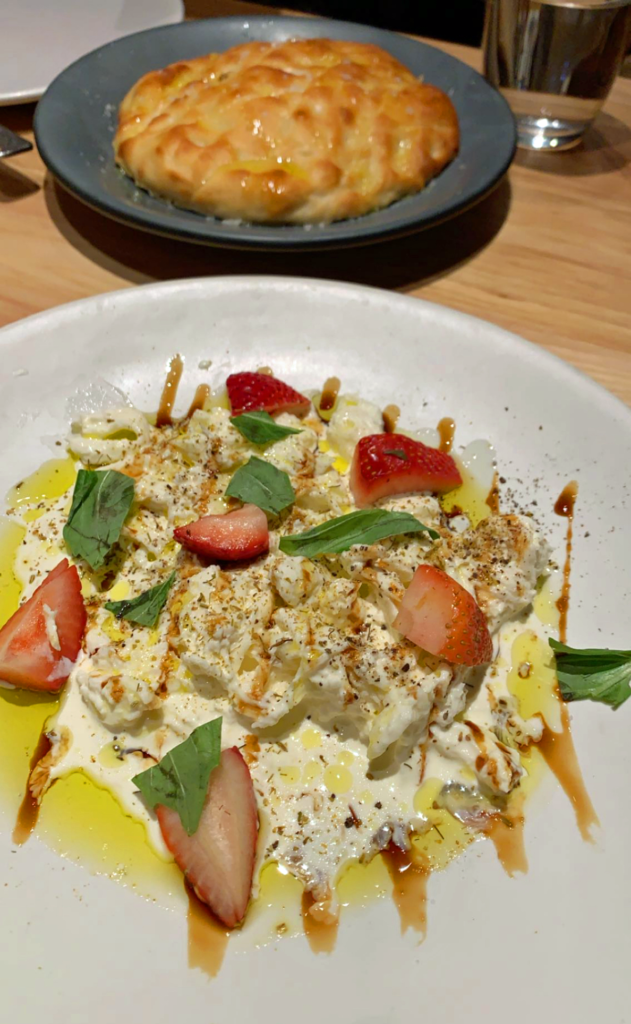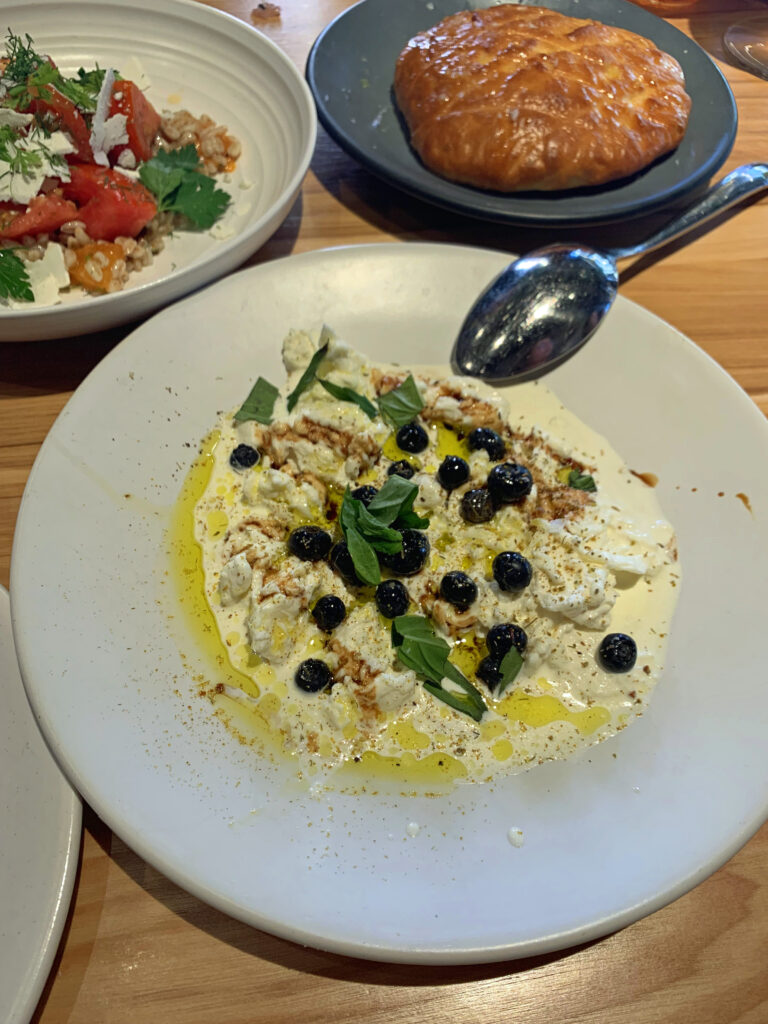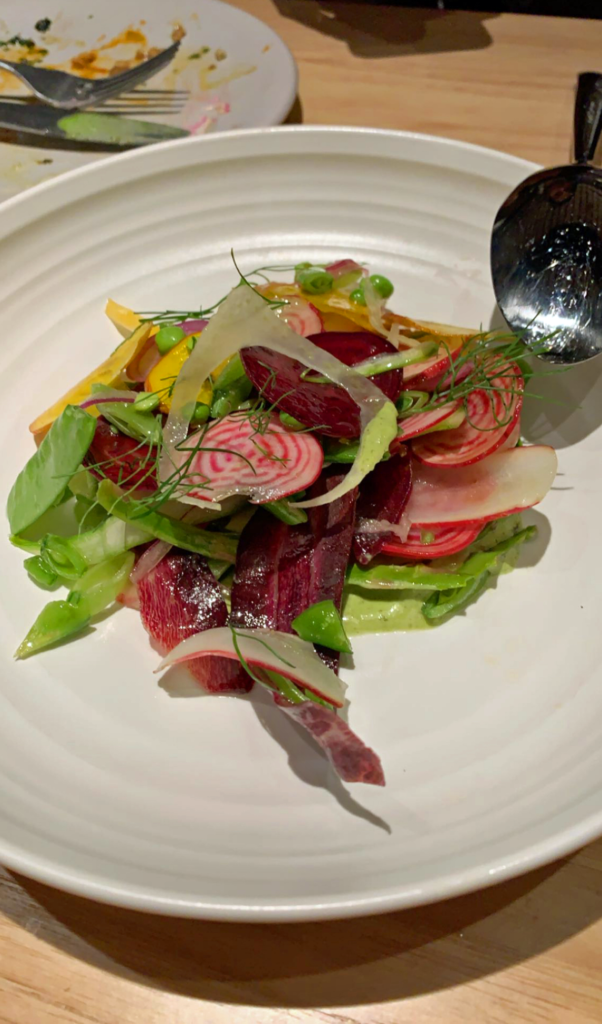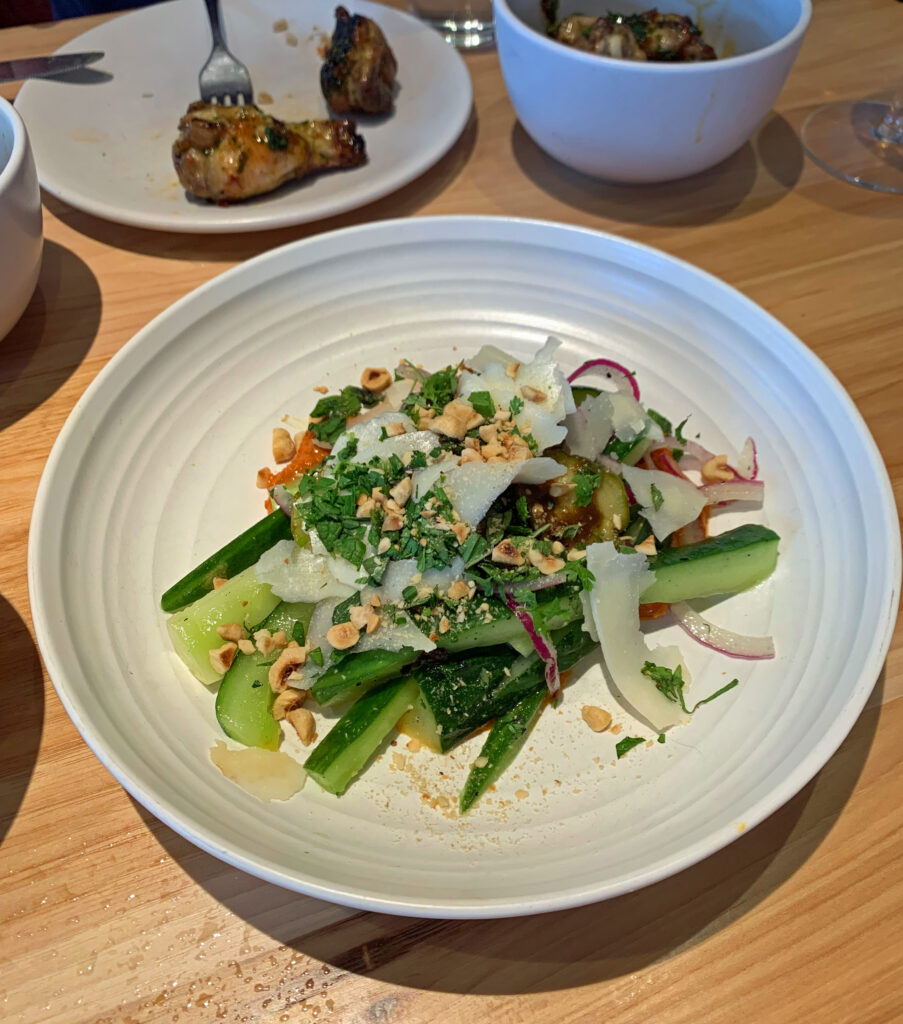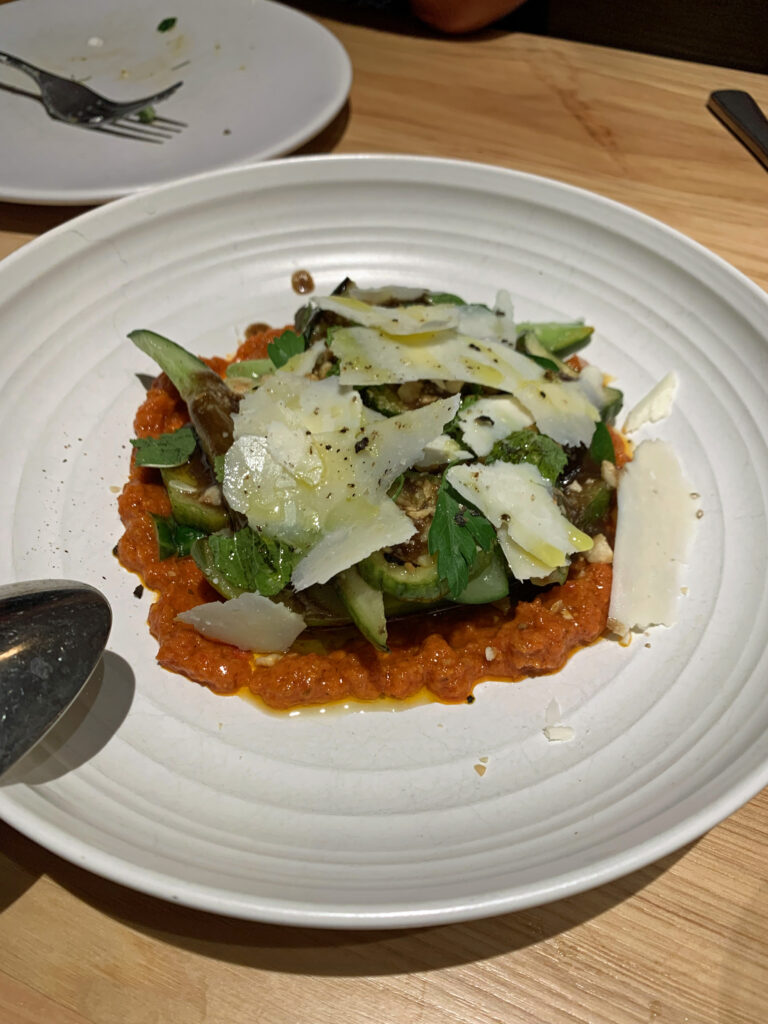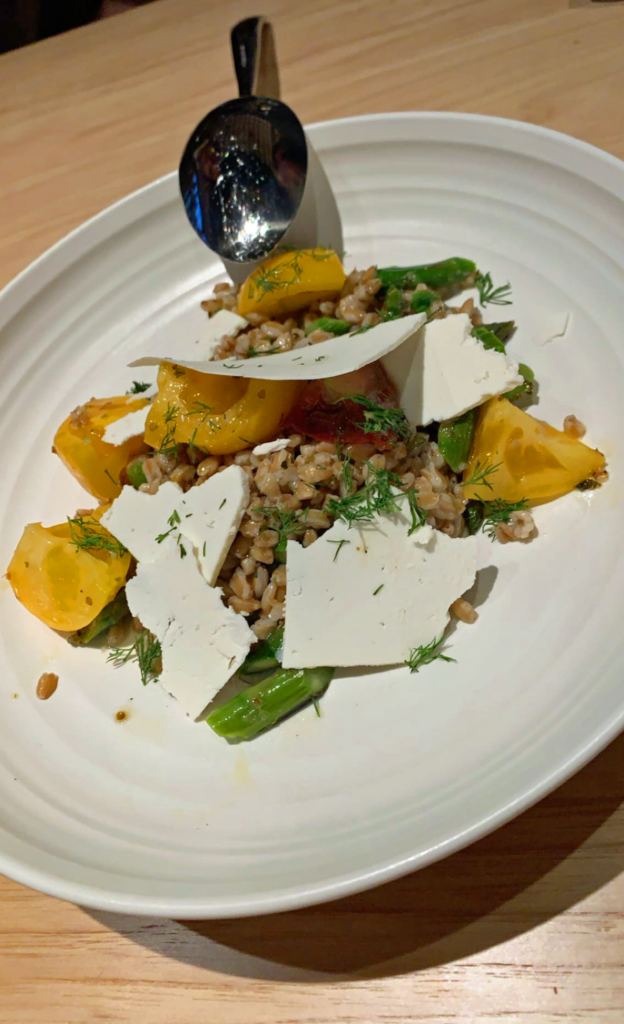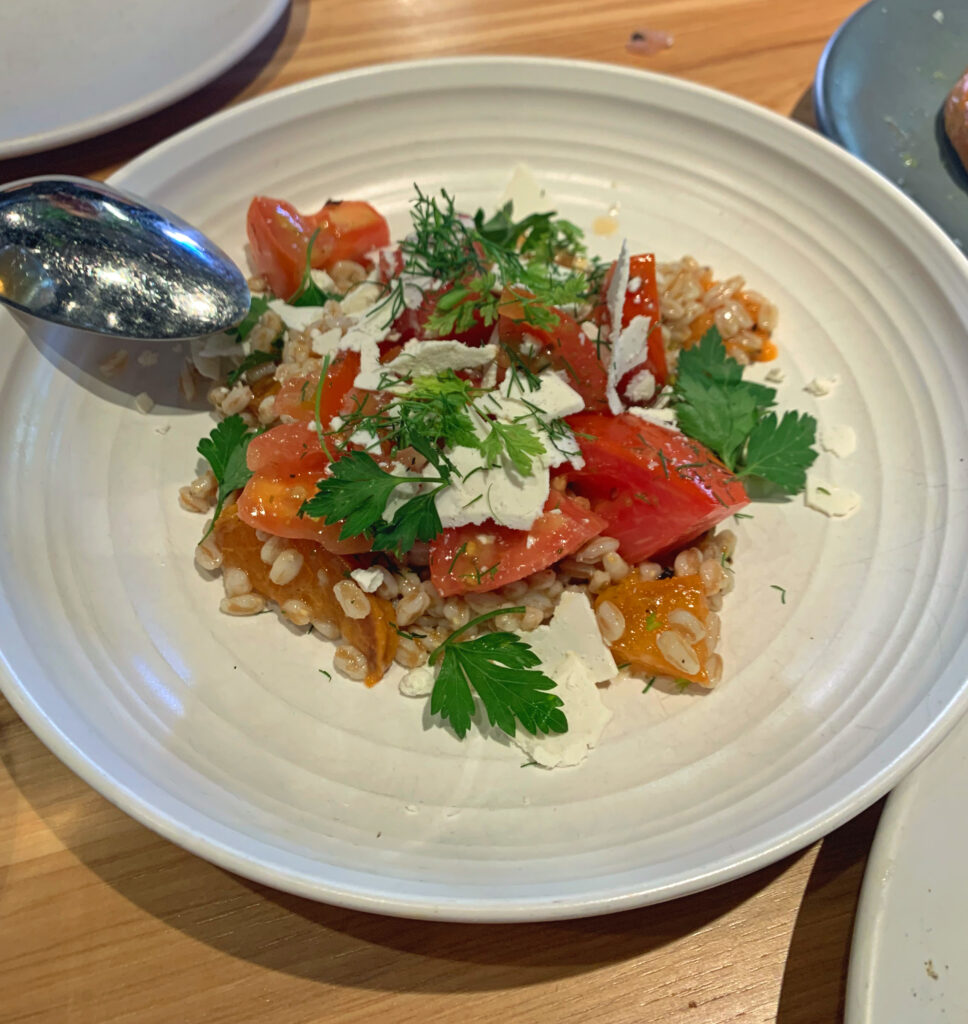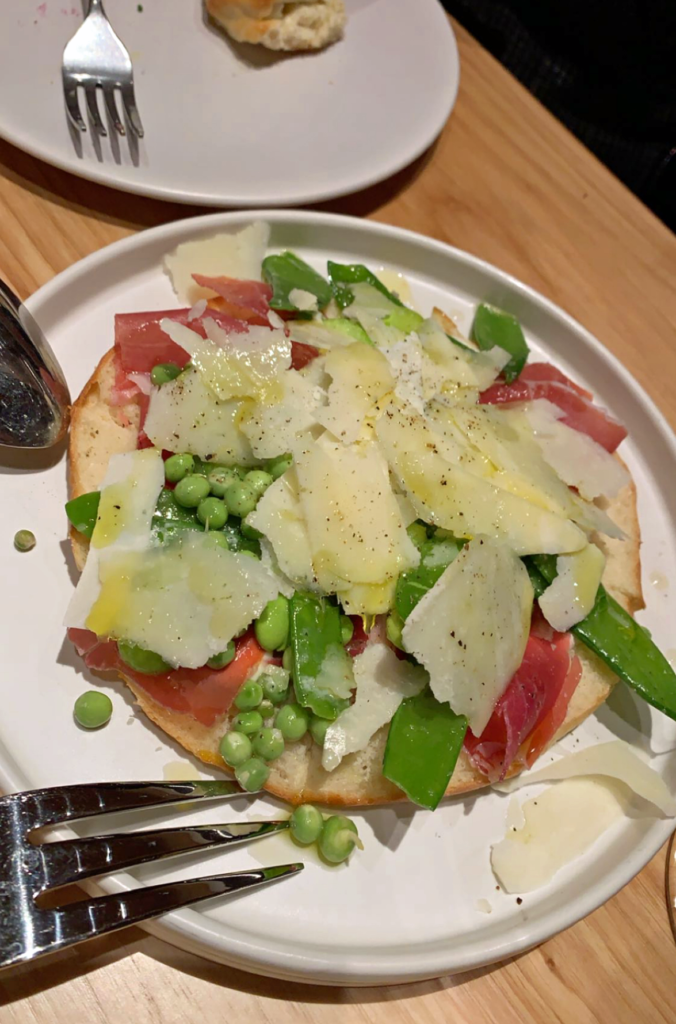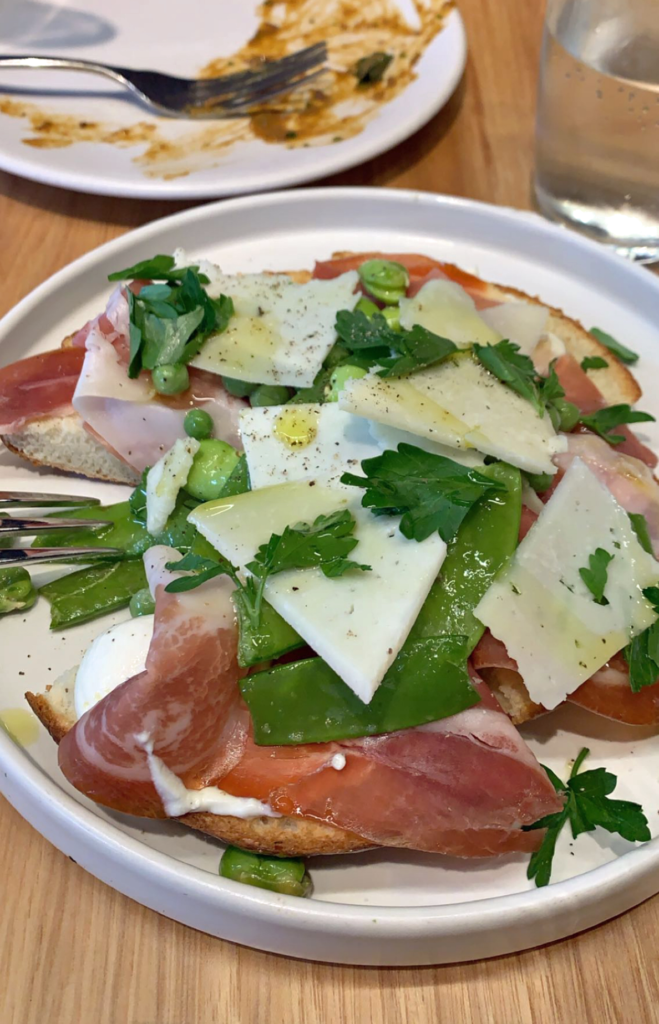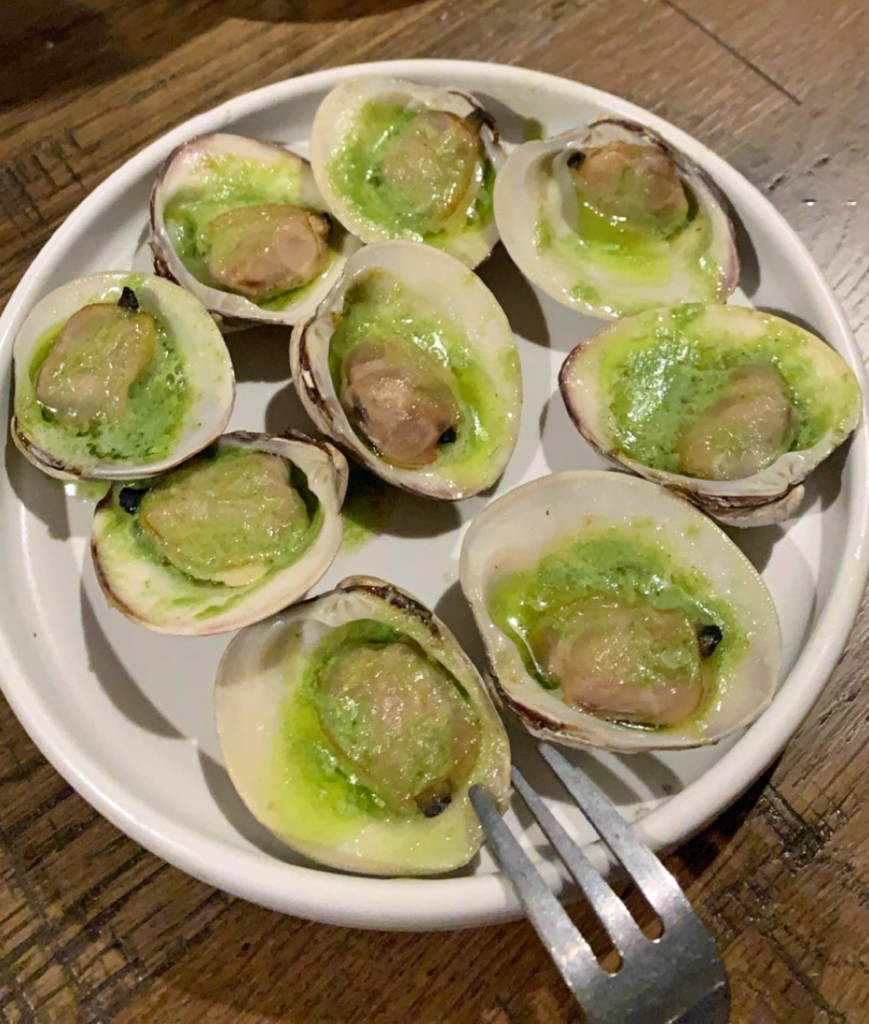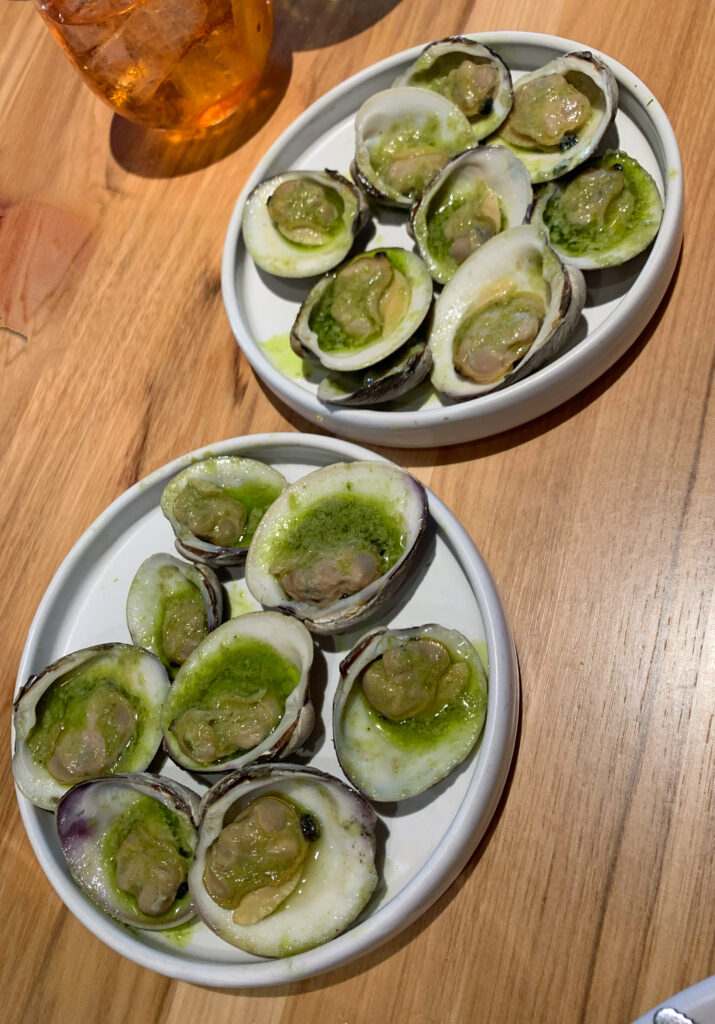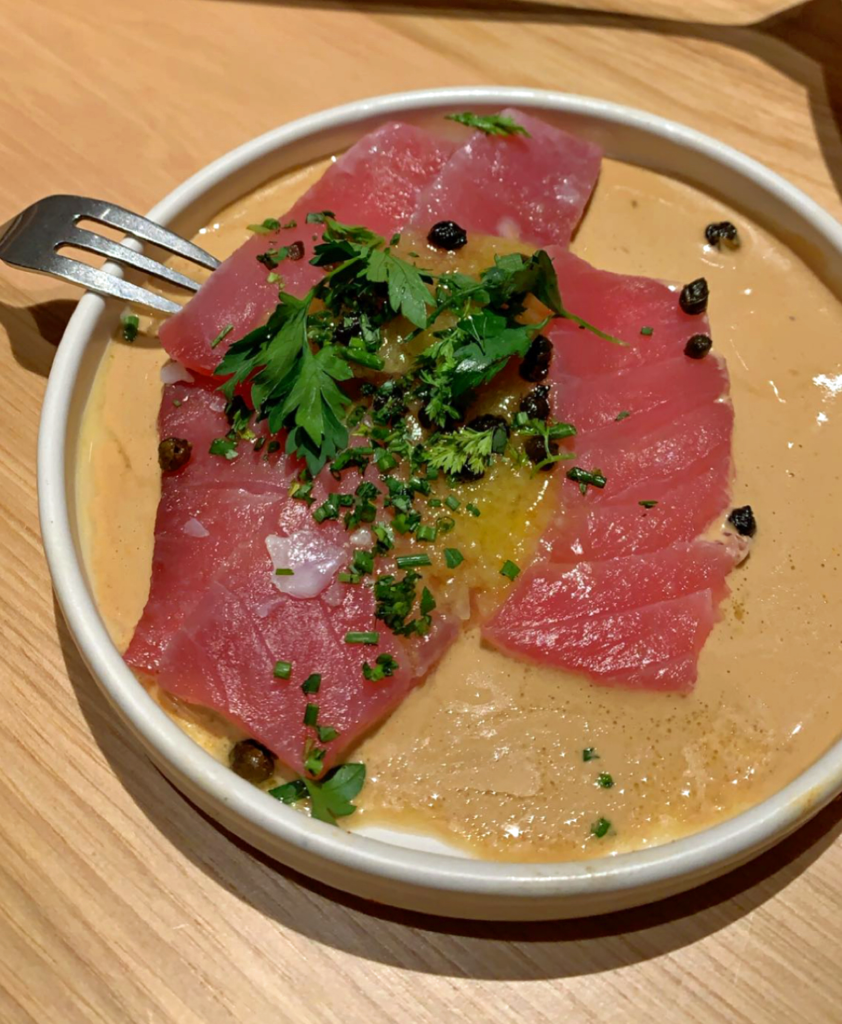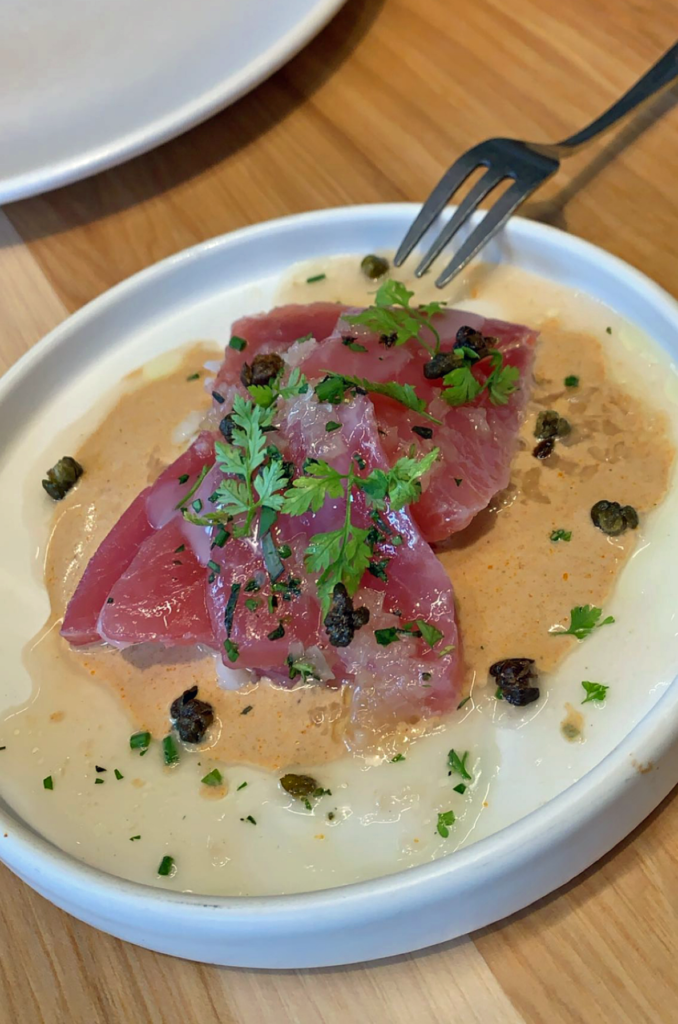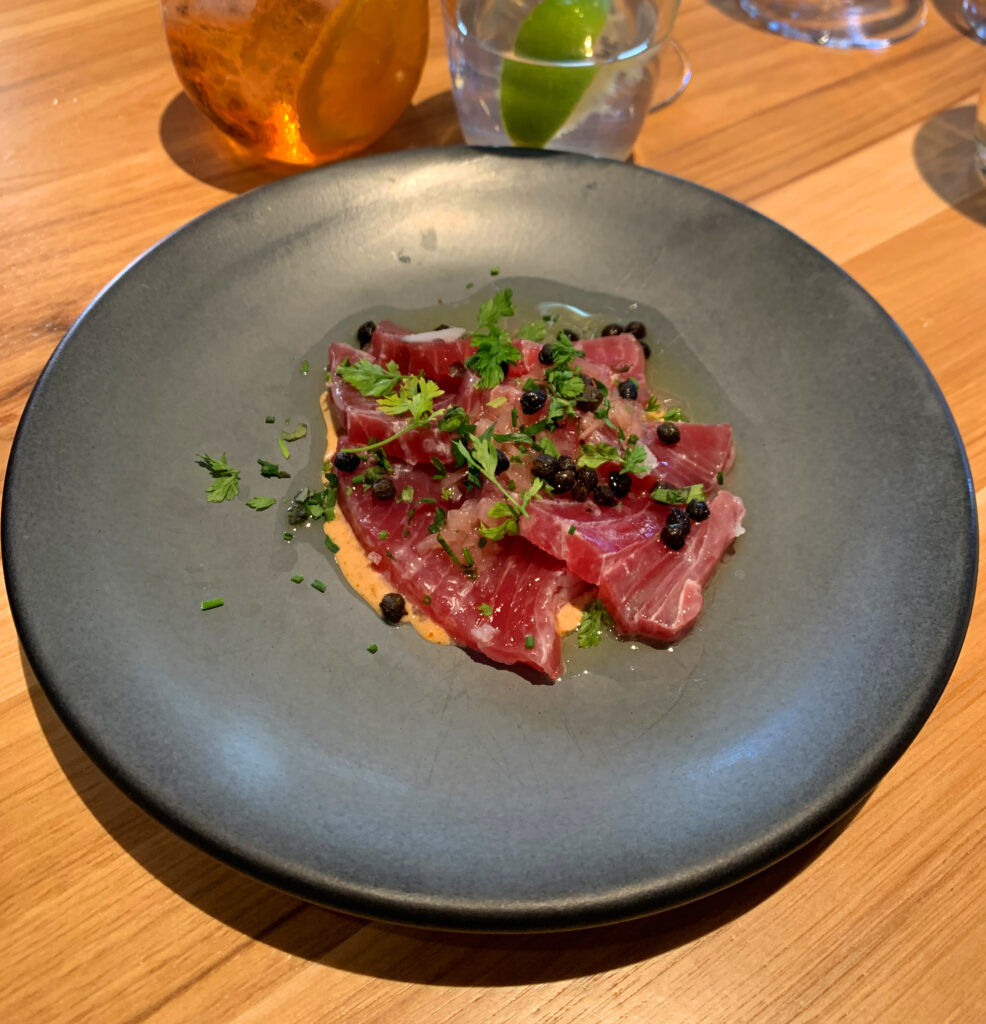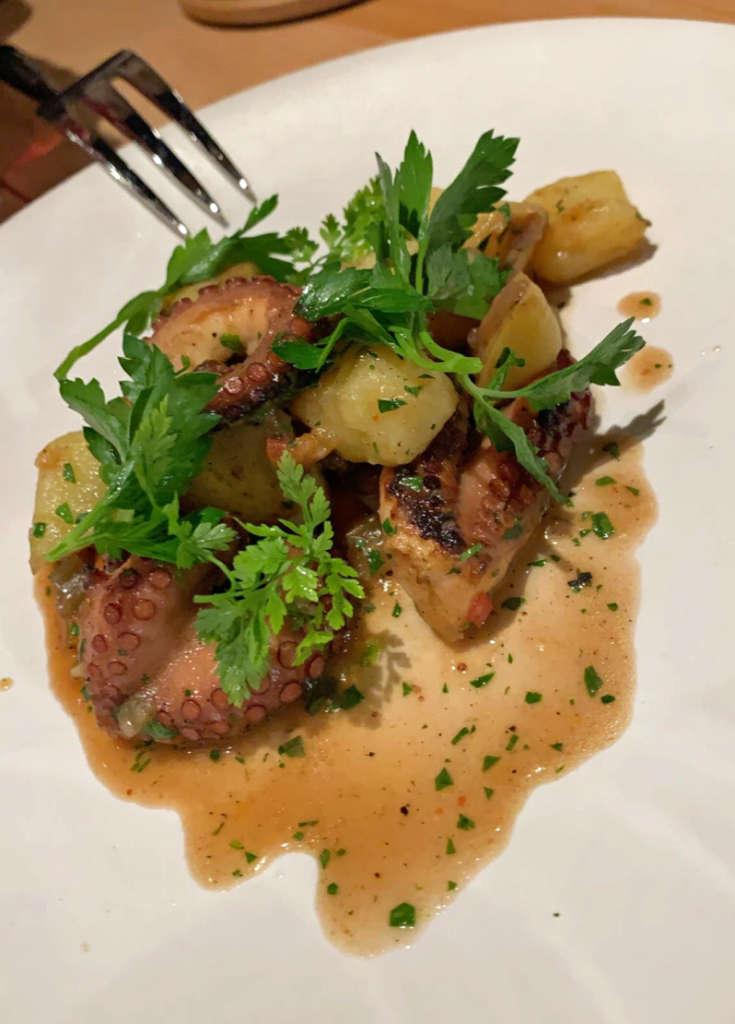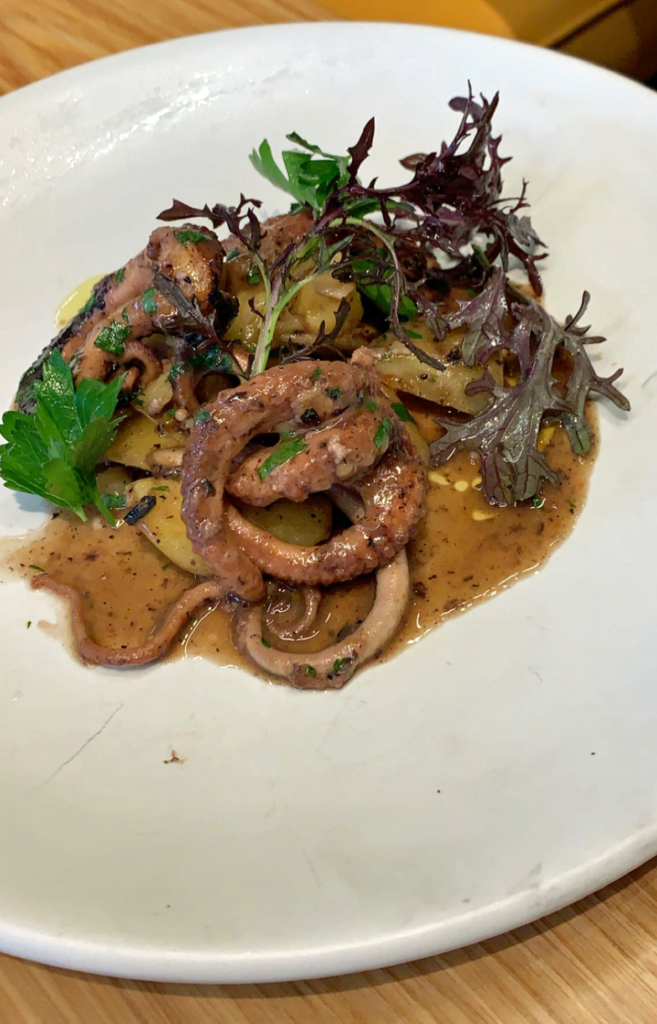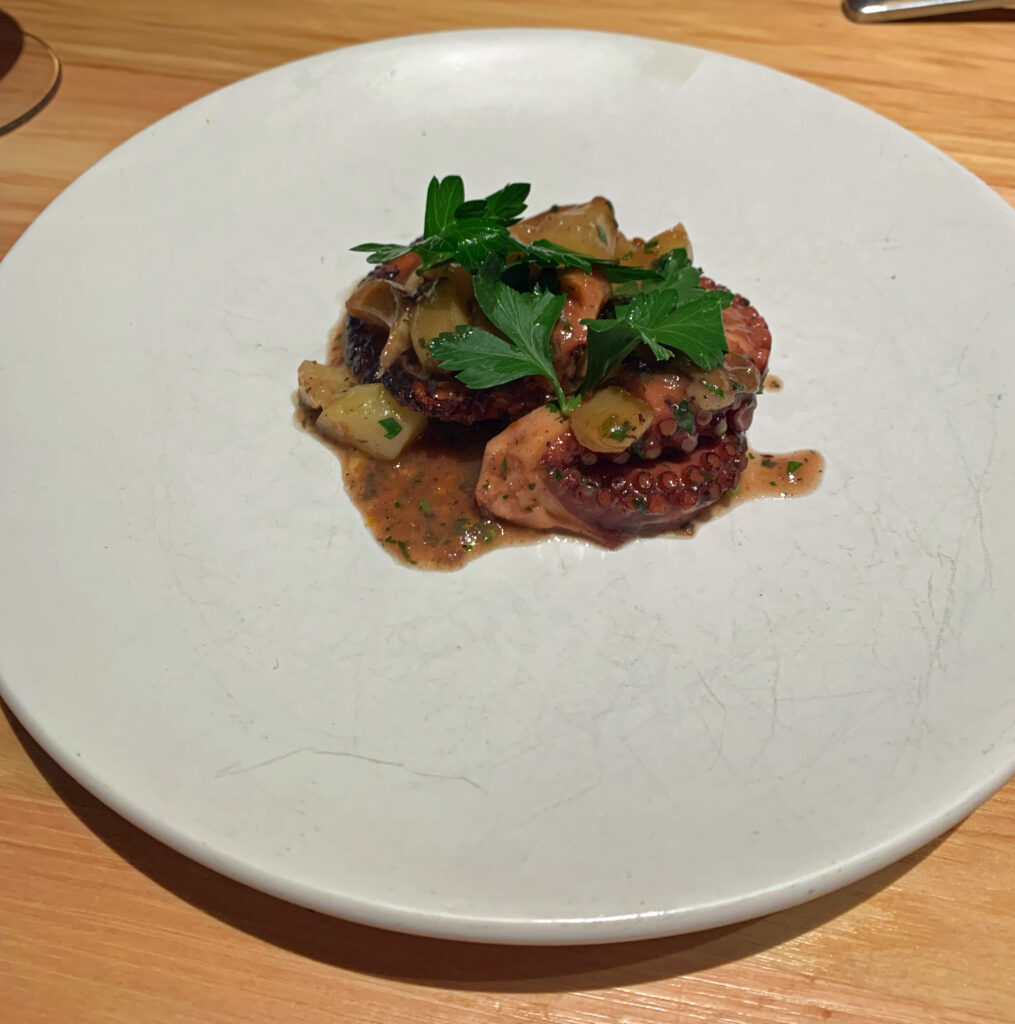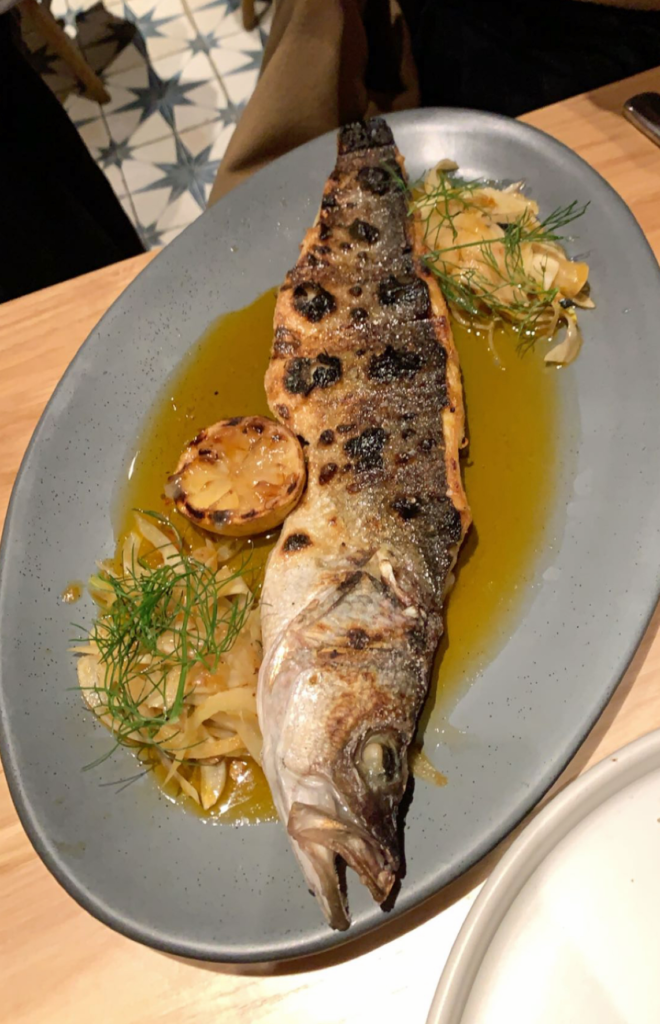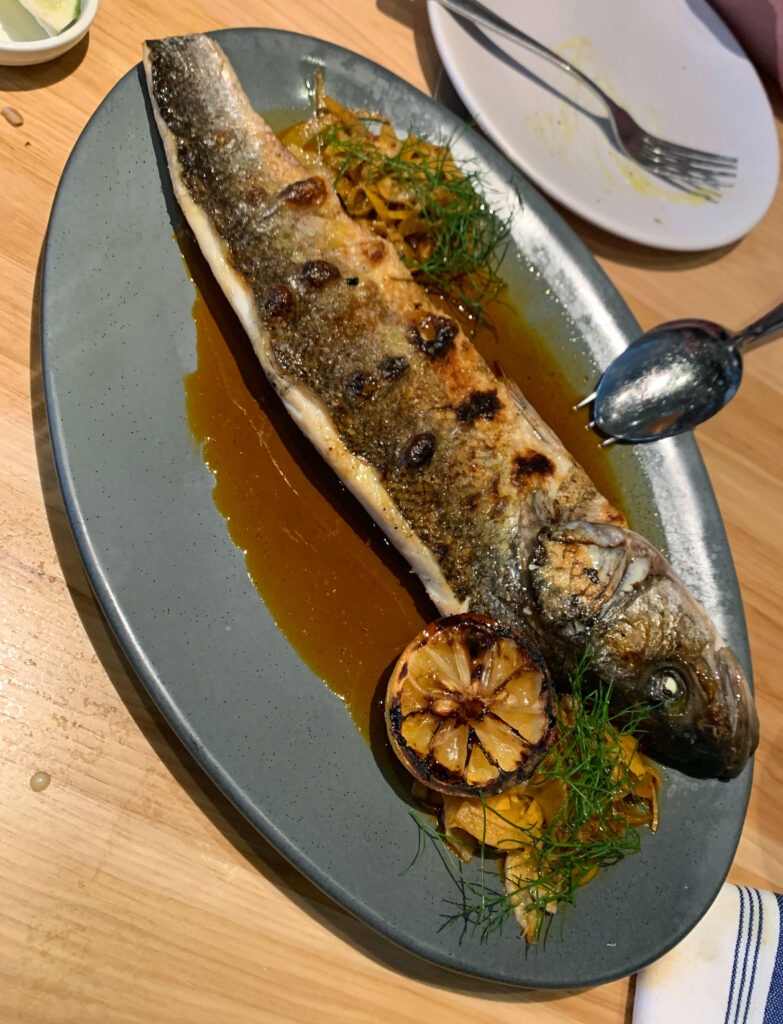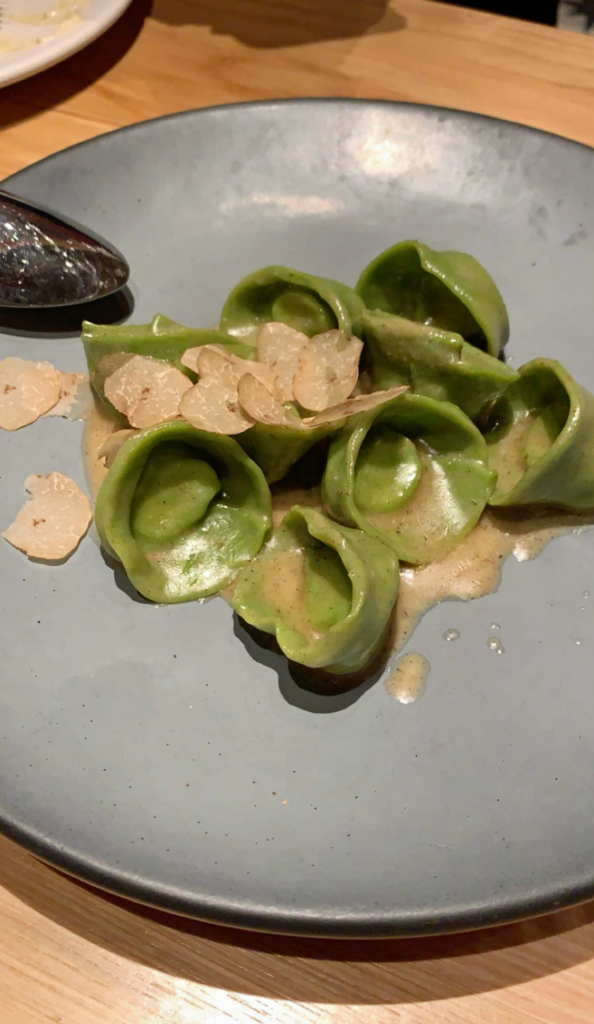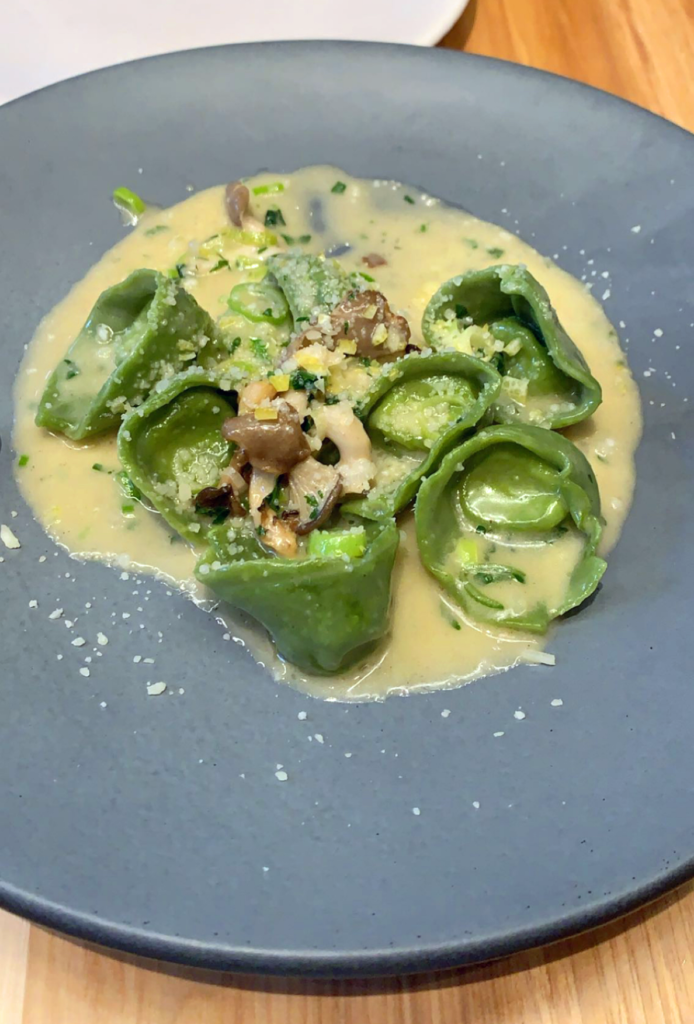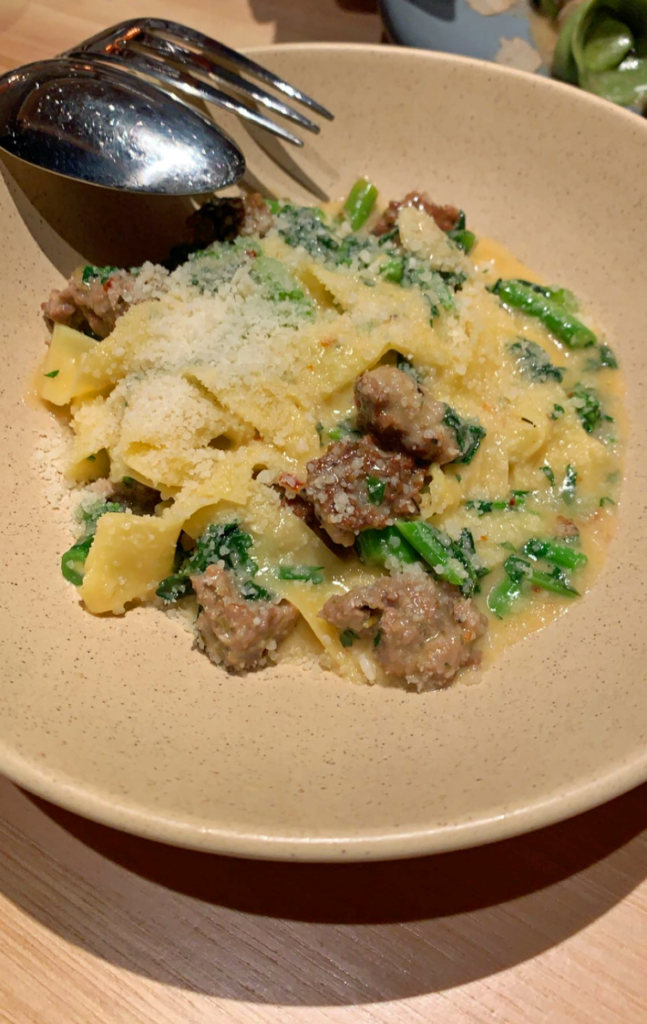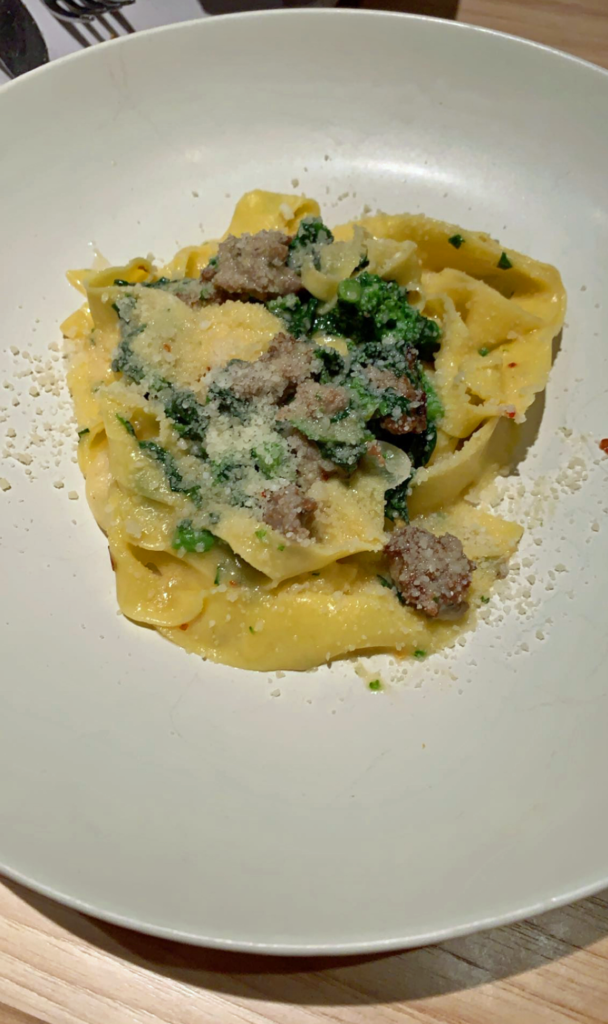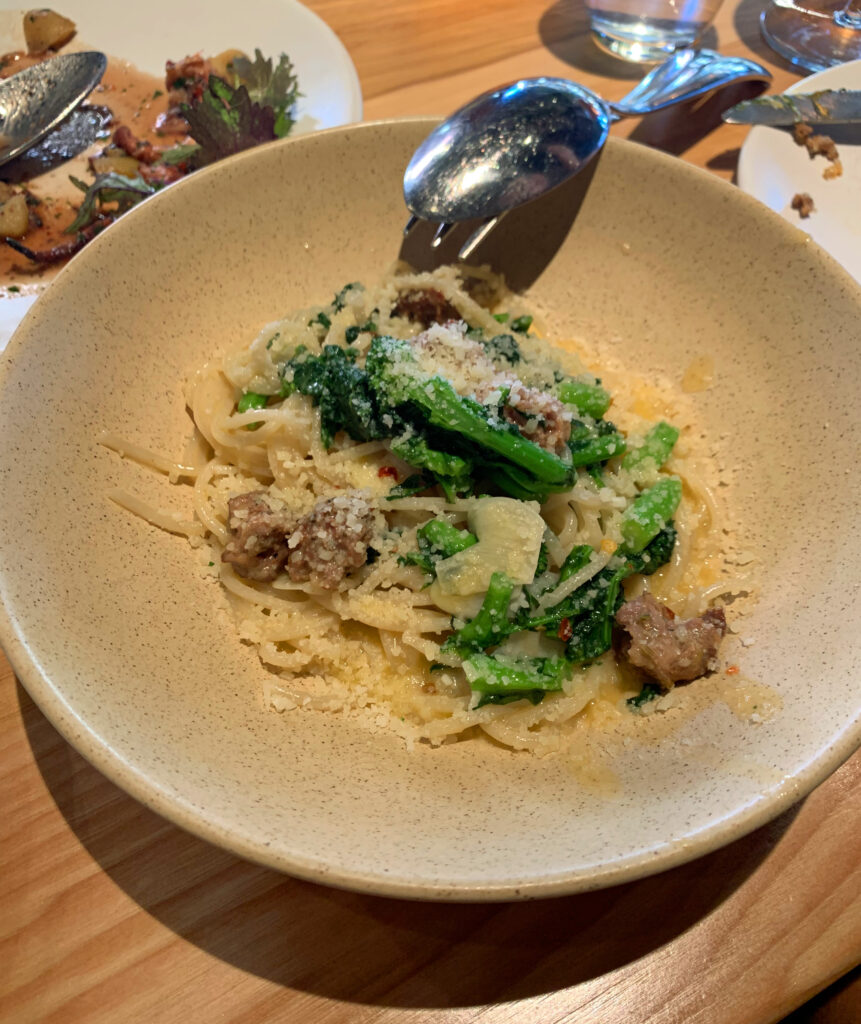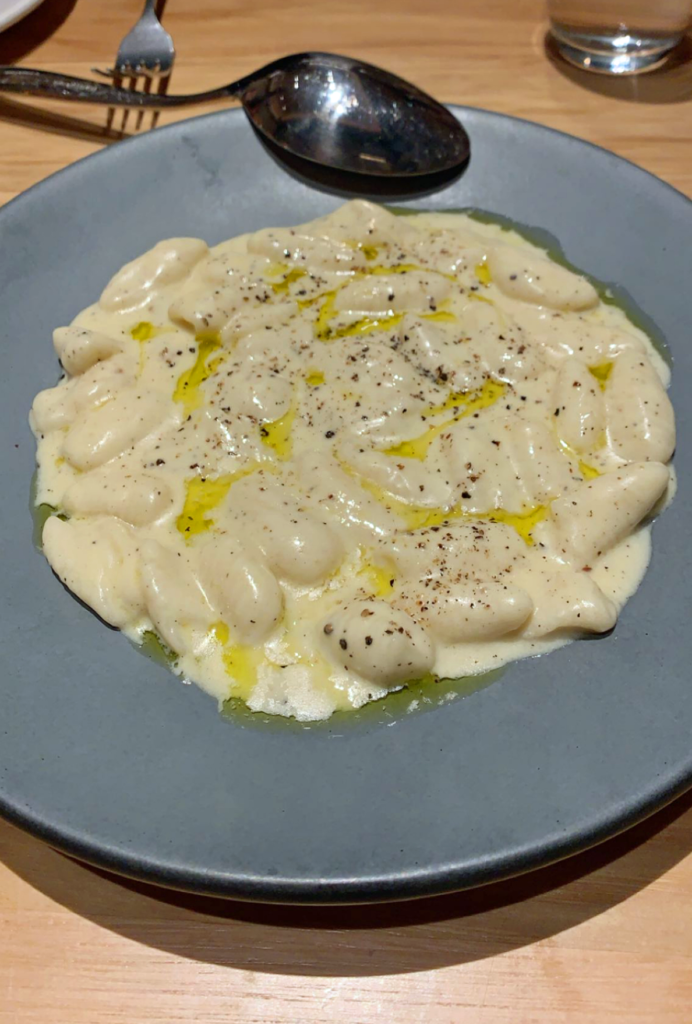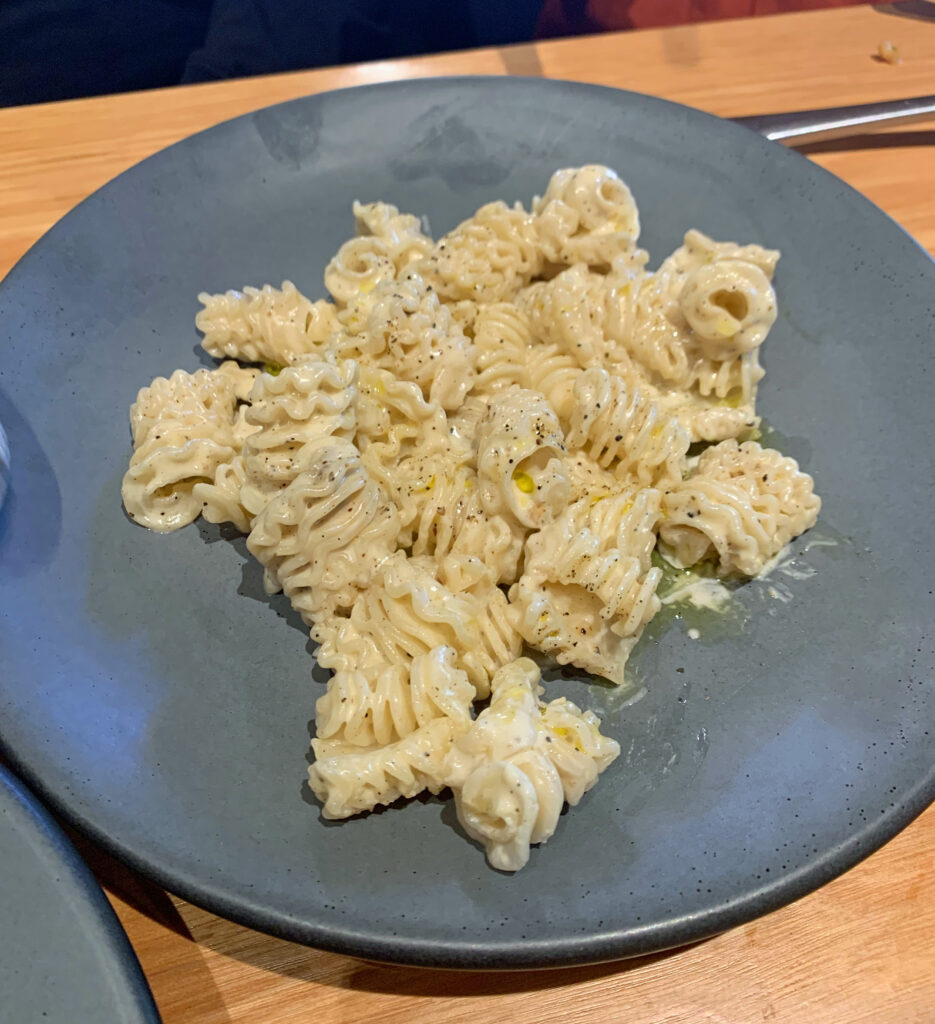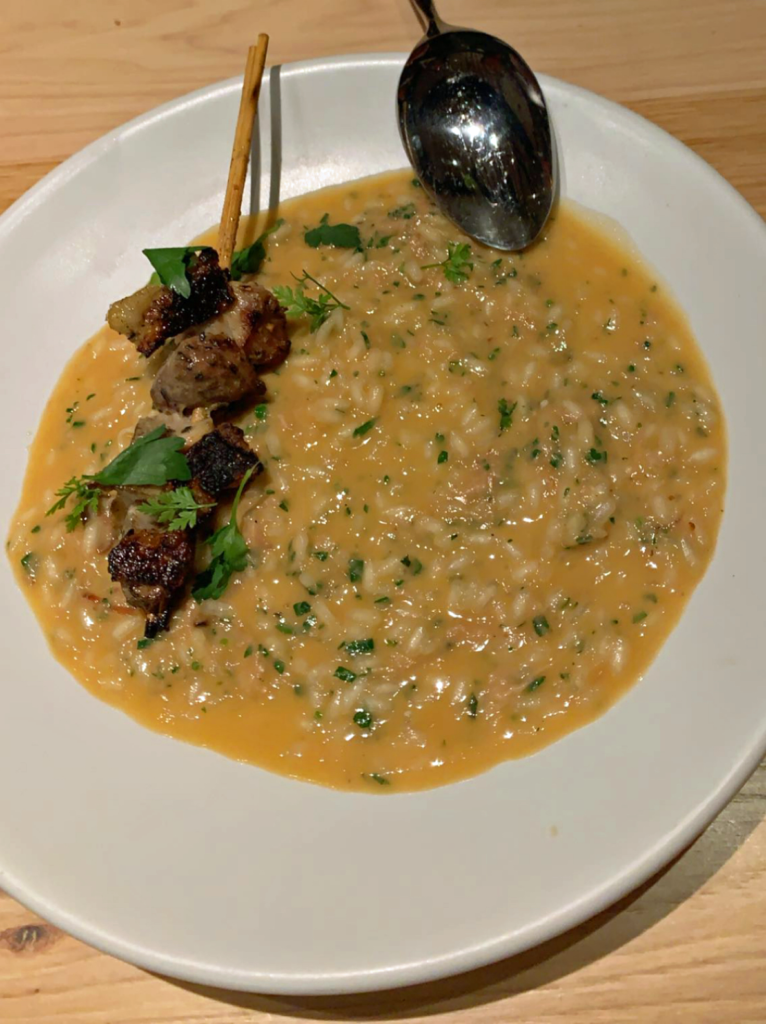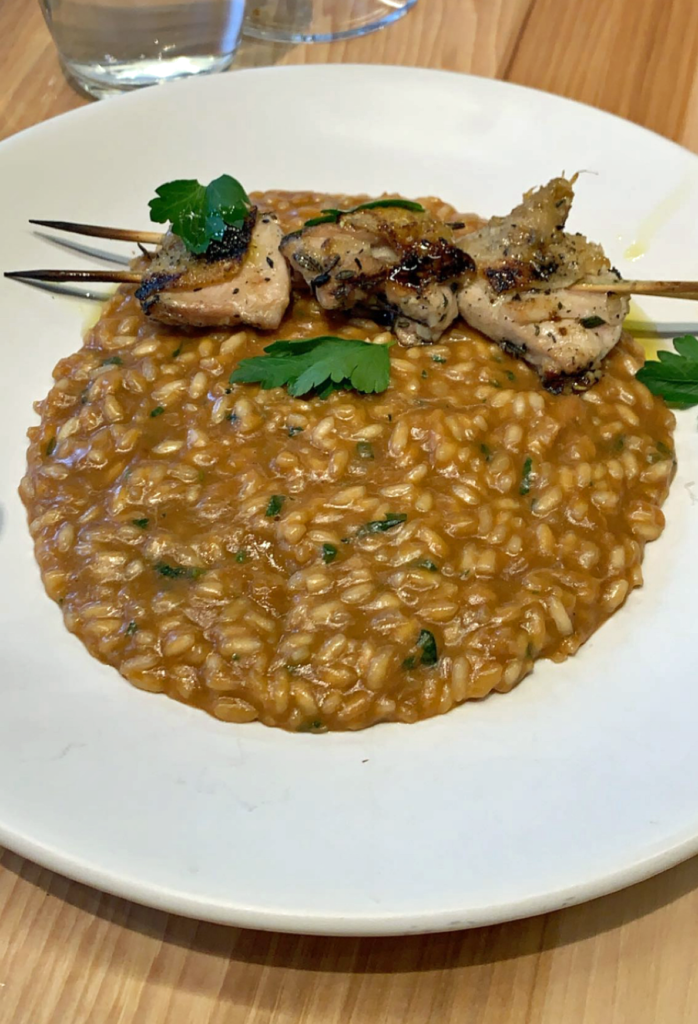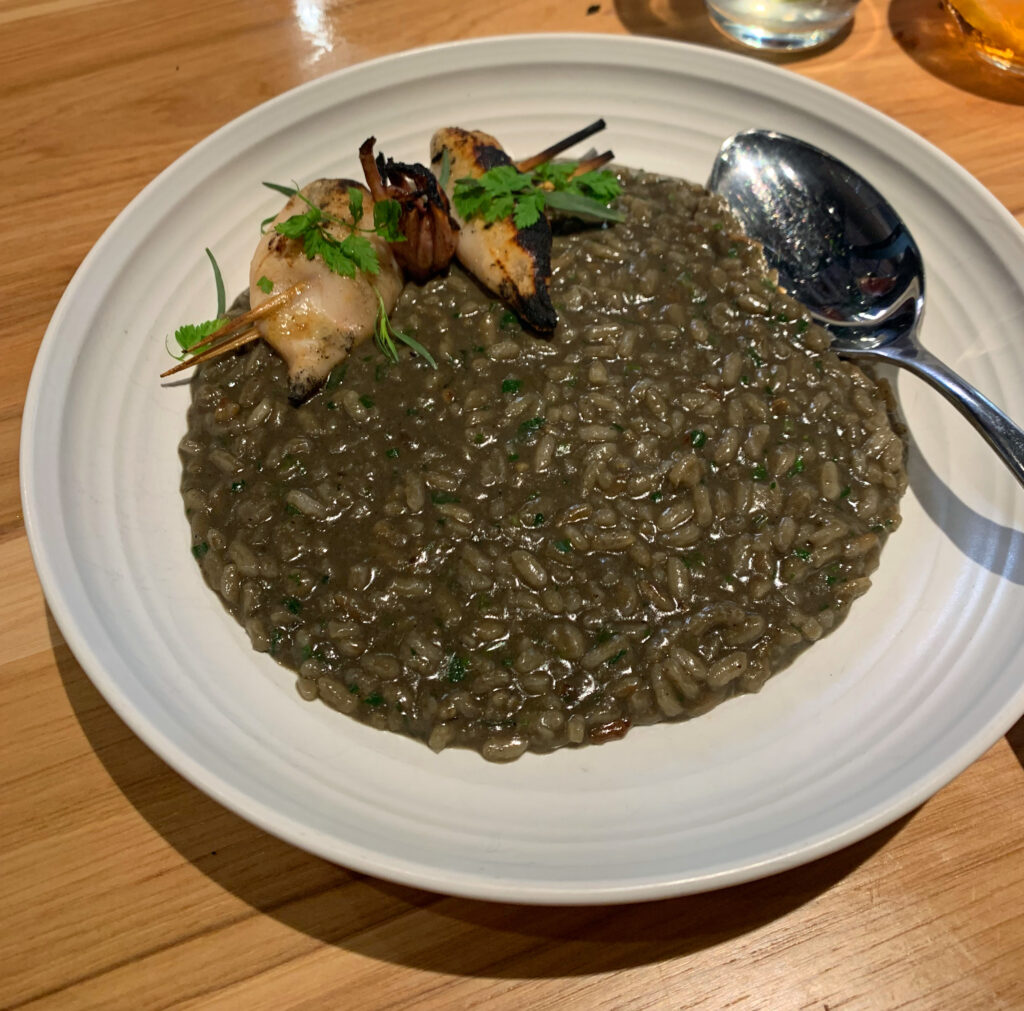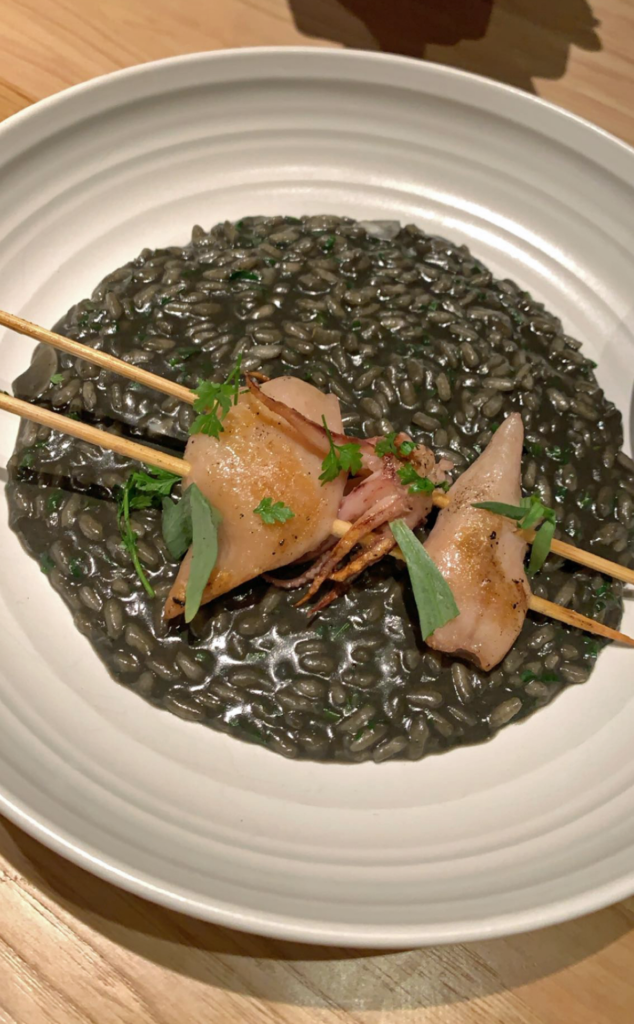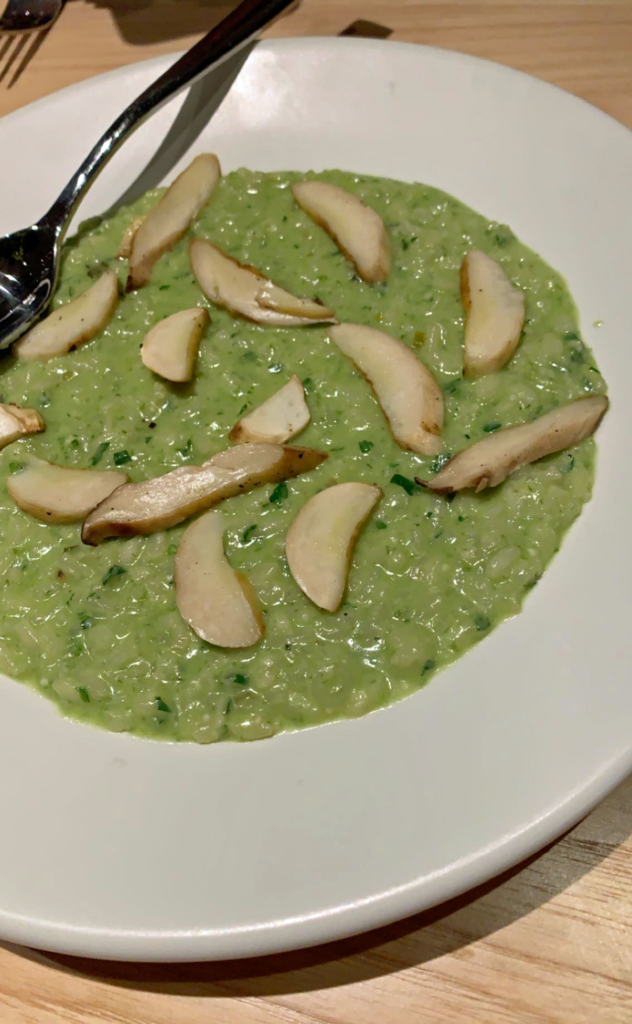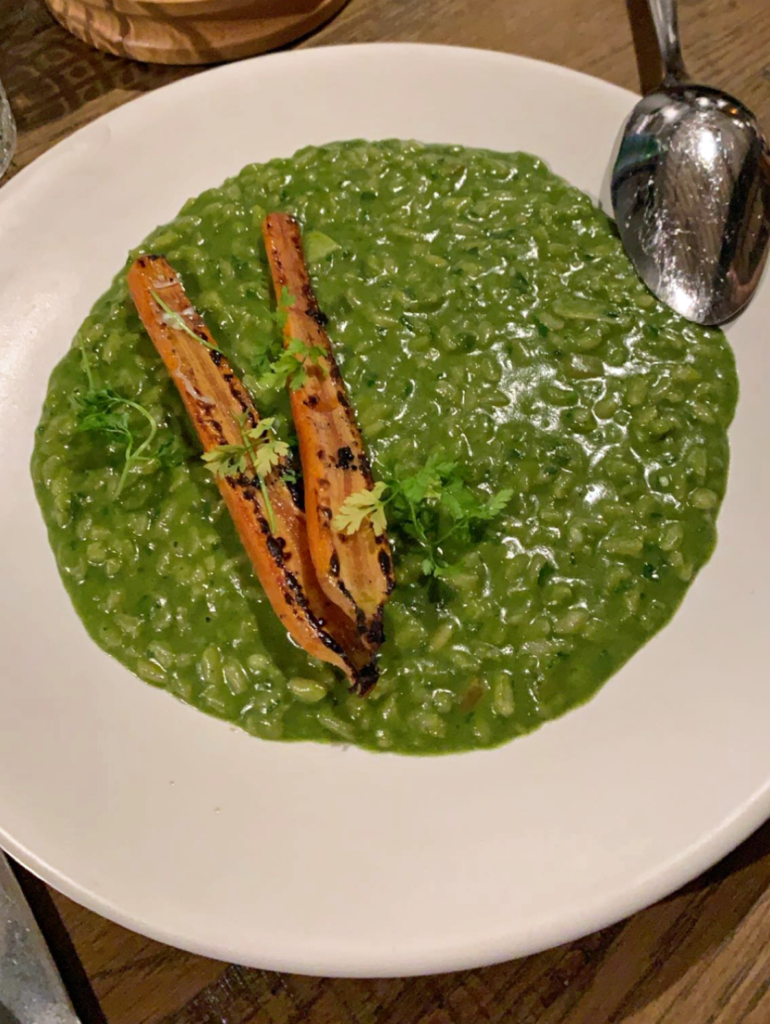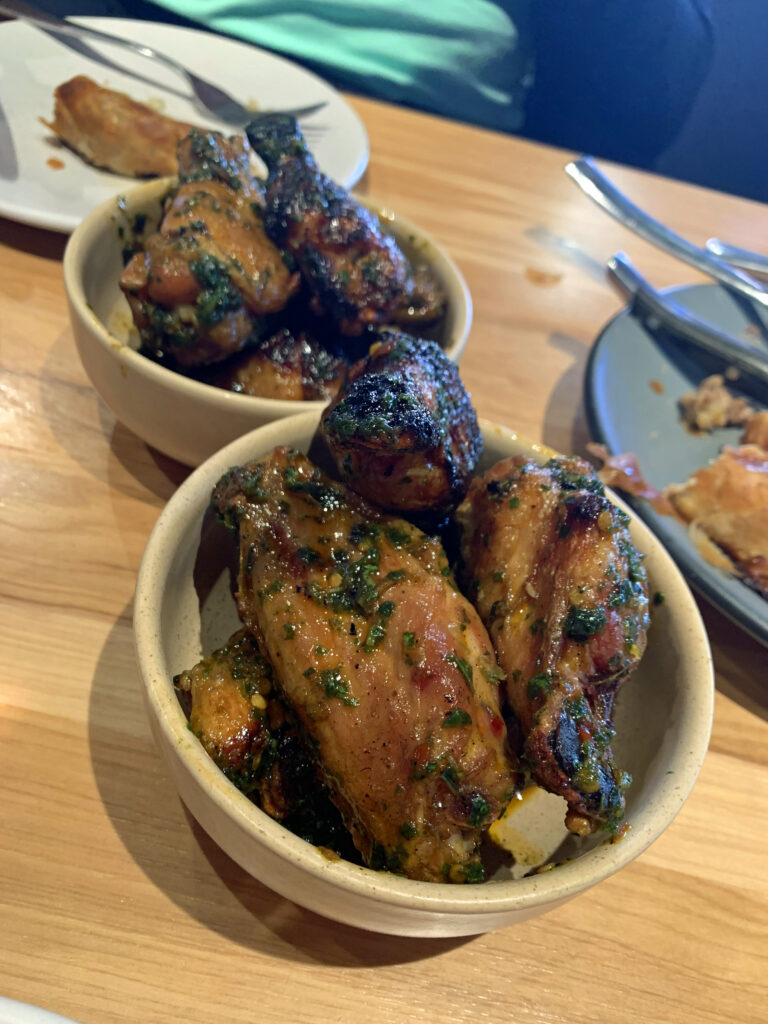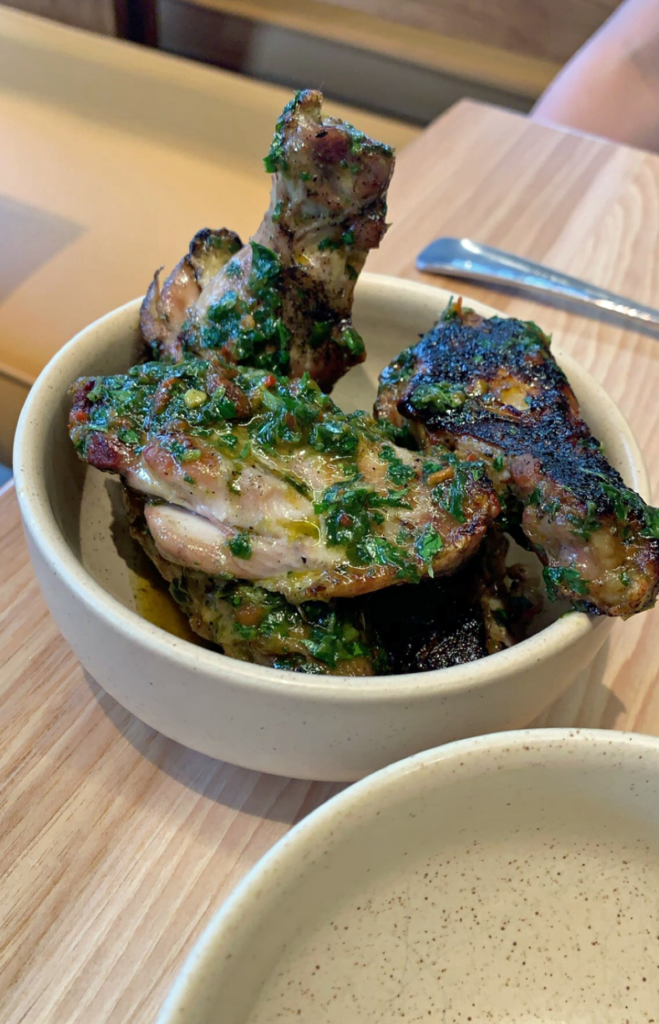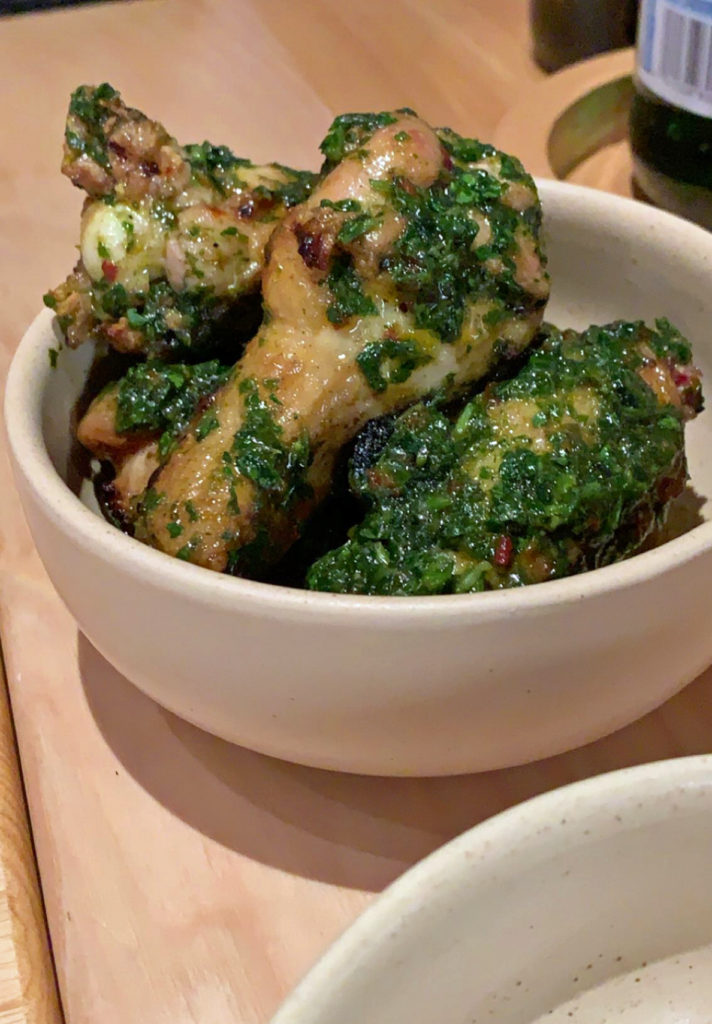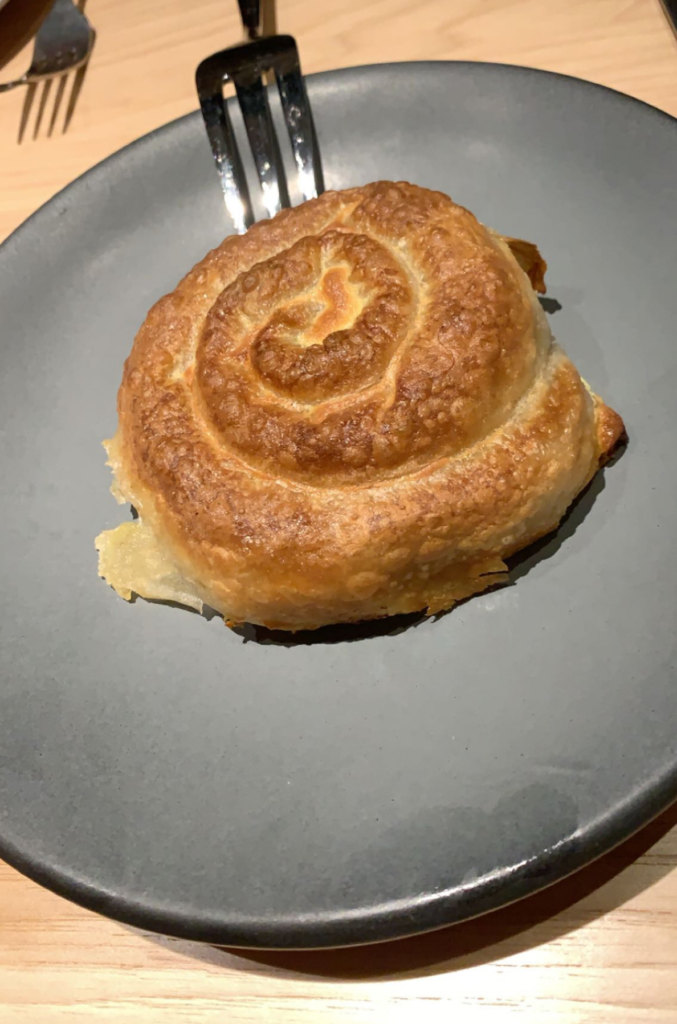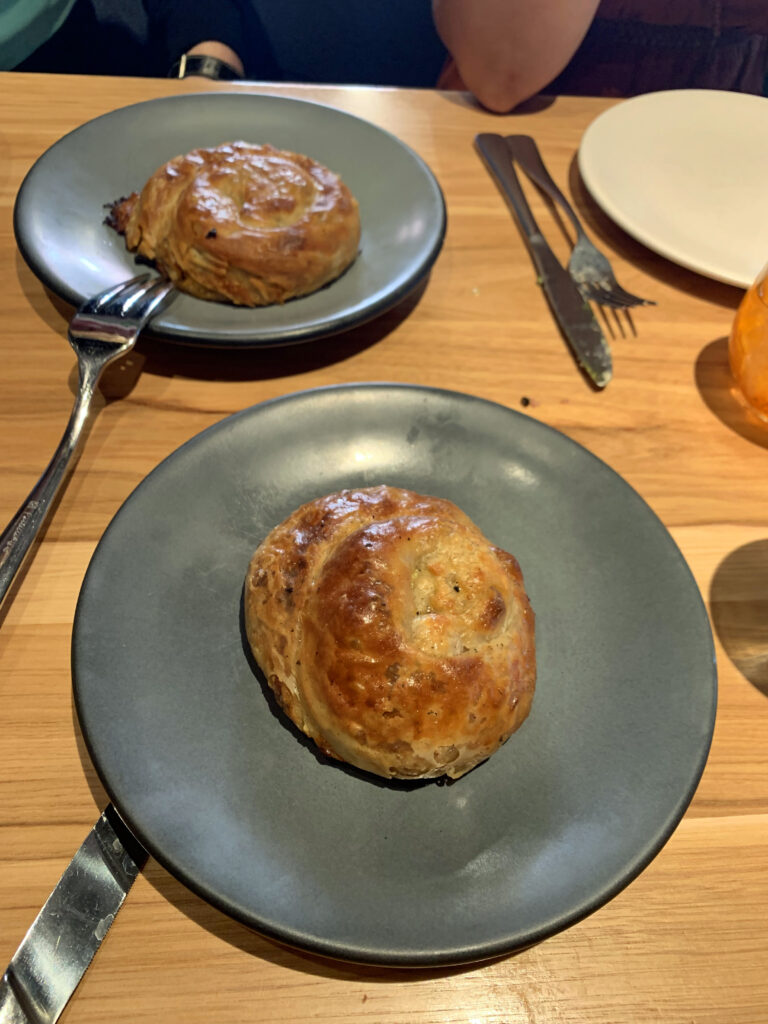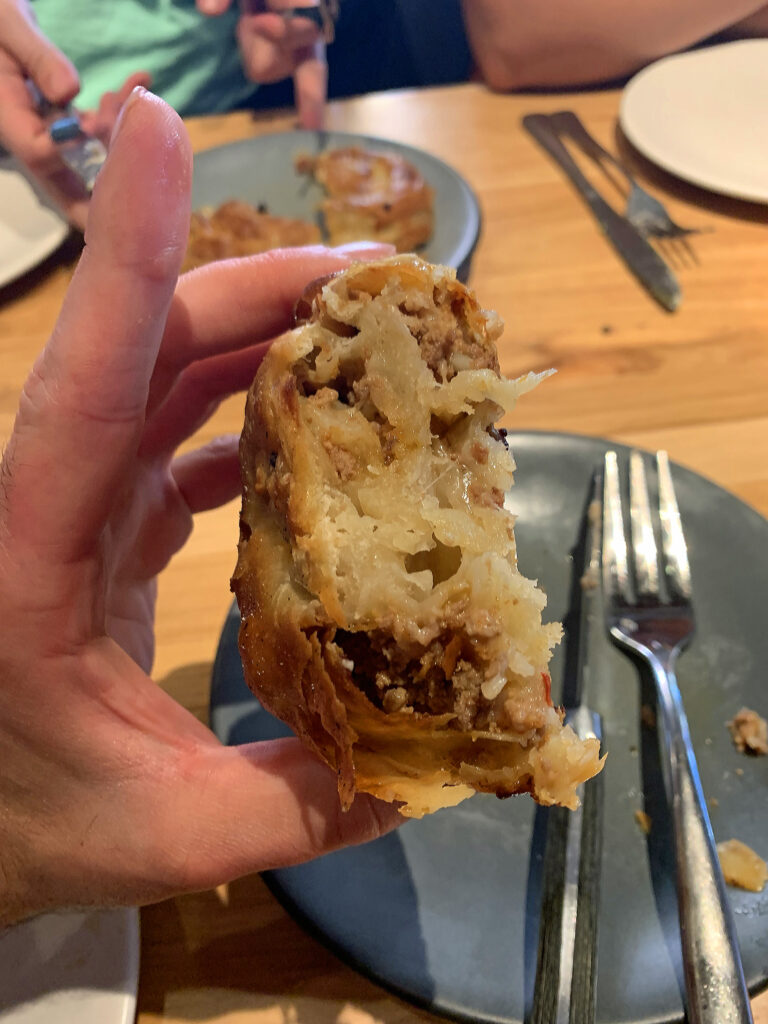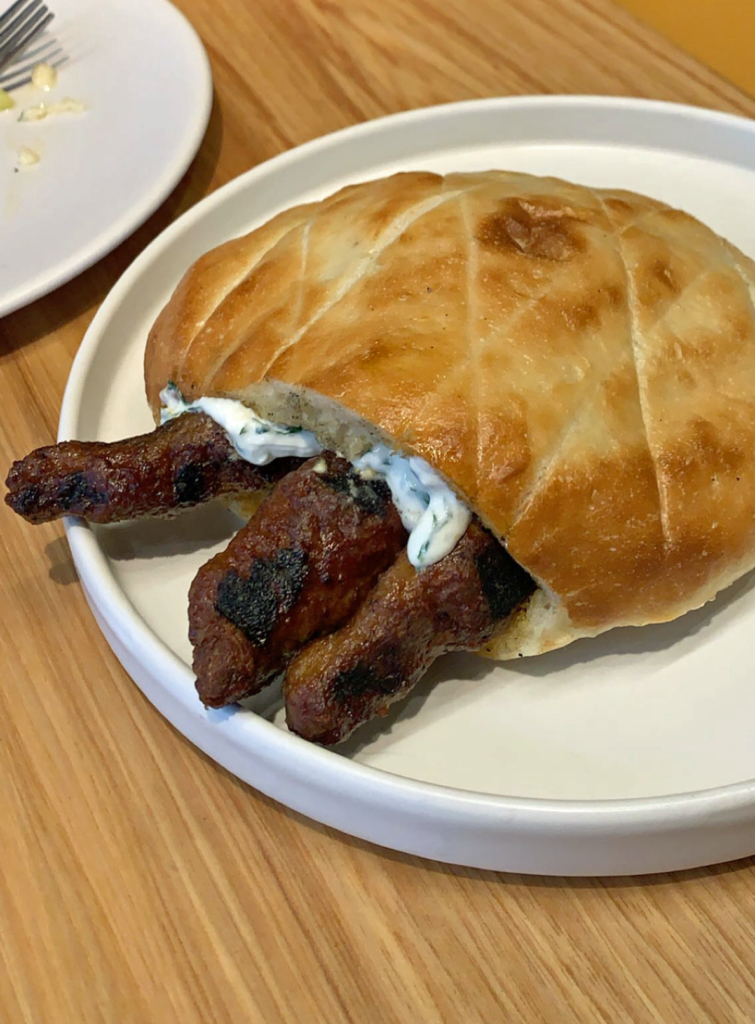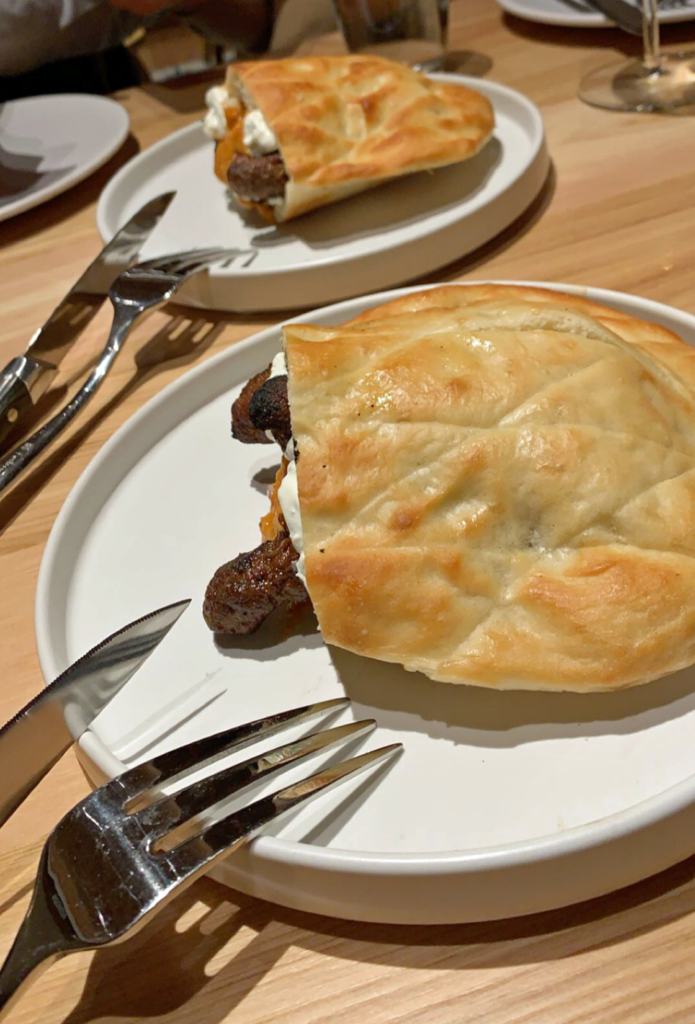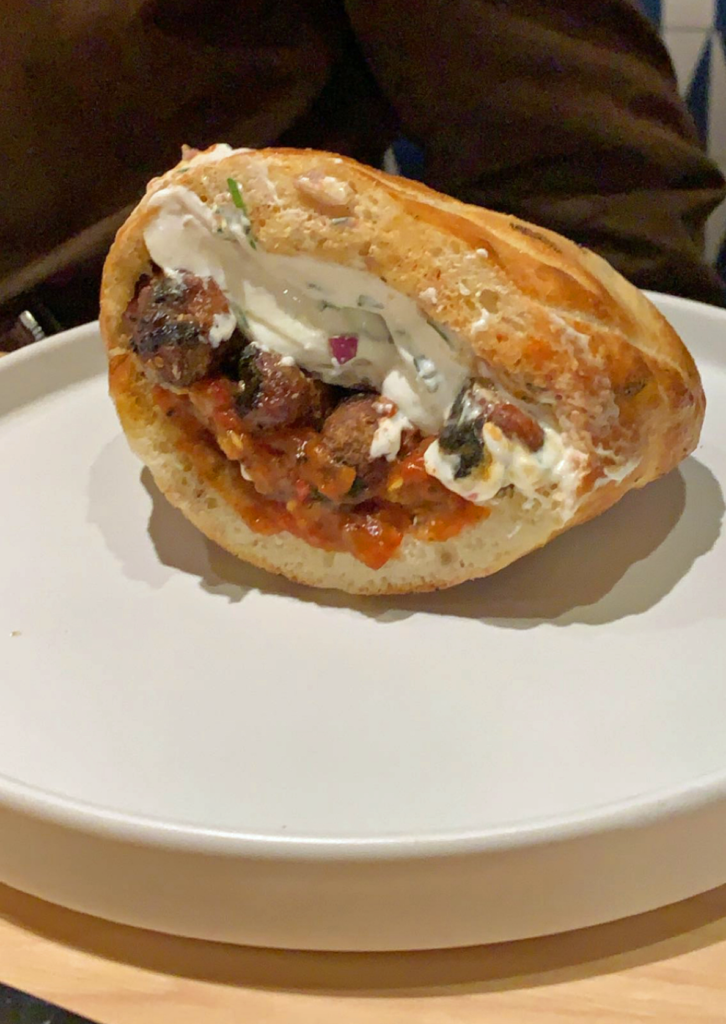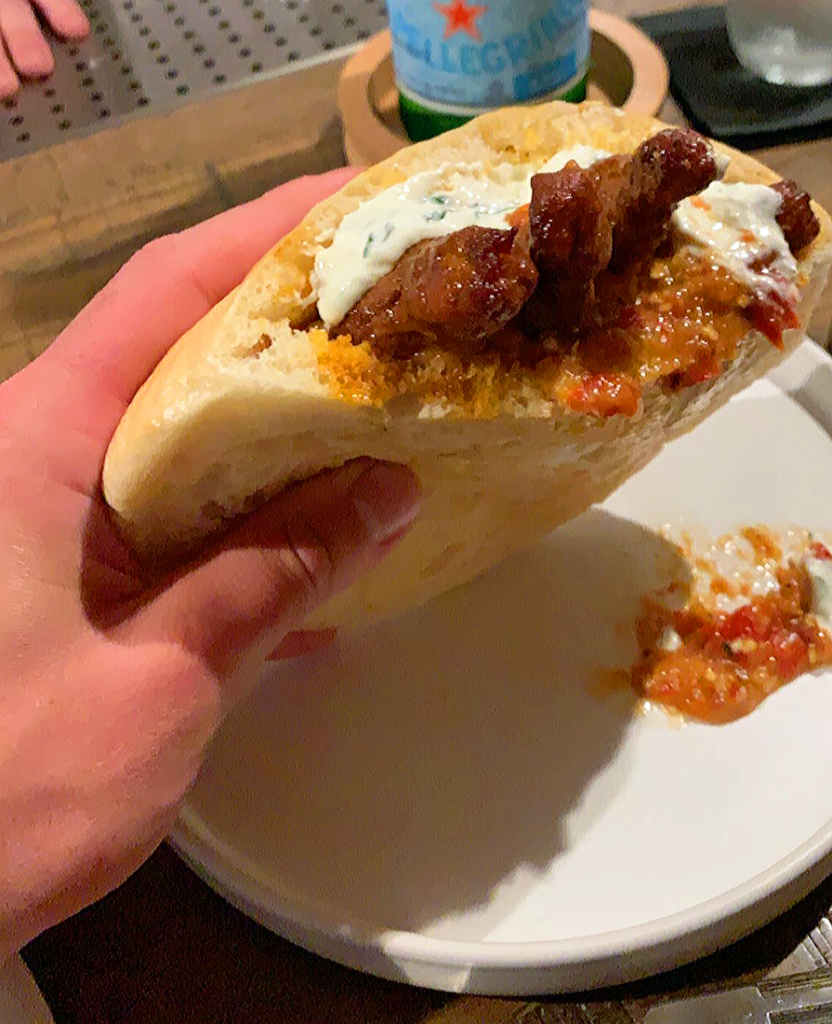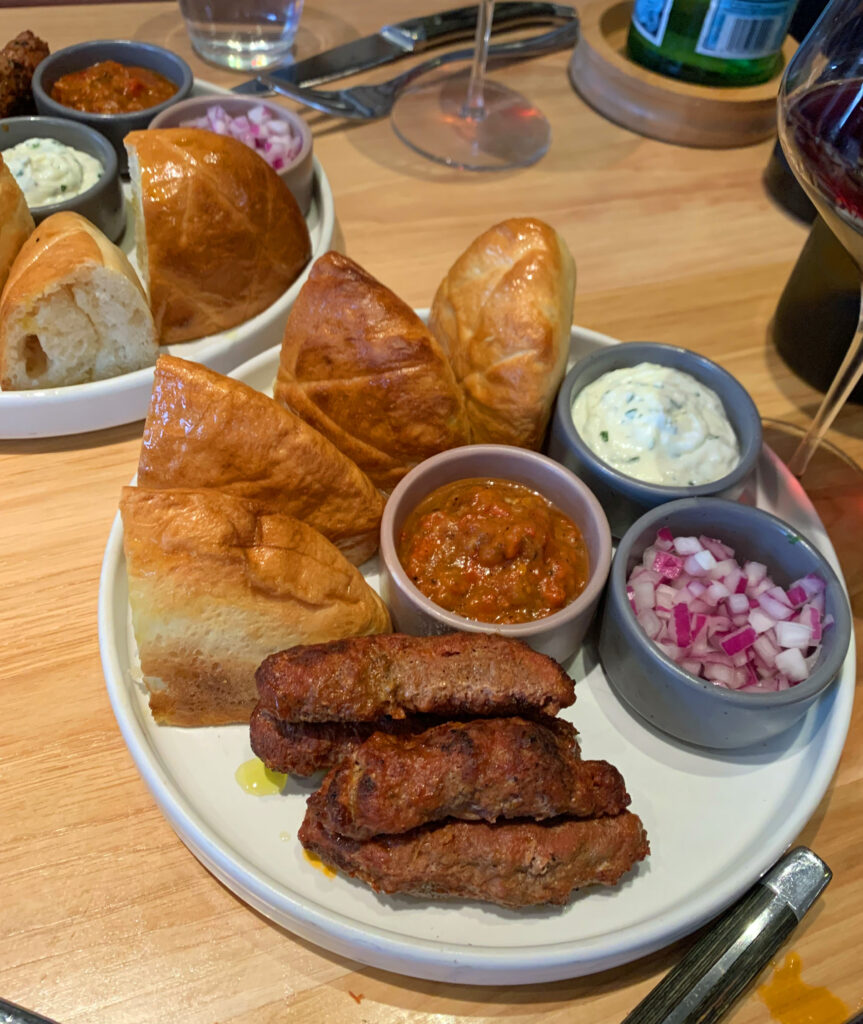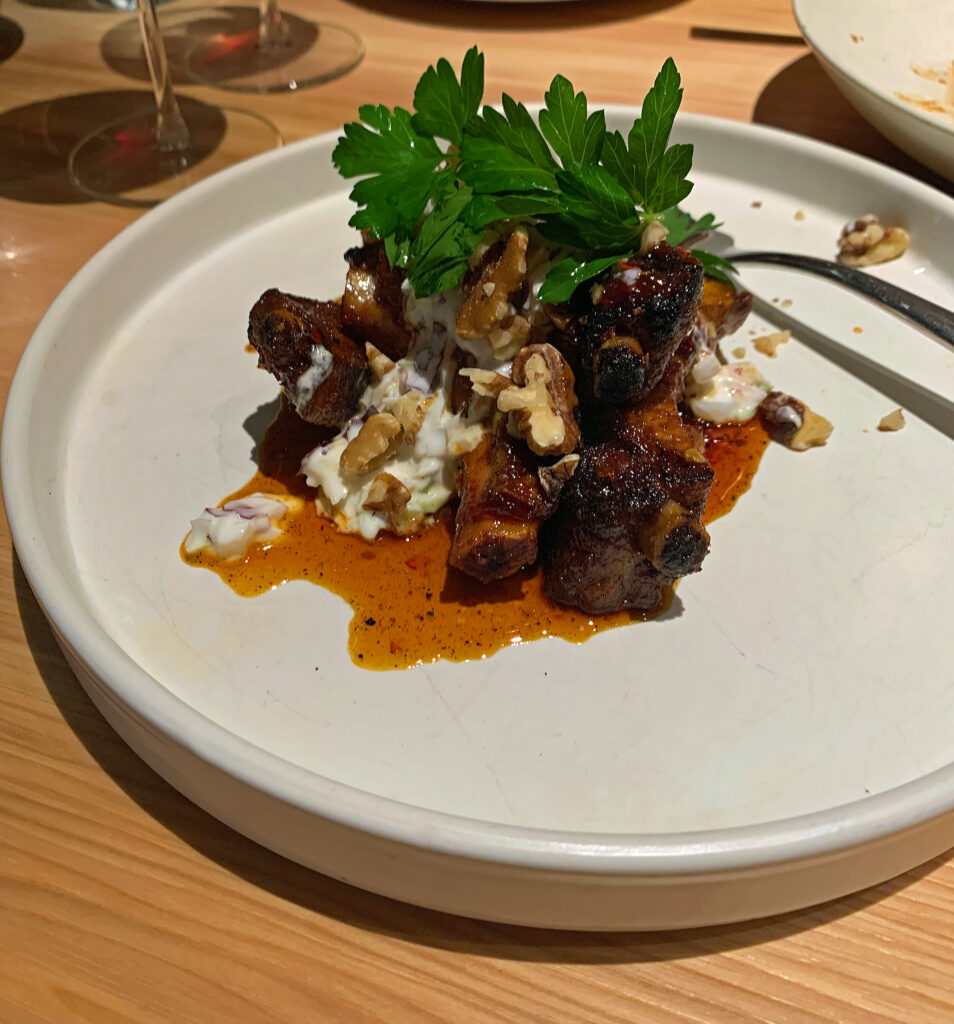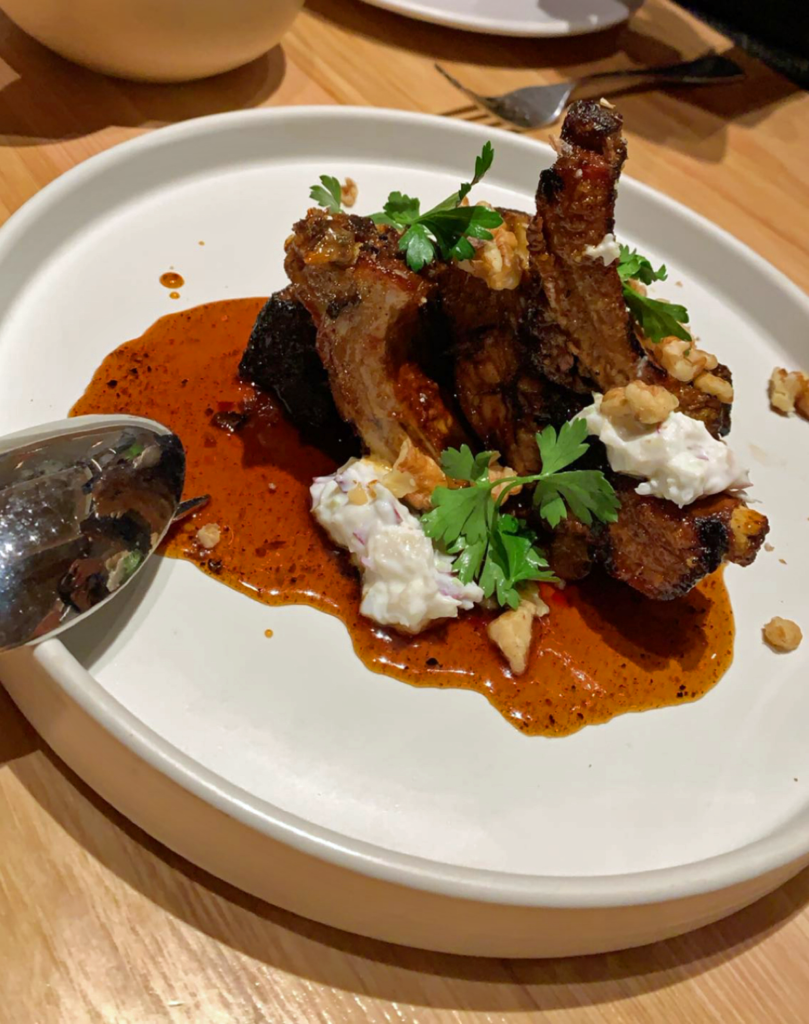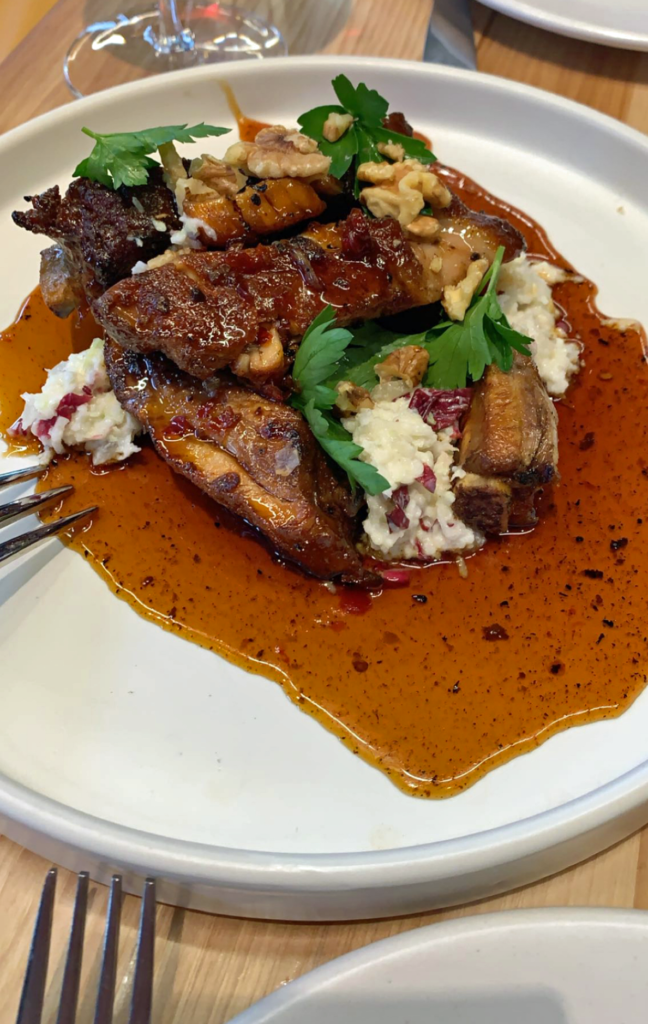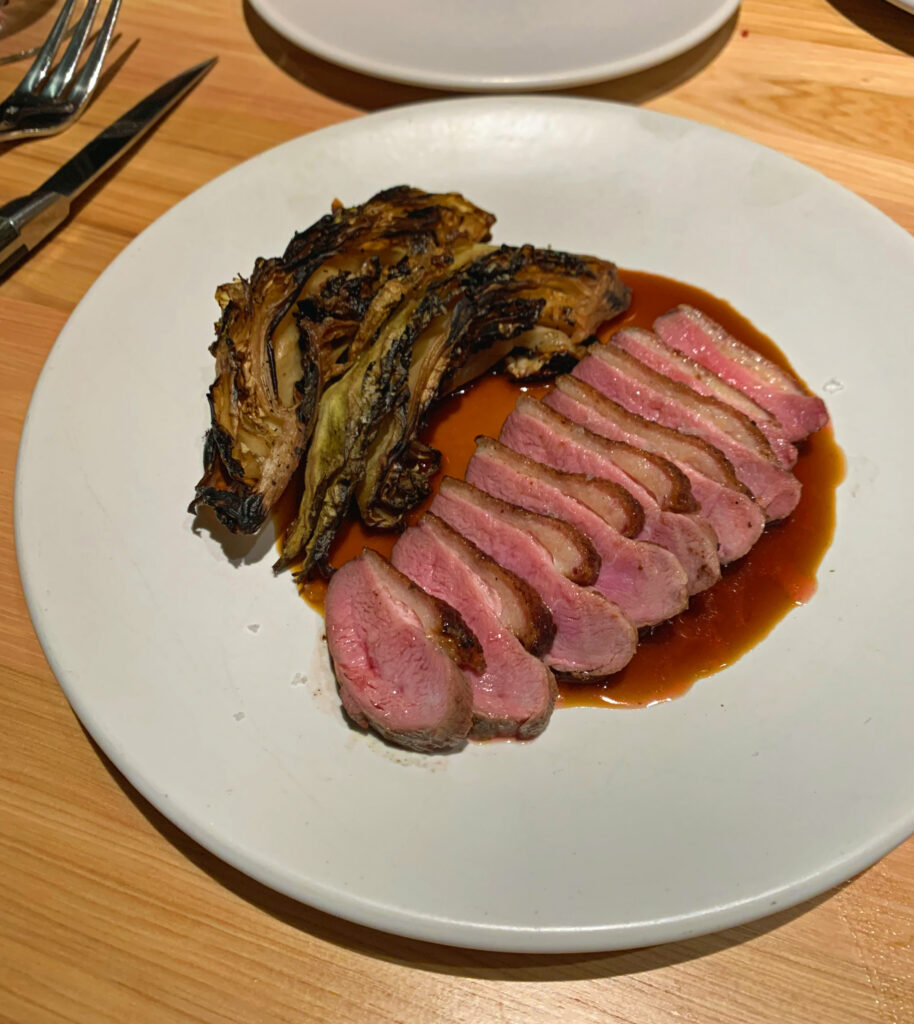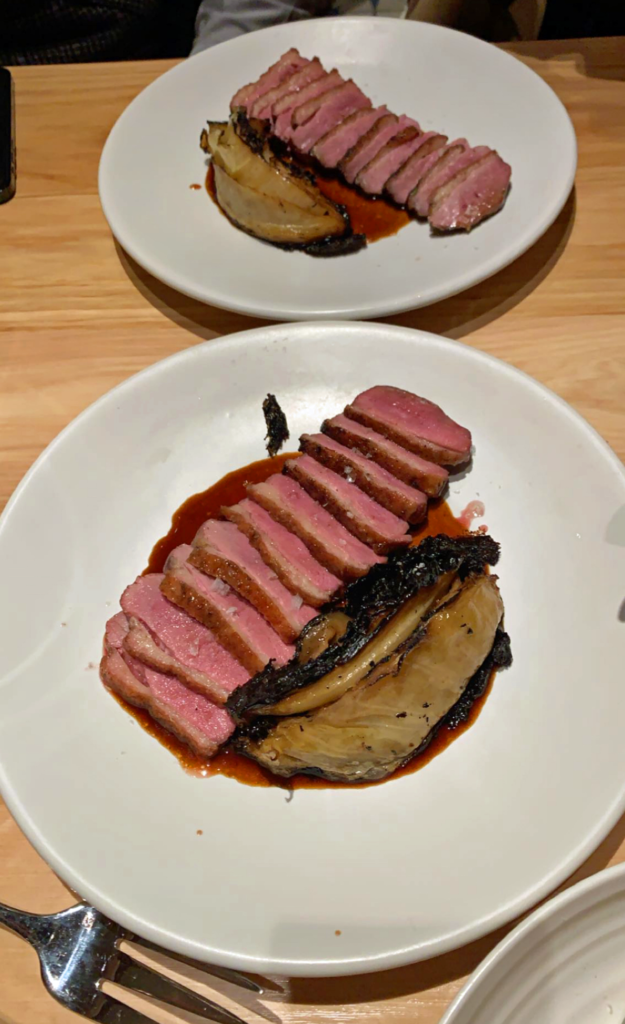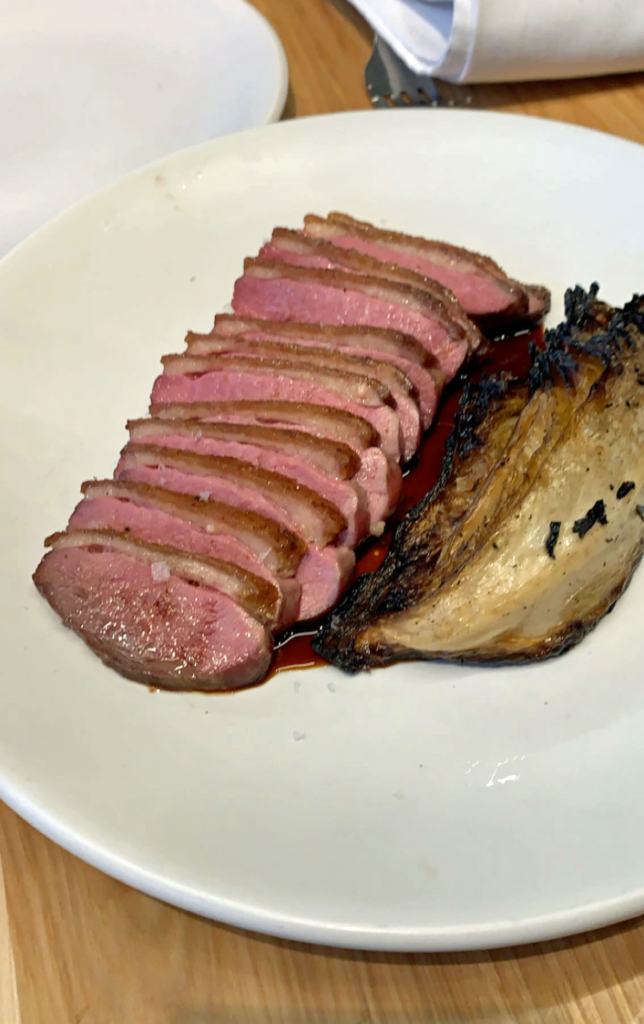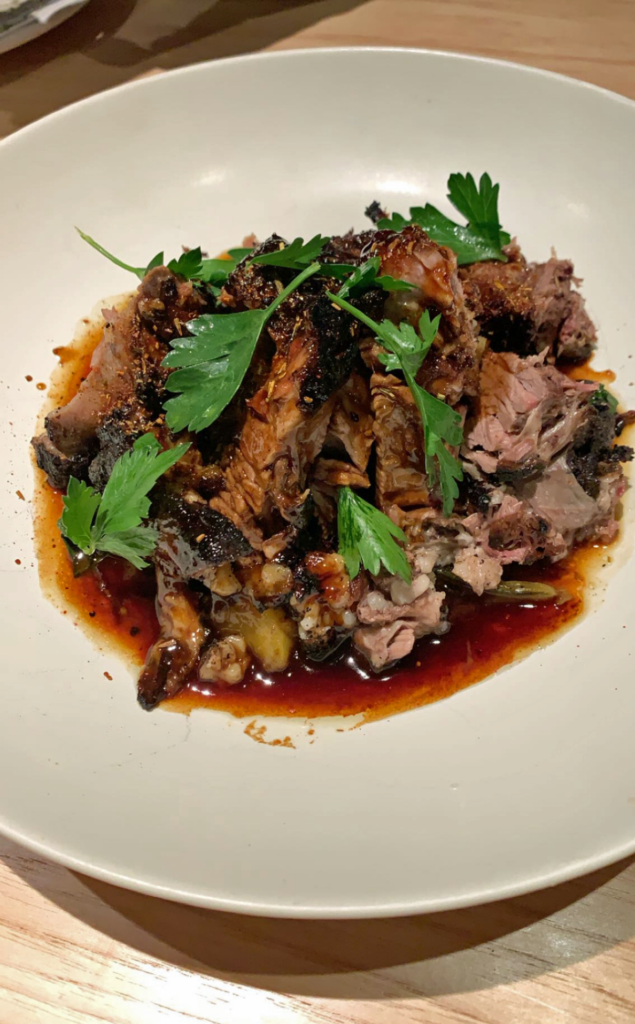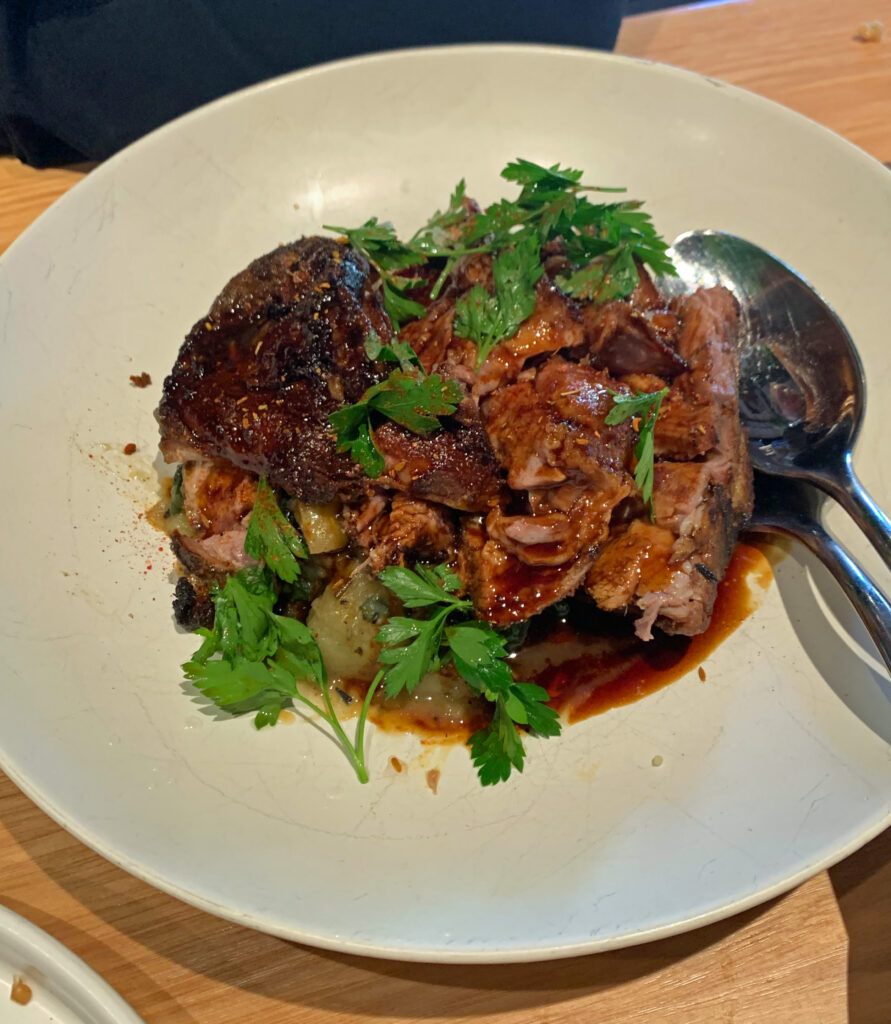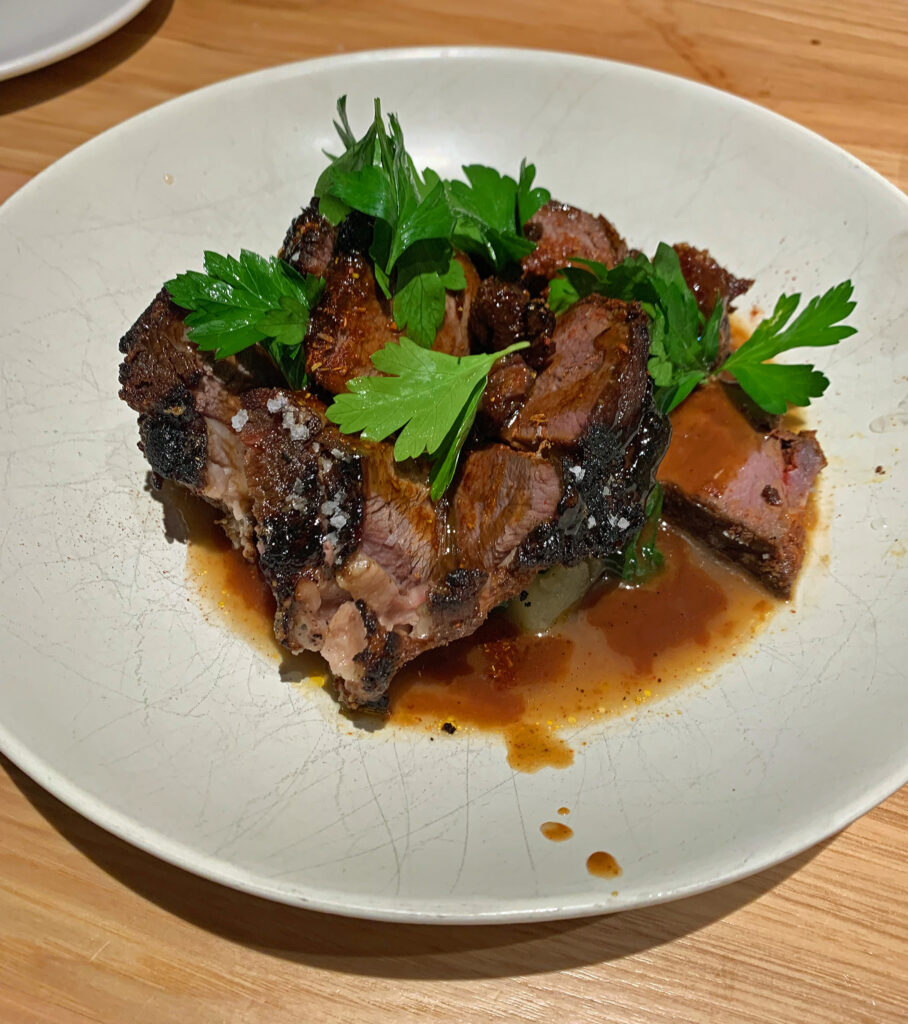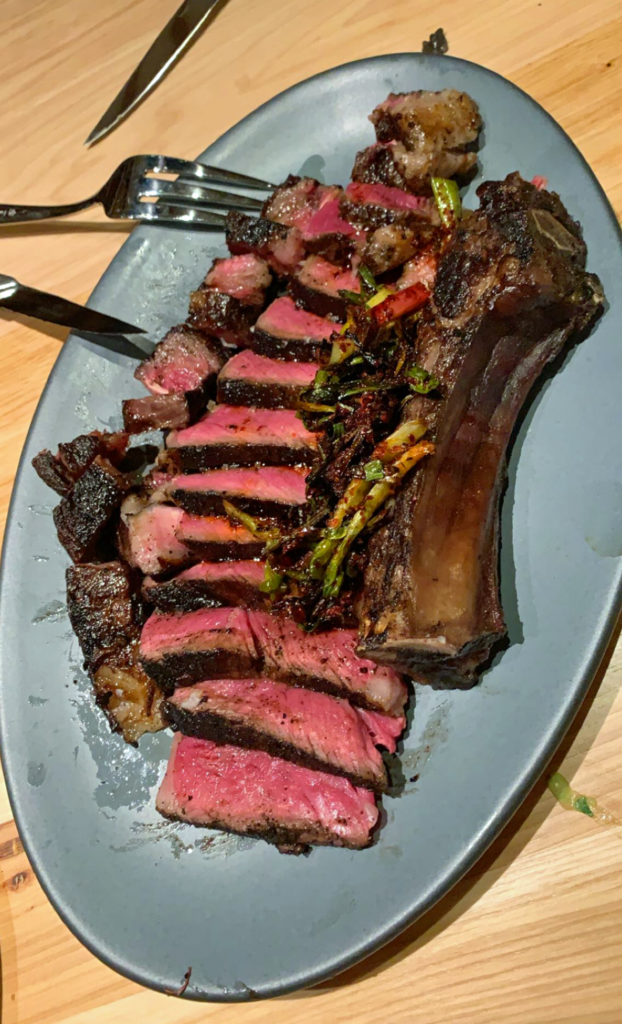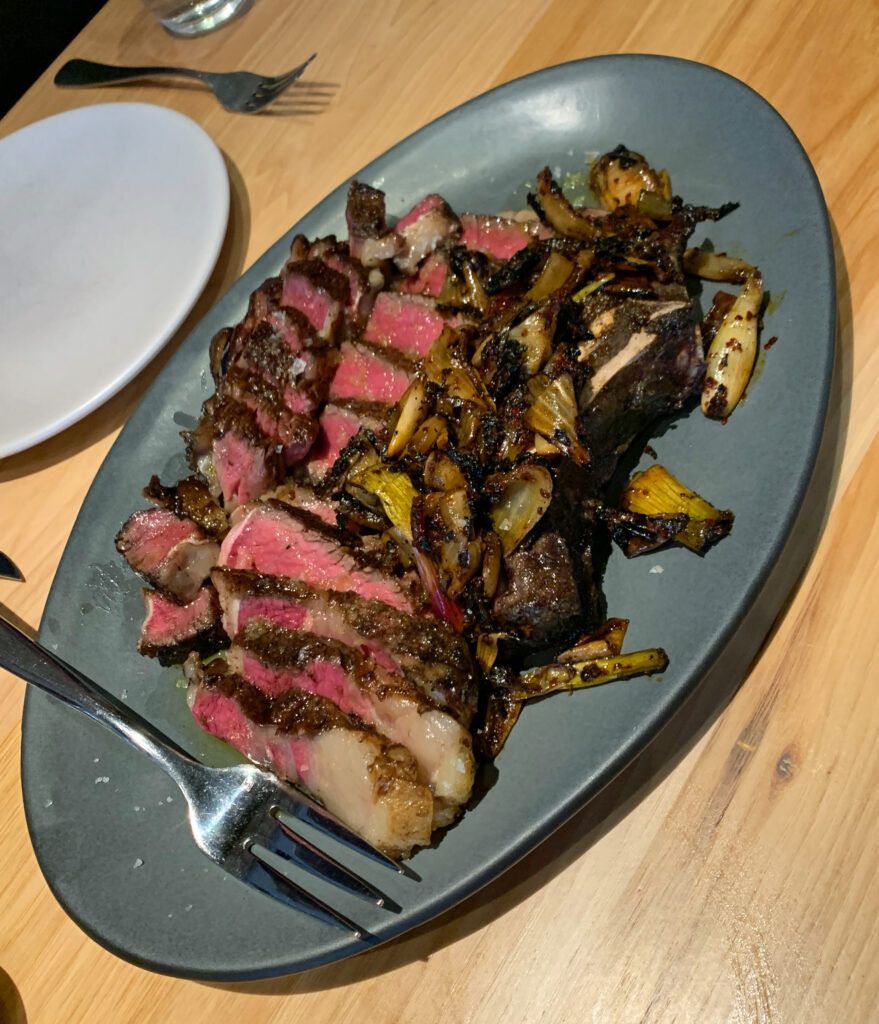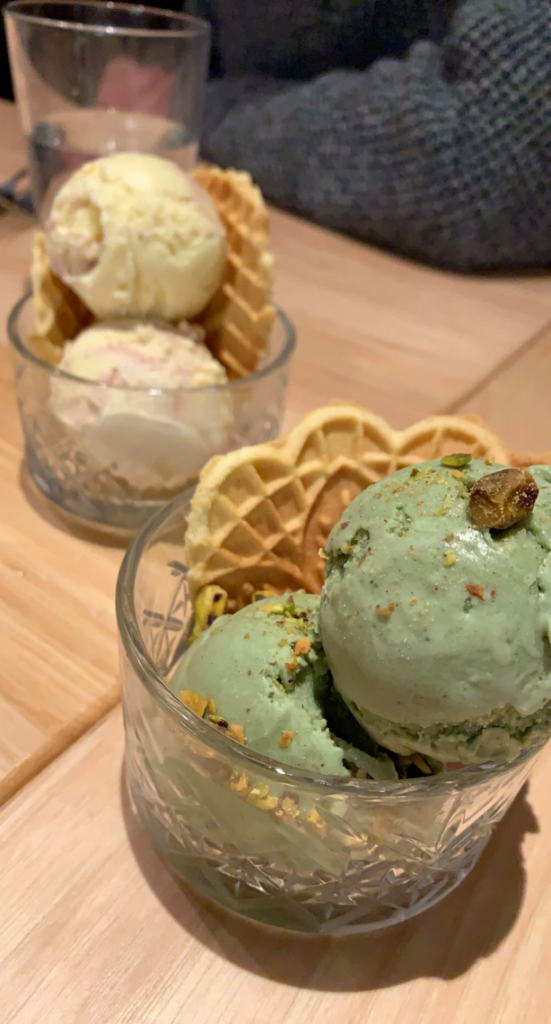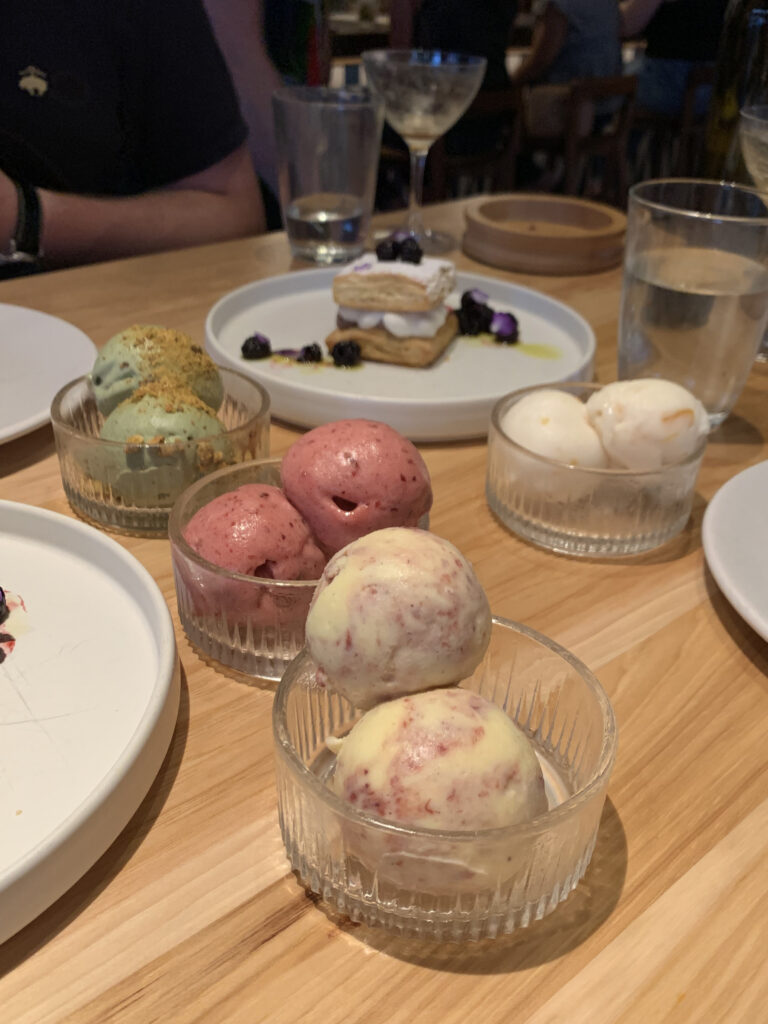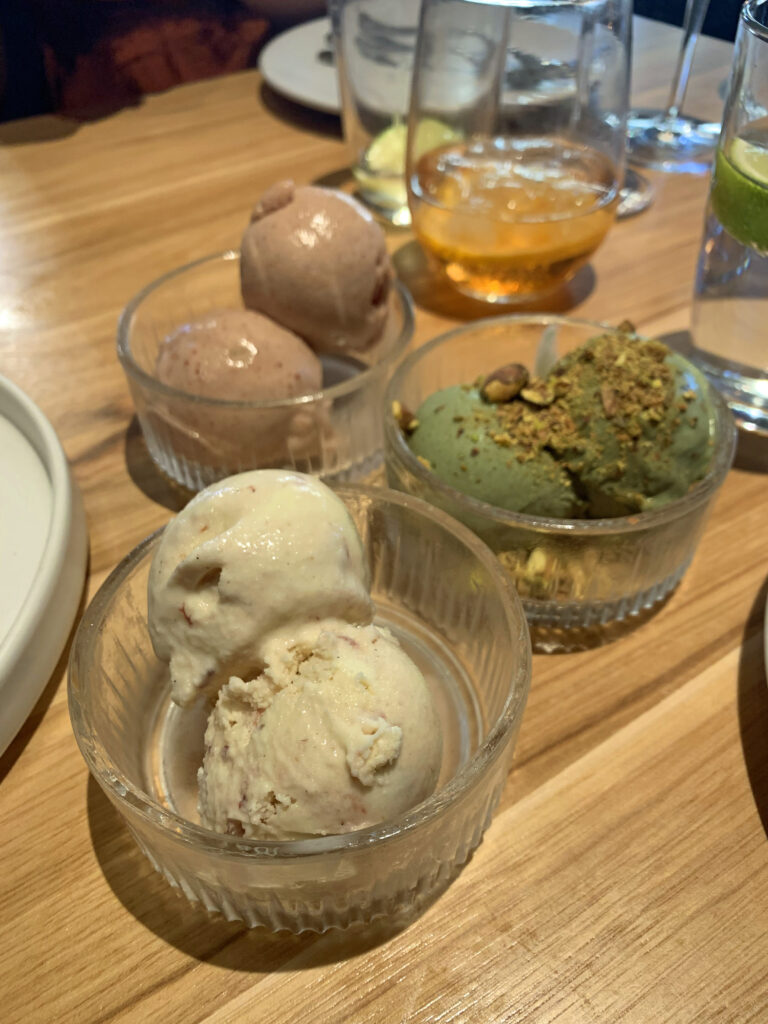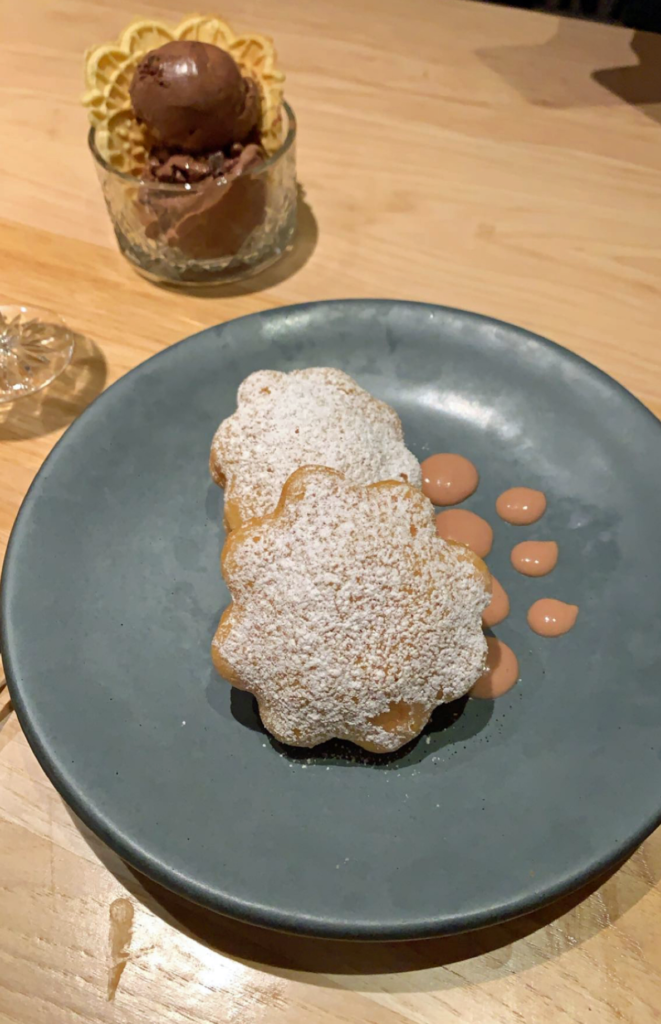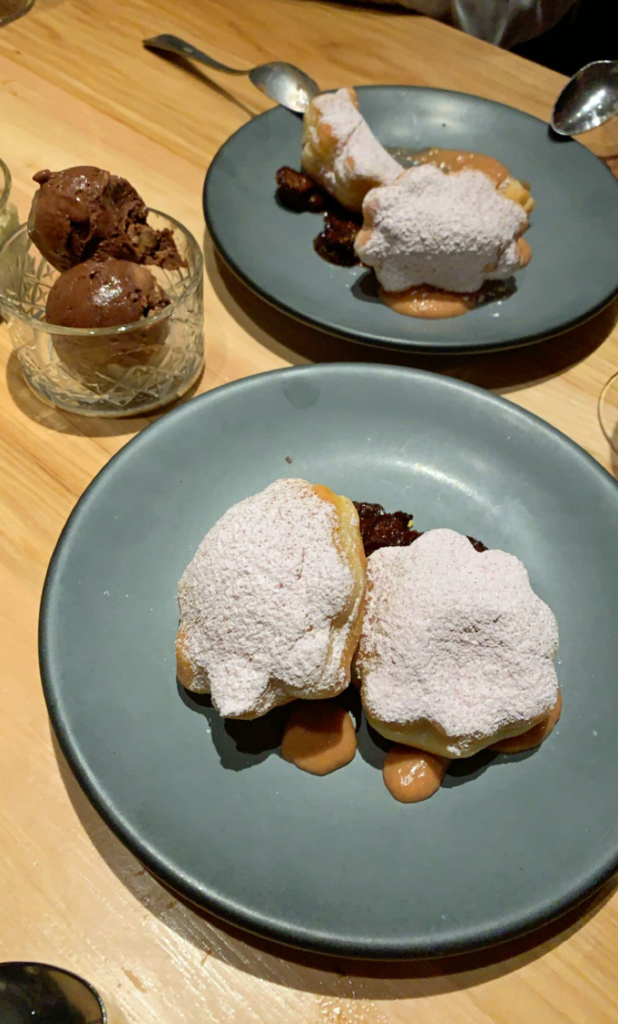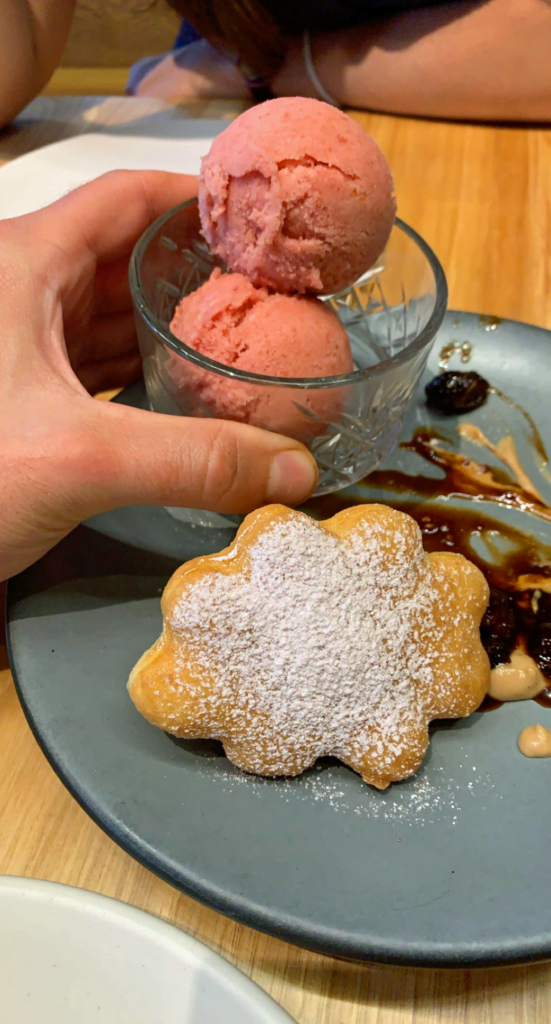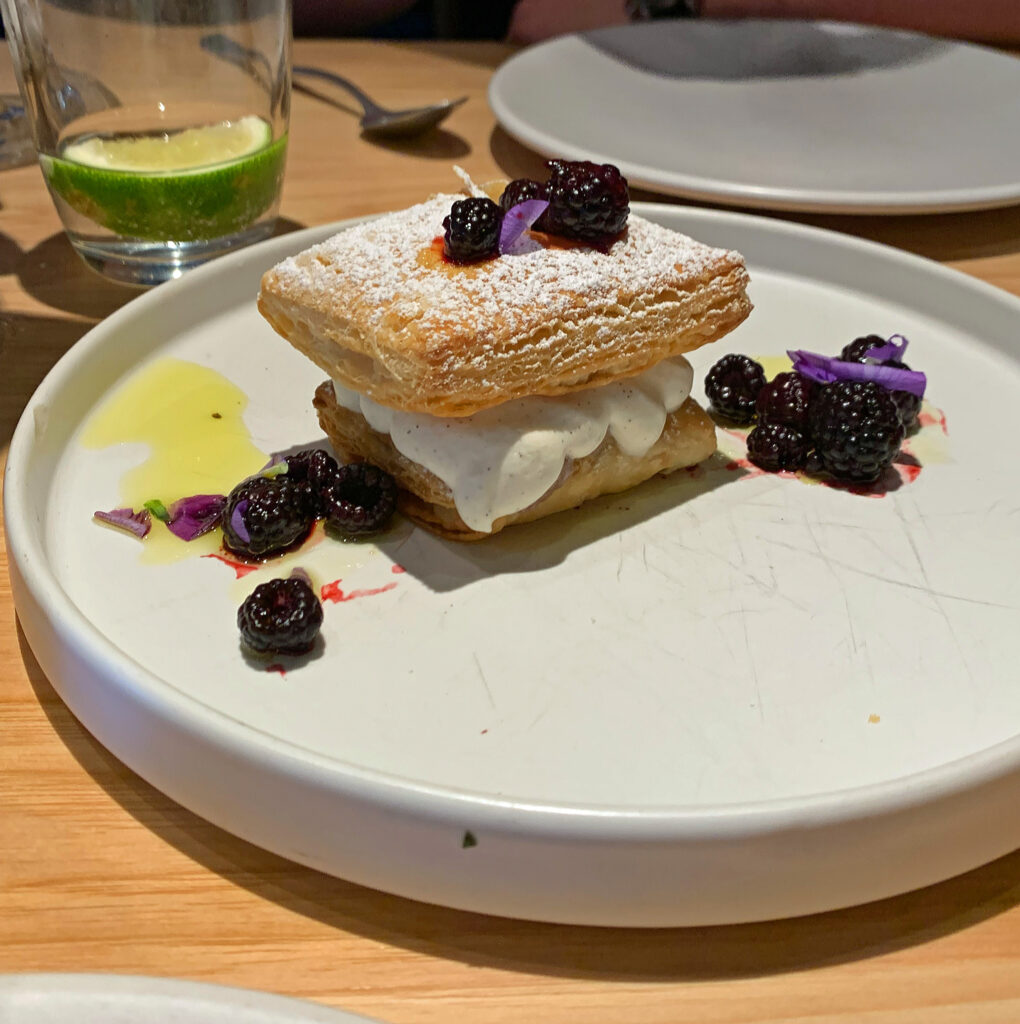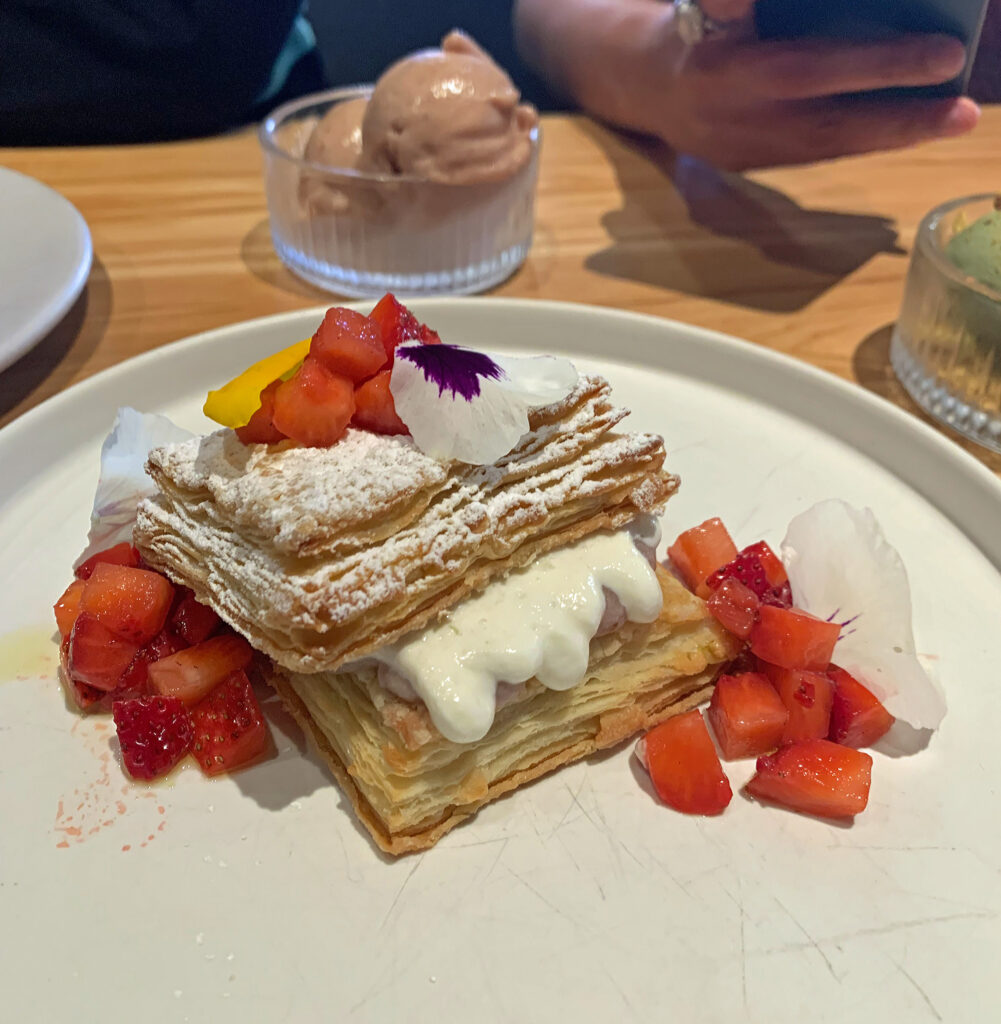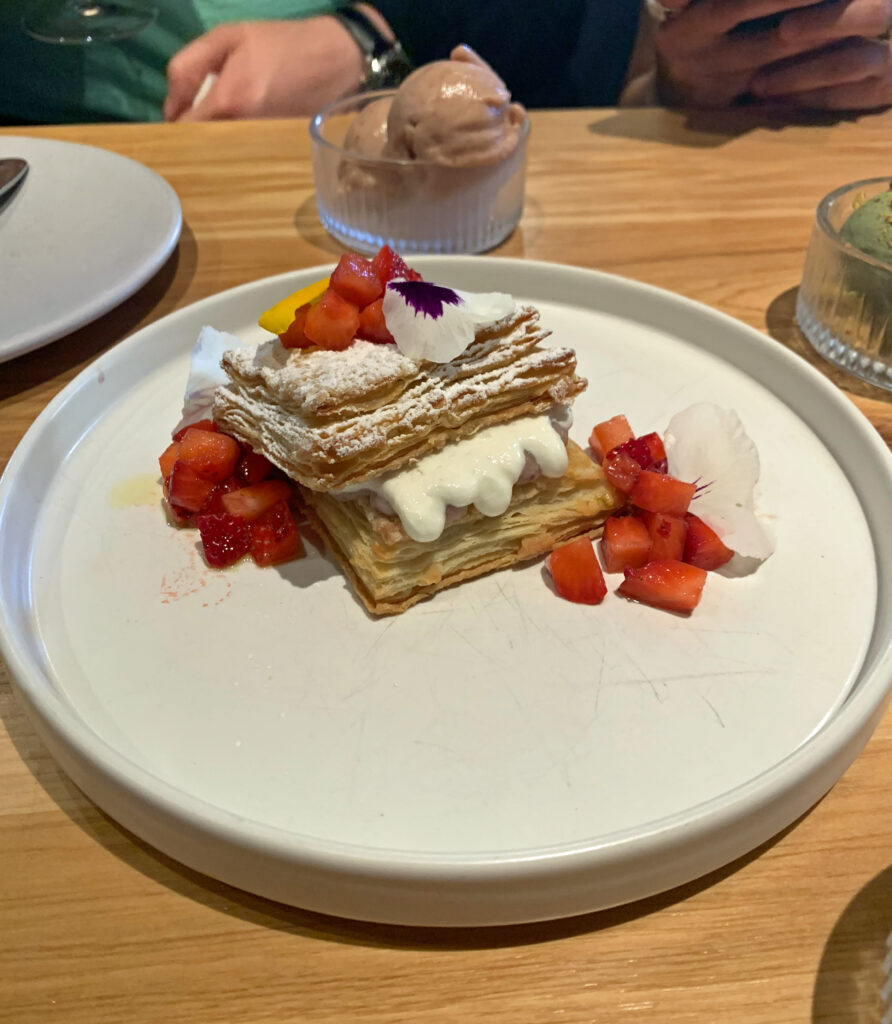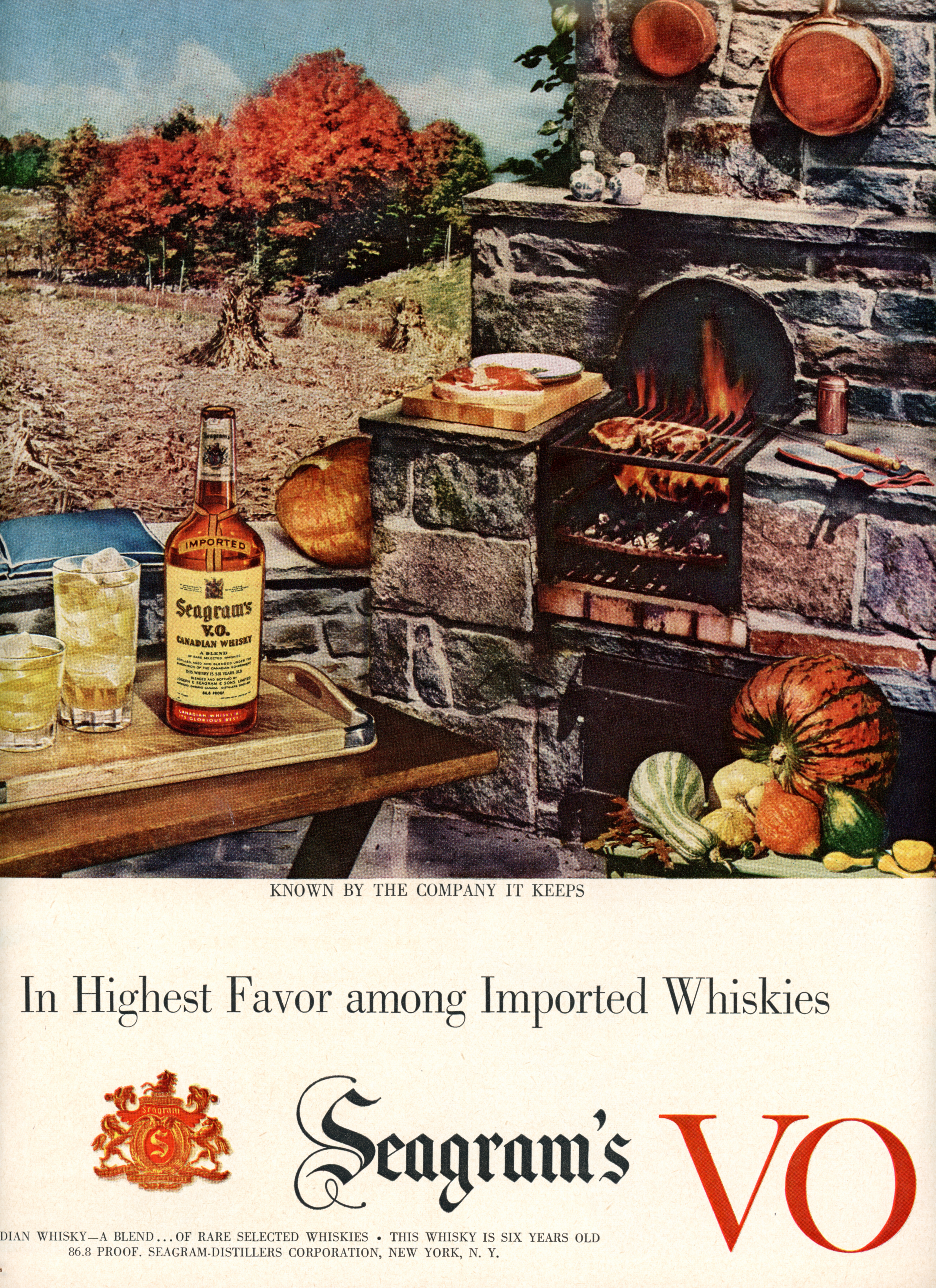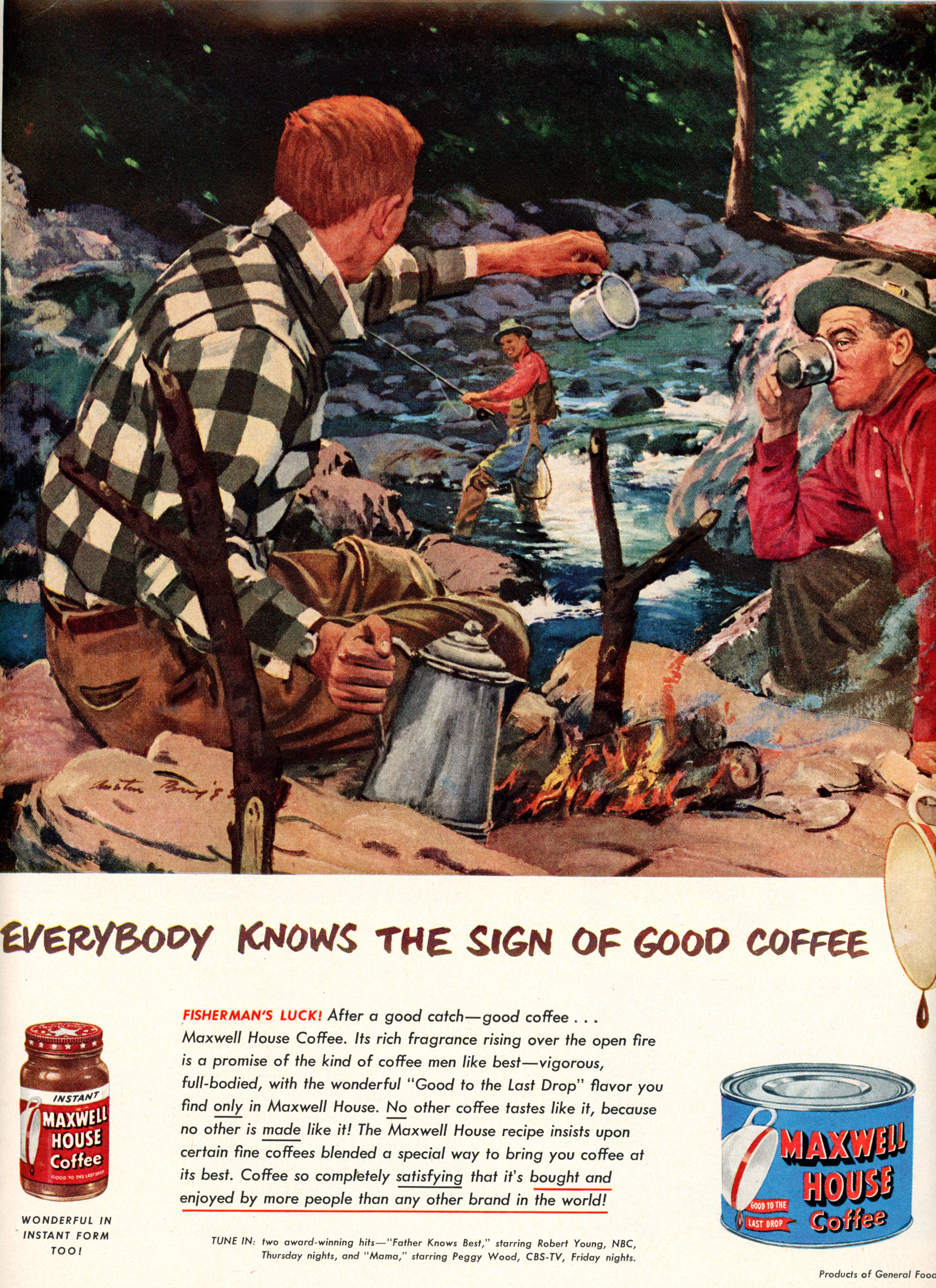Does Rose Mary demand any more of an introduction at this point? Surely, all of Chicago—and a sizeable portion of the country’s “foodies” have heard about Joe Flamm. Girl & the Goat, Spiaggia, Top Chef—you get the picture. (Personally, you pay little mind to Top Chef, but it was hard to ignore the young, broad-shouldered chef who so generously shaved heaps of white truffle atop his incomparable gnocchi, who so earnestly shared in toasting a glass of wine with his guests).
Flamm has established himself as one of the Windy City’s culinary phenoms, a man of the people inevitably perched to please the native population once he finally struck out on his own. His departure from Spiaggia in the summer of 2019 has, recently, been imbued with greater consequence now that the grande signora of Italian fine dining has decided to shutter after 37 years. The restaurant’s cuisine impressed as much as ever under Flamm’s tenure, and—while Tony Mantuano, Michael White, Missy Robbins, and Sarah Grueneberg carry Spiaggia’s torch at their respective establishments—Rose Mary stands distinctly as the spiritual successor to that legendary establishment’s shining final era.
While Curtis Duffy’s Ever—the next establishment you plan to write about—stole the spotlight in 2020 by charging out from the national lockdown (part one, at least) with an unabashed luxury experience, Flamm’s Italian-Croatian concept speaks to 2021’s conviviality—a sureness that some expression of normalcy is here to stay. Rose Mary is a place to gather and be raucous, a place where—from the very beginning—its chef warmly invited his patrons to remove their masks when interacting with him.
The restaurant can count, among all the buzz and a torrent of positive social media attention, a shining endorsement from The New York Times as one of Chicago’s “eight great spots to hit while the weather’s hot.” Rose Mary already demands that would-be patrons brave a two month wait should they wish to secure a reservation (but hey, at least you don’t have to wake up at midnight any longer to ensure a decent timeslot). And the Tribune’s goons, no doubt, will be looking for their own slice of the promotional pie soon enough, ensuring those residents who remain living under rocks hear the siren song too.
Of course, Rose Mary has also featured in two of your own articles. The first—focusing on Flamm’s opening pasta dishes—has already proven somewhat obsolete. Despite being open for only three months (the minimum amount of time a critic should wait before rendering a judgment), the restaurant has not been shy about retooling and refining its food. That quality, more than anything, makes Rose Mary well-suited for some deeper engagement early on in its lifespan.
Your second article—which oriented the Croatian-Italian concept relative to its peers, as well as a larger sense of “authentic” vs. Americanized cookery—untangled some of Rose Mary’s stylistic underpinnings. That depth—seen across the design, the recipes, the beverages, and the manner of service—also makes Flamm’s family-inspired concept ripe for evaluation.
Hype is anathema to a cynic such as you. The more the media huffs and puffs, the more you expect all that hot air to suddenly evacuate itself with all the grace of a thunderous flatulence.
Yet some places fulfill—dare you say, surpass—expectations from the very start. Some places not only please, but they promise. They stand as a bastion of dynamic cookery and gracious service that is sure to elevate the expression of those arts across the entire city. They beg you not merely to check them once off of your bucket list, but affirm the splendor of those rare restaurants that embody a living organism. Such a restaurant gives generously and humbly of itself while always pursuing some higher peak of satisfaction. It approaches that hallowed ground of the transcendent hospitality experience that is felt more sharply than it can ever be explained.
You have visited Rose Mary seven times with consistent notes and a good sense for the restaurant’s subtle changes over that time. As is typical, you will condense the whole of your experience into one all-encompassing narrative that looks to strike at the concept’s core while indulging in a bit of comparative analysis from time to time.
With that settled, let us begin.
Flamm’s new restaurant lies not just in “Fulton Market,” but on Fulton Street itself. In some sense, Rose Mary’s opening reflects that strip’s coming of age. Homaro Cantu’s Moto formed one of its earliest destinations when it opened in 2004. The Publican followed in 2008; Next and The Aviary did so in 2011. Swift & Sons cemented Google’s arrival in 2015 while Roister (2016), Duck Duck Goat (2016), Aba (2018), Time Out Market (2019), and Ever (2020) built Fulton Market into what it is today: a critical mass of trendy (but, often, truly excellent) restaurants that rivals any of Chicago’s neighborhoods.
The moody aesthetic of Fulton Market’s dilapidated warehouses has been replaced by promenades and patios brimming with energy. And that is to say nothing of the skyscrapers that shot up during the pandemic, ensuring the district has a steady population of professionals filling its tables. Yes, there’s a barcade and several dud establishments and shops to contend with—but, surely, some places must soak up all the suckers and diffuse the ever-growing queues.
Rose Mary lies west of Time Out Market and east of Roister. Occupying an attractive corner storefront in the former Fulton Central Market building, the restaurant serves as a natural bridge across what was once an undeveloped sprawl separating the strip’s two civilized colonies of commerce. Pedestrians can now appreciate the full expanse of the district without having to step in front of oncoming traffic. They can browse and imbibe in a carefree manner worlds apart from the reservations only tasting menu destinations that originally characterized the area.
Flamm’s decision to partner with Sancerre Hospitality—relative newcomers within Chicago’s dining scene—struck you as odd. The group is comprised of a husband and wife team plus the former’s cousin. The husband was a real estate attorney “exposed to clients who were doing leases for restaurant space,” the wife worked in “hospitality marketing…with a lot of really great chefs and restaurateurs,” and the cousin has a background in “finance and accounting.”
You like that the trio acknowledges they possess an adjacent but distinctly “outside” experience when it comes to hospitality—just the sort that, in league with the right partner from inside the industry, holds the potential to rethink and improve processes beyond the confines perceived by established players. One thing is for certain, Sancerre Hospitality—with its partners’ experience in real estate—secured for Flamm one of Fulton Market’s most magnificent spaces. Given the crossroads at which it stands—to say nothing of the restaurant’s soaring reputation—you might even go so far as to label it the crown jewel of the neighborhood.
Otherwise, Sancerre can only be judged by BLVD Steakhouse—located one block south of The Publican on Lake Street. That restaurant originally opened, more simply, as BLVD during the summer of 2017. Then, it was a “glitzy 1950s Hollywood-glam restaurant and lounge” helmed by former Pump Room chef Ross Mendoza serving a “modern American” menu “with a tinge of global influences.” The theme was driven by the “experiences of American soldiers who lived abroad during World War II” and brought eclectic flavors back home with them. The opening menu included a range of appetizers served “on a sourdough ‘shingle’” alongside finger food like sardines (with house Ritz crackers), brandade croquettes, and charred shishito peppers.
The bulk of the menu was meant to be shared, with usual suspects like seafood towers, caviar service, housemade pastas, a whole-roasted loup de mer, and a bone-in ribeye. Still, there were some attractive flourishes that transcended standard American fare. You think items like prawn tempura, dayboat scallops (with savory zucchini cake), lobster en croûte, BLVD patty melts, “Chicken à la King” pot pies, pork belly, suckling pig, and a Tournedos Rossini preparation made with filet mignon actually sound both imaginative and distinguished.
BLVD touted a luxurious aesthetic conceived by the ever-popular Studio K. It claimed Eater Chicago’s “Design of the Year” award in 2017 alongside praise from People Magazine as having “one of the most beautiful restaurant restrooms in the world.” The concept was considered one of Chicago Magazine’s “Best New Restaurants,” one of CS Magazine’s “Most Exciting New Restaurants,” and even earned three stars from trusty old Phil Vettel.
However, apart from universal praise for its atmosphere—even from its most fervent haters—BLVD never broke into the city’s popular consciousness. The theme and sense of storytelling might have sounded good on paper—what else would you expect from a partner experienced in hospitality marketing—yet, at its worst, the establishment was termed “the Cheesecake Factory with 2 extra dollar signs.”
Of course, you hesitate to defer to the Yelp mob in lieu of offering your own experience. (You must admit that you always forgot the establishment existed until you passed by it on the street). But the restaurant, for all its grandeur, never earned the reputation of a Bavette’s, Maple & Ash, Gibsons, or Swift & Sons. Yes, it didn’t quite bill itself as a “steakhouse” at that time, but it is hard to conceive of luxury American dining in other terms. And there existed some consensus that BLVD was simply a pretty place to grab a cocktail—not a meal.
In August of 2020, BLVD took advantage of the pandemic’s pause in operations to rebrand as BLVD Steakhouse. Spurning the restaurant’s more colorful, casual fare—according to Sancerre’s partners—was not a cynical bid to streamline the menu and spur greater profits. Rather, they viewed they decision as a “natural evolution” for their concept given that “diners over the years gravitated toward steaks and their frequent accompaniments” rather than the intended shared plates format. BLVD had already become a “steakhouse concept without that moniker, without the name attached to it.” So BLVD Steakhouse, from the group’s perspective, represented a transition towards giving customers what “they want” and owning what the restaurant had “turned into.”
(“Opening chef” Ross Mendoza, as it turns out, actually left before BLVD came to fruition—Johnny Besch, his chef de cuisine, helmed the venture from the start while retaining most of the menu as originally conceived. BLVD Steakhouse, in some sense, offered Besch, an L2O veteran who stepped into the role of executive chef, a fresh chance to put his full stamp on the establishment).
Gone from the menu were those eclectic, distinguishing flourishes. Gone was any sense of fun—which, perhaps, never really jived with the luxe, see-and-be-seen setting (let alone the award-winning bathrooms). BLVD Steakhouse’s new centerpiece is a “Butcher’s Block” section that touted meat from Creekstone Farms, Allen Brothers, and Slagel Family Farm alongside that dreaded, thoughtless offering of A5 Miyazaki wagyu that has infected just about every wannabe luxury menu in town. There are “luxe upgrades” like au poivre, béarnaise, bordelaise, chimichurri, blue cheese, and truffle foie gras butter—and sides like truffle mac and cheese, “50/50” mashed potatoes (another pernicious presence), and Lobster Thermidor. In short, BLVD became a standard steakhouse with little but a sleek setting to hang its hat on. And, for a concept born and bred in Chicago, is it not a bit despicable to offer locals style without substance?
Still, it’s hard to call BLVD an abject failure when it comes to a budding hospitality group’s first ever restaurant. Sancerre clearly nailed the aesthetic and succeeded in seducing Chicago’s toothless local critics with an easily digestible thematic grounding. They showed some degree of creativity within the crowded “new American” shared plates genre—and, consequently, weathered the departure of their would-be opening chef. When guests revealed a proclivity for the restaurant’s steakhouse fare, Sancerre pivoted to meet the demand. BLVD Steakhouse might not shine as a citywide destination within that genre, but it occupies a cozy niche opposite the sprawling, somewhat more casual environment offered at Swift & Sons. Four years running, the establishment survives—with healthy average customer ratings within a particularly discriminating market segment.
And there’s one thing about BLVD Steakhouse you must praise: its approach to wine. Steakhouse fare—to say nothing of service—may prove hard for newcomers to reinvent, but the beverage program of such a concept is always ripe for reconsideration. Typically, customers are treated as a captive audience whom will overpay for whatever plonk plays the part of their beef’s “best friend.” Such is the expectation: that a steak demands one drink wine, and that a steakhouse meal is wasted without that extra indulgence.
Sancerre subverts this money-grubbing trope by pricing its wines at a mere 200% markup (rather than the 300% or even 400% seen elsewhere). Only your beloved Bavette’s—to the best of your knowledge—comes close to doing the same. And, while BLVD Steakhouse does not offer quite as discriminating of a selection, a feeling of generosity abounds.
A Selosse “La Côte Faron” is offered nearly at the going wine-searcher rate. Didier Dagueneau’s “Blanc Fume de Pouilly” and “Silex”—each with more than five years of age—clock in at the lowest price you’ve seen them go for in the city. There’s a bit of aged white Burgundy, some Domaine Huet (demi-sec!), and plenty of Riesling from top producers for a pittance. At $72, Lopez de Heredia’s “Tondonia” rosé is an absolute steal. While BLVD does not exactly give its tried and true cult California Cabs away, prices are hardly exorbitant to the extent seen elsewhere. In fact, drinkers willing to embrace Pinot Noir (both domestic and French), Beaujolais, the Loire or Rhône Valleys, and Italian offerings will be well-rewarded.
Few steakhouses tout wines with decades of age—as well as magnums—at such attractive prices. Additionally, a “Vintage Thursdays” program offers guests “high-end vintage wine sold at cost” while “BLVD’s Magnum Program” brings big bottle glass pours to the floor on Friday and Saturday. Bourbons from Elijah Craig, E.H. Taylor, Old Fitzgerald, Parker’s, Weller, and Willett are listed at prices that embody much of the same spirit. And all that states rather clearly: BLVD Steakhouse wants its beverages to help empower a superlative dining experience—rather than use them to punish connoisseurs by holding them hostage to their fine taste.
Thus, while you are tempted to view BLVD as the albatross around Sancerre Hospitality’s—and Rose Mary’s—neck, some elements of the steakhouse do, indeed, speak to the partners’ possession of a hospitable spirit. It may be daunting for relative newcomers to sling beef alongside the city’s best operators, but Flamm’s fellows can certainly beautify a space and build a wine program. Perhaps Sancerre simply needed to find the right figure behind the stove to make their dreams of domination come true. Certainly, in joining up with the Spiaggia ace, they secured one of Chicago’s most monumental talents (and one only now entering the prime of his career).
If Sancerre’s partners do not provide the support that enables Flamm’s cooking to shine, will the group stand as anything more than a vehicle for the creation of trendy spaces that happen to serve food? Surely, it is upon Rose Mary—and not BLVD—that their mettle must truly be tested.
Walking west down Fulton Street—dodging the punters and bussers buzzing about Time Out Market’s patio—you cannot deny Rose Mary’s curb appeal. The restaurant features neither the obnoxious signage of the east end’s crowd-pleasing favorites nor the total anonymity of the Alinea colony further down the way. Flamm’s façade is confident, classy, and distinct. “Rose Mary” is written in a lowercase scrawl—glowing brightly blue against slate paneling—that speaks to the handwrought, earnest quality of the chef’s food. Another slight bit of signage—a stylized sprig of the titular herb—marks the restaurant for those approaching from the east.
While the establishment cuts a subdued figure during the daytime—its ample windows reflecting back at the street—the dining room is set positively alight once the sun goes down. Unlike the Girl & the Goat’s grim tavern aesthetic or Spiaggia’s cloistered space up above Michigan Avenue, Rose Mary seduces passersby with the sense of a glowing good time. It’s not the kind of moody love nest where one holds down a table merely to whittle away time—Flamm has opened a food destination, and onlookers will witness tables buckling under the weight of shared plates stretching from corner to corner. They’ll crave the conviviality stoked by golden-hued negronis, refreshing spritzes, and fizzy natural wines joining forces to emit a sonorous “clink.” Some find the restaurant’s lighting just a bit too bright—but it ensures the focus remains on the cuisine, rather than the largely-aesthetic gambit typified by BLVD.
Though Sancerre’s steakhouse tapped Studio K for its design, Rose Mary—rather smartly—sought the distinction of an outside firm. (To wit, Karen Herold—however talented she may be—exposes the limitations of her “bag of tricks” as she lends her eye to more and more thoughtless luxury concepts like the Nobu Hotel and BIÂN).
Studio UNLTD got the job—a Los Angeles-based firm whose credits include Bestia, Bavel, and Dominique Ansel’s dual bakery/dining concept within that city. At a glance, Studio UNLTD’s aesthetic distinguishes itself from Studio K by its bright tones and greenery. There’s a kindred eye for crisp wood, polished metal, and textural detail, but the former avoids the soulless greyscale that has somehow defined “Chicago luxury” at present. Plus, it was simply smart of Sancerre to bring a successful firm here from out west rather than perpetuate the incestuous streak that has made for something of a monoculture when it comes to restaurant design here.
Studio UNLTD roots Rose Mary’s design in that of the konobas, “family run taverns of Croatia” characterized by a “utilitarian yet celebratory approach to eating and gathering.” The firm channels the Mediterranean coast by way of “whitewashed brick walls,” “moments [cringe] of red clay,” and “tile work of a deep, azure blue.” Completing the look—to indulge one last time in cloying designer-speak—are “rustic, honey-colored oak millwork” and “pale stone used on the exposed surfaces” used to lend “softness and warmth to the space’s airy, indoor-outdoor feel.” Surely, it all sounds better coming straight from the horse’s mouth—rather than deferring to a journalist’s paraphrased regurgitation of the same description.
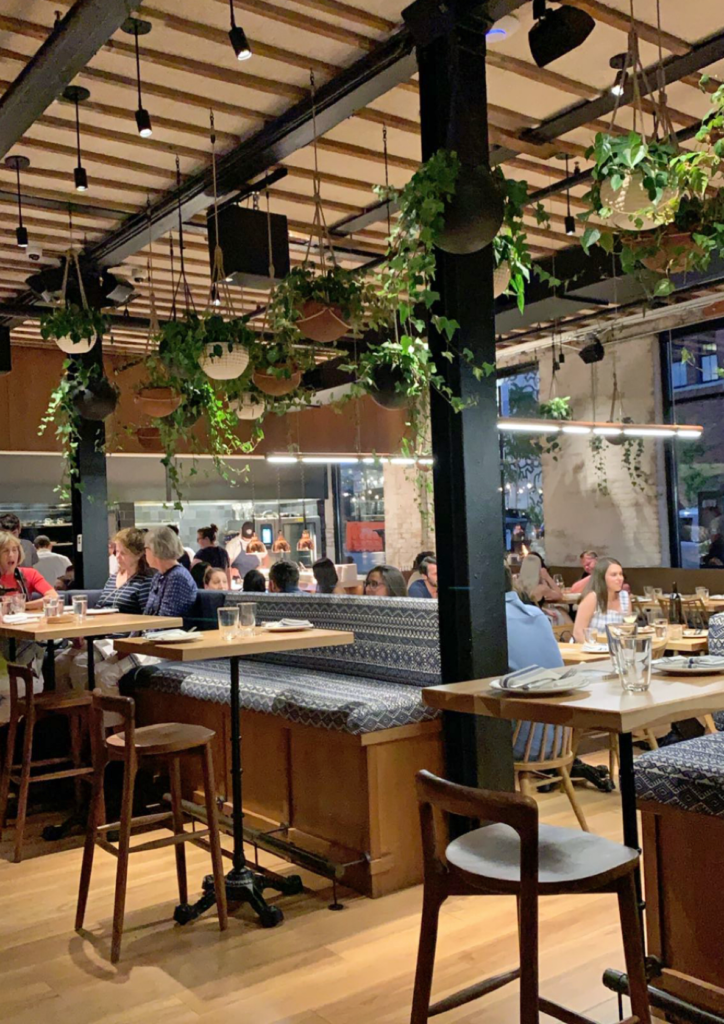
In practice, you enjoy the sensation of walking through Rose Mary’s slick outer façade and finding yourself in a bustling, friendly space. “Family run tavern” really does capture the space’s feeling. Chairs, stools, and tables are made from hardy—yet comfortable—wood. Ample banquettes tout charming embroidered patterns which find a partner in the geometric tiles that define the restaurant’s sweeping bar (along with the back wall of the kitchen and the floor of a more secluded rear dining area). Nothing feels precious about the materials—nor have they been chosen merely to weather a high volume of customers. Rose Mary embodies the same kind of refined rusticity executed so well at Smyth. Any needless ostentation would prove anathema to the genuine sense of warmth drawn from Flamm and imbued into the rest of his team and the myriad details of his kingdom.
While you do enjoy Monteverde’s aesthetic, Rose Mary succeeds in building a better ambiance through its fluidity. Grueneberg did well to maximize patio and walk-in bar space by structuring her dining room in an L-shape. However, though the pasta-making station given pride of place at the center of the design is a signature element—and the alley running from the pass to the dining room offers an operational advantage—this comes at an aesthetic cost. Monteverde’s dim, more romantic lighting shifts attention firmly towards one’s own table. One gets some hazy sense of the other guests in the building, but sightlines are well managed to lend the experience an insular, intimate tone.
Rose Mary, in contrast, has built a cohesive, celebratory space in line with that “tavern” sensibility. The kitchen’s placement opposite the entrance—no doubt, its featuring of a literal hearth—orients both dining room and bar around a common center of attention. The two spaces are nominally divided by high-top banquettes, but—in practice—they flow totally together thanks to some attractive planters of artificial greenery that draw the eye upwards while obscuring sightlines just enough to avoid any sense of being stared at. A “chef’s counter” placed at the corner of the pass offers an extra special bit of seating without spoiling the fun for any diners seeking a view of the magic. The more secluded dining space in the back corner of the restaurant does not miss out either: they retain some sense of the kitchen’s energy while maintaining an added level of privacy ideal for larger groups.
Monteverde, to its credit, possesses a greater number of four-top standing tables that can be used to accommodate as many as six guests with some degree of privacy. Both it and Rose Mary make use of their banquettes to serve these larger groups as well—though the latter certainly relies on them more. Still, you think both establishments largely maintain the same amount of space between their parties. And Rose Mary’s fluidity means neighboring tables might spy something delicious on your plate and engage you for a recommendation. Or patrons might, simply, look up together in awe as Flamm glides through the dining room offering smiles and well wishes to his adoring fans. (Grueneberg, of course, is a great presence in her restaurant as well—yet her format allows for more surgical appearances that escape wider attention).
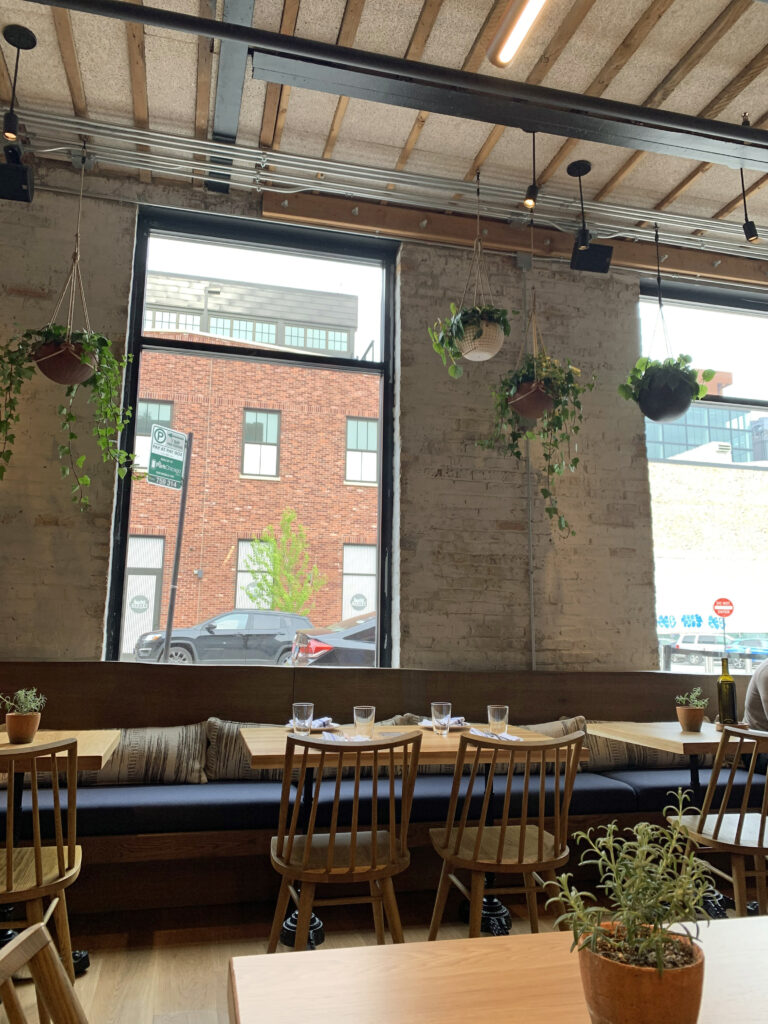
The sense of your experience being, in part, characterized by the other guests present may not appeal to all. But it certainly taps into Flamm’s “Goat” heritage and that of the konobas inspiration. It privileges an overriding, palpable sense of energy that defuses sour trend-chasers efforts to sequester themselves while hunched above their phones. In that sense, Rose Mary works to establish some minor sense of community within its walls. Comfort is never sacrificed in doing so, but the restaurant is right to resist the sense of commercial anonymity that will increasingly prevail alongside Fulton Market’s continued growth.
Upon finally arriving at 932 W Fulton, you are surprised by the small patio—a recent addition—which, despite the restaurant being open for several months, seemingly sprung up overnight. It’s not the most luxurious outdoor space in the neighborhood, but it serves to manage Rose Mary’s overflow of customers while sharing some of the tavern’s energy with the rest of the street.
In fact, the only cramped space in the establishment can be found at the host stand, where patrons conscientiously position themselves away from the flow of traffic after providing the name of their party. Some, surely, angle for a spot at the bar—a superb way to sneak in without a reservation—but the process is well-managed by the staff so as to avoid any mass of bodies skulking behind those already seated. Bookings, in your experience, have always been honored with absolute punctuality—a great testament to the management’s organizational skill and restraint. This is not a business built upon maximizing the number of asses in seats on a given evening, but the operation is efficient. Walk-ins may be directed to wait outside on Sangamon Street, ensuring those with reservations are given a smooth ride from start to finish.
As is typical, the hostess greets you with a smile and—but thirty seconds later—a server or manager whisks you away to some corner of the restaurant. From your experience, the banquettes along the eastern wall—including the tables placed in the middle of that section—offer the greatest sense of showmanship. One is gripped watching Flamm lead his line and appreciates all the flurry of activity managed like a well-oiled machine. One sees, hears, and smells the experiences of Rose Mary’s enthusiastic clientele as they forge their own path through the menu’s offerings. The energy is palpable, and one has no doubt they occupy a space in one of Chicago’s most magical dining rooms.
The high-top, L-shaped booths just behind the bar offer, in your opinion, the most comfortable seating. One can people-watch towards the imbibers or past the hanging planters that separate the tables from the diners in the aforementioned adjacent space. One can even still spy the workings of the kitchen rather well—albeit from further down the pass. All the while, the high-tops remain isolated from other customers (thanks to apt management of walk-ins) and eminently accessible by servers—they might strike a perfect balance should one not mind a raised perspective.
Finally, there’s the rear dining area. As previously mentioned, these seats offer the greatest intimacy and an added flexibility for particularly large parties. Of course, some of the dining room’s overall energy is sapped purely by one’s distance from the goings-on. But those seated in the space are not wholly cheated: they retain a sidelong view of the kitchen’s action, greater access to the bathrooms, and a more composed mood to their meal’s proceedings. The tiles that form the floor of the space, too, are rather pretty. They are finished with an artificial patina that lends them a worn, “old country” look.
Once you arrive at the table, service snaps into action rather quickly. Rose Mary ensures that each party is greeted by a lacquered barcode doodad that leads them—via mobile device—towards a slick interface that concisely presents the full range of five menus. While the bussers go about providing water service, guests are given a few minutes to decide upon drinks—or opening bites—well ahead of receiving the restaurant’s opening spiel. Not that anyone beats you over the head with it—for Rose Mary’s is a simple concept inspired by Flamm’s “Italian heritage and the bold, bright [and beautiful?] flavors of Croatian cuisine.” The chef does one better—and pulls in the tavern inspiration—when he terms the “rustic yet refined” menu “Adriatic drinking food.”
That’s certainly not a hard concept for Chicagoans to wrap their gullets around. “Bar food” by any other name still ensures a direct route towards gustatory pleasure. And Rose Mary, certainly, does not shy away from slipping some Croatian nomenclature onto its menu when it has the chance. The chef would be spurning an easy opportunity to educate his audience otherwise. But his is an instruction forged through satisfaction—not the kind of pretentious lecturing that pursues a hackneyed sense of “authenticity.” It’s Flamm’s vision—“the culmination of who I am, what I’ve learned, and the person I’ve built a life with and a family with”—drawn from that impenetrable process of unfettered inspiration. Rose Mary offers a genuine, singular expression of cuisine rather than pigeonhole itself into a gimmicky sort of gastrotourism detached from its actual terroir.
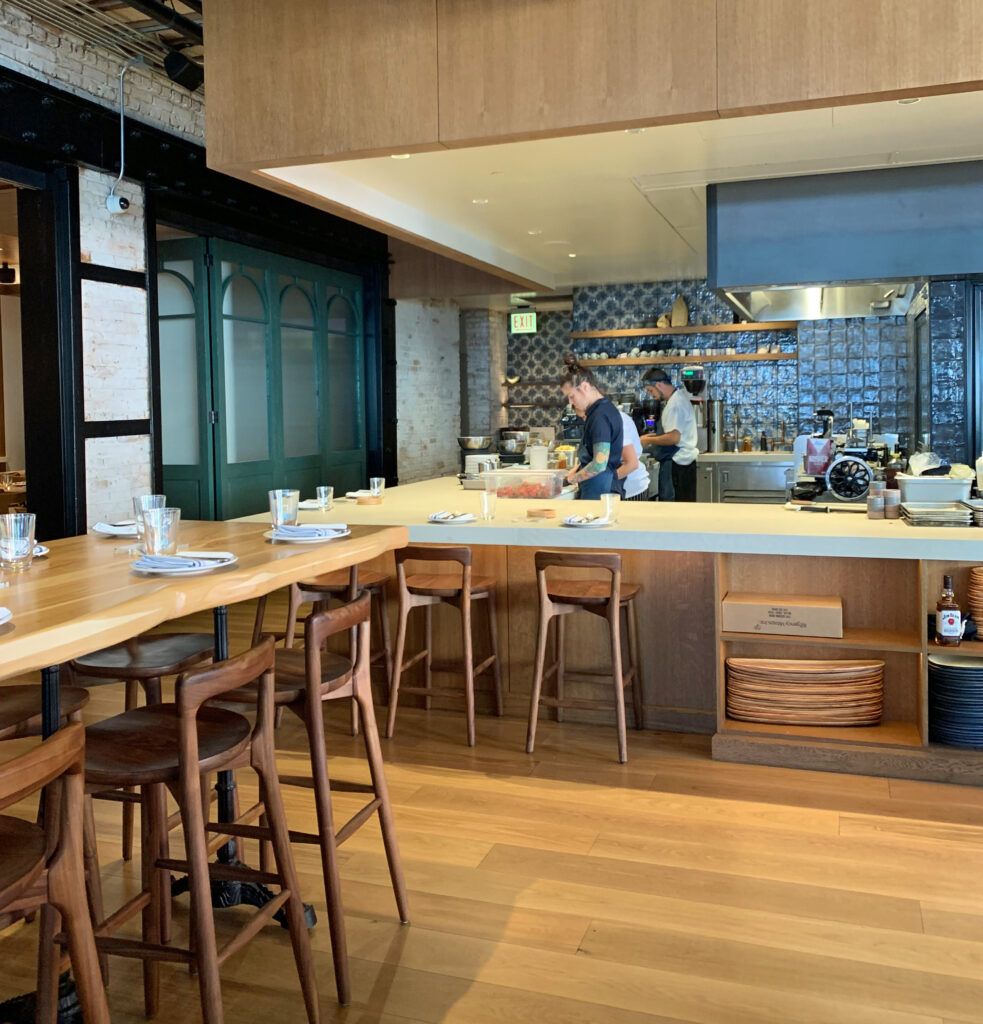
Helping him bridge the gap between novel forms and a familiar shared-plate style of enjoyment is one of the best hospitality teams in the business. (No, not Sancerre—though you credit them for constructing such a beautiful space and, it seems, staying out of the kitchen). Rather, Rose Mary touts one of the most talented assemblages of human capital seen working any floor throughout the city.
Flamm’s history at Spiaggia, without a doubt, put him in the cockpit at one of the city’s high temples for the craft of service. From tableside truffle shaving to the decantation of decades-old Barolo, few surviving restaurants aspired to offer guests all the bells and whistles of top class dining. But Spiaggia’s hospitality, truth be told, was not built upon those high expressions of technique. Rather, they were merely manifestations of an ironclad culture devoted earnestly towards conjuring an incredible guest experience. Busser for busser, captain for captain, and sommelier for sommelier, you never witnessed a false moment. (And that is to say nothing of the chefs themselves, who eagerly brought a bit of magic to each table seated in their dining room).
Flamm was weaned on such a team, and he could not have found a better mentor than Tony Mantuano when it comes to nurturing restaurant culture. For great chefs are judged by their progeny, and you have already mentioned the lasting legacy left by the man whose name is synonymous with Spiaggia. Marea, Lilia, Monteverde, and now Rose Mary do not quite replicate their forebearer in form. Rather, they embody a sensibility that comprises not only the treatment of ingredients but, all the more, human talent. Just as chefs—through relationships with purveyors—express some essence of nature, staff—through the relationship they forge with guests—translate and realize the chef’s vision. At its best, a restaurant breathes a shared vision constructed—each and every night—by the pure expression of many unfettered souls.
Rose Mary does not aspire to Spiaggia’s fabled flourishes or deferential tableside manner, but it retains some kernel of that beloved restaurant’s excellence. Instead, Flamm adds to Rose Mary’s equation, you think, some of that same spirit that has made Girl & the Goat such a stalwart among locals and travelers alike. Izard’s mothership—like Grueneberg’s Monteverde—is both a destination restaurant and a neighborhood joint. It can offer the one-time guest an absolute bacchanalia while maintaining a corps of regulars ever-eager to post up at the bar for a bottle of wine and a few snacks. The experience operates on a sliding scale that can make a given guest’s evening as special or as casual as desired. (Whereas Spiaggia, for all but the most cynical of diners, must have ranked as one of the city’s finest—occasional—indulgences).
Girl & the Goat demands that its line work in perpetual motion to manage the onslaught of orders that flow through the kitchen. Yes, the menu has its “openers” and its “closers”—some rough sense of scale and intensity that looks to avoid spoiling patrons’ palates—but the operation succeeds by a batching orders on the fly so as to keep each table maximally engaged. The front of house staff, too, must be nimble: paying attention to essentials like beverages while pitching in wherever possible to deliver and clear dishes, keeping the show on the road with as few bumps as possible. There’s an unmistakable sense of adrenaline to the whole operation. One might not know exactly how each piece will fall into place but, almost without fail, guests are left marveling at the poise, pacing, and satiation delivered by the staff.
Rose Mary’s service strikes something of a balance between the chef’s two influences. The restaurant’s more refined (than Girl & the Goat) tavern setting demands that its front of house curb the kind of frantic energy that characterizes Izard’s operation. Still, Flamm is offering a hearty menu of shared plates and must find a way to put them out in a timely manner. His staff needs to be sharp-minded, mechanically perfect, yet soft-tempered enough to hold the hands of those for whom the concept of Croatian-Italian provokes skepticism. They need to reflect the sense of homey, rustic hospitality that “Adriatic drinking food” entails without veering off into the disorder that sometimes characterizes popular bars—to say nothing of a city’s trendiest opening during its inaugural summer.
Lucky for Flamm—and, perhaps, with the help of his Sancerre partners—he assembled a crack team. More than a few front of house staff were drawn from Girl & the Goat itself, where BRG—in its lust for profit—unceremoniously ditched an array of longstanding hospitality pros upon reopening. These are operators of the highest order who thrive on imbuing even the busiest dining rooms with those sentimental touches that resonate years later. They’re the caliber of server who cultivates “regulars” from the moment of their second visit—peerless in their ability to place a person and their tastes from memory. Such a towering exemplar of the craft does not only hit all the right notes; rather, they gild the lily through gestures that anticipate—rather than only respond to—customer requests. This is Spiaggia-level service dialed up to Goat-speed. It’s the backbone upon which, more than anything, Rose Mary will succeed wildly.
The restaurant has even, it seems, weathered the departure of its opening wine director after only a couple months in the job. (For Sancerre, at least, that surely beats losing BLVD’s original executive chef before opening). Sarah Traynor built a list centered around “small, emerging producers” showcasing “organic, biodynamic, and sustainably farmed wines” meant to provide Rose Mary with something of a “wine bar” feel relative to Sancerre’s steakhouse concept.
While some of the Balkan wines might be unfamiliar to customers, value largely reigns. Traynor built a strong core of selections that you have enjoyed exploring further with each visit, and there has been a permanence to the offerings (even the niche ones) despite the list’s breadth. Plenty of the bottles—scratching those traditional vinous itches—surely sell themselves. But, among the servers, Rose Mary is lucky to count individuals qualified as sommeliers (and one, even, who ran an excellent beverage program at Michelin-starred Elske) who are more than able to flex deeper wine knowledge when demanded of guests.
Diving more deeply into Rose Mary’s wine list, you are once again impressed by Sancerre Hospitality’s commitment to providing guests a good drinking experience at a fair price. Some selections, in your opinion, are positive steals. The selection is not perfect by any means—there are a few glaring errors that have remained since the restaurant’s opening. But you’ll cut them some slack, for they are operating without any bonafide leadership in that domain and, all the more, they have made the decision—at a structural level—to reward wine drinkers.
While the “Sparkling” section of the list does not impress you at its top end—represented by a 2013 Gaston Chiquet and a Mousse Fils N.V. rosé at $265 and $205 respectively—the L. Aubry N.V. at $140 and Chartogne-Taillet N.V. at $120 offer good relative value. The latter, according to Antonio Galloni, “is one of the best Champagnes readers will find in its price range, or any price range, for that matter.” It is interesting to see a Bründlmayer rosé ($136) from Austria and a Le Marchesine Franciacorta ($107) knocking on the door of the Champagne’s pricing. Sparkling wines from such regions are normally treated as a cheaper substitute for the “real stuff,” but Rose Mary is bold to assert their parity and tout their character.
The half dozen “Pét-Nats” on offer, which each land under $70, provide some of the most hedonistic drinking experiences across the entire selection. Flamm has been said to be a fan of “natural” wines—that nebulous, often controversial term—but these lightly fizzy bottles do the term proud. Made from diverse grapes such as Garganega, Xarel-lo, Gamay, Blaufränkish, and Montepulciano, Rose Mary’s petillant naturel wines combine varying levels of body with exuberant fruit and mouthwatering acidity. The full range, ordered appropriately, can carry you throughout the entire meal—from salad to steak. They put pleasure and refreshment at center stage while still offering a bit more intrigue than beer or cocktails. And you think their easy style fits the Adriatic tavern aesthetic quite perfectly.
The “White” section is smartly divided into the categories “Light(er) Whites,” “Medium Bodied Whites,” and “Full Bodied Whites.” This serves to help steer customers towards unfamiliar varietals whose general character might be unknown, as well as distinguishing among various expressions of shapeshifting grapes. Such a stylistic choice does not go all the way, as does Monteverde (or Hogsalt), in describing each wine with a few words. But it is still consumer-friendly without turning off any snobs.
The “Light(er)” category is quite value driven and features, alongside several interesting Italian varietals, a salty Pošip made in Croatia. Among the “Medium Bodied” offerings, a 2015 Friulano shines at $66 alongside a 2019 “Mont Damnes” (which should, actually, be labelled “La Côte des Monts Damnés” to avoid confusion with the more prestigious site) by Henri Bourgeois for $87. A 2019 “Clos de Bourg” (Clos du Bourg) by Huet is tantalizing at just $90. Though an Eva Fricke “Verde” Riesling at $105 strikes you as a tad highly priced. The “Full Bodied” section serves as a dumping ground for Rose Mary’s expressions of Chardonnay: a Bourgogne Blanc by Francois Mikulski at $82 provides a decent value while Pierre Girardin’s “Les Narvaux” Meursault at $201 is splurge-worthy.
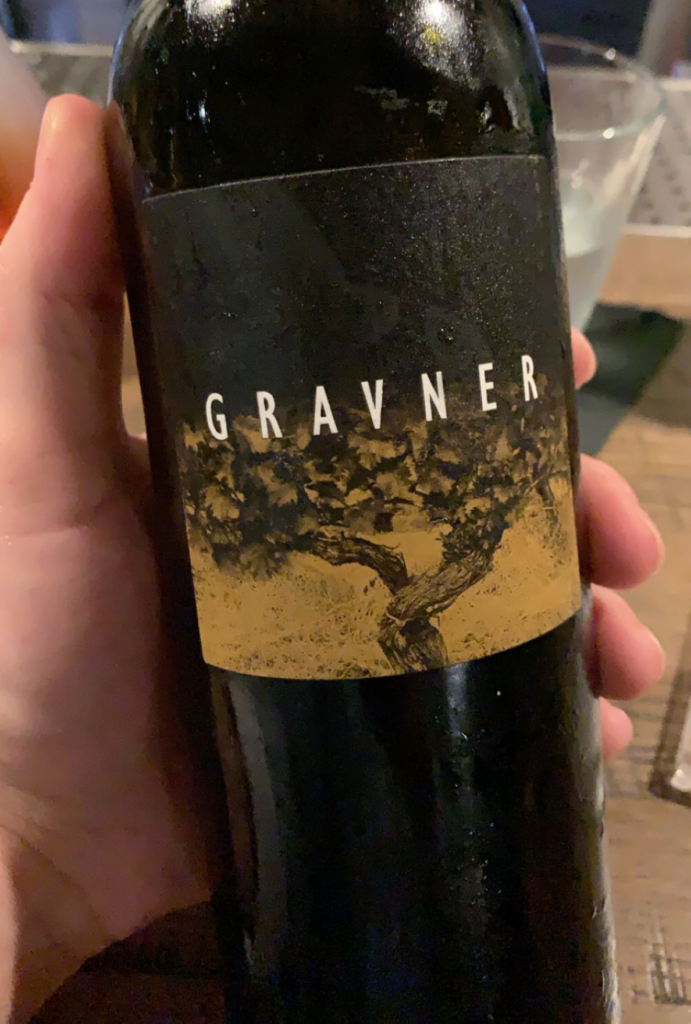
Following the white wines, an “Esoteric” category showcases some further examples of “natural” winemaking through skin-contact “orange” wines. These, certainly, are not as widely accessible as the “Pét-Nats” (some can be quite jarring). But a Slovakian example—“Oranžista” ($69)—made from Pinot Gris proves quite a stunning, vivid wine. And a 2010 Ribolla Gialla from the legendary Josko Gravner—though mistakenly labeled as a 2006—is, perhaps, the one singular wine that speaks most to Rose Mary’s identity. It, like its vintner, occupies the liminal place between Italian and Eastern European traditions that Flamm himself taps in pursuit of novel culinary expressions. A selection of five rosés—priced between $42-$75—also serves to bridge the gap between white and red. It includes lighter examples from Croatia, California, and Italy alongside two deeper expressions from Bandol and the Languedoc.
Rose Mary’s red wines follow the same format as the preceding whites. The “Light(er) Reds” feature a smattering of under-$50 bottles from Austria along with some attractive Nebbiolo, Frappato, and Barbera d’Asti options from Italy in the $50-$80 range. Pinot Noir finds its placement here too. A New World category comprises some nice offerings from Rhys ($125) and Bindi ($162) with a couple cheaper options sourced from Marlborough and Sonoma. Four examples of red Burgundy range from $237-$282 and, while none strike you as particularly stunning options, they come from good producers (Tardy, Damoy, Perrot-Minot, Anne Gros) and feature a bit of age.
A 2008 Mommessin “Clos de Tart” priced at $375 stands head and shoulders above the rest of the wines in the “Light(er)” section. While it looks, at first blush, like quite a stunning deal for a Grand Cru Burgundy, the listing is actually for the domaine’s second wine: a Morey-Saint-Denis Premier Cru titled “La Forge de Tart.” This is something of a grievous error, but the pricing ultimately corresponds to the lesser wine—so it’s hardly a rip off. In your opinion, the 2017 “Tarataci” Etna Rosso by Buscemi ($105) shines as the best bottle in the section and one of the finest on the list. The wine is made from Nerello Mascalese grown from 90-year-old vines planted on volcanic soils and combines fine floral aromas with tremendous energy and deep plum flavor on the palate.
The “Medium Bodied Reds” section features Rhône Valley varietals along with a lovely Gamay by Jean Foillard (priced at $145) and Château Simone’s cult “Palette Rouge” ($150). A Nero d’Avola by Occhipinti ($87), Langhe Nebbiolo by Aldo Conterno ($105), Ghemme Nebbiolo by La Torretta ($83), and Teroldego by Foradori ($102) stand as great values in the category.
However, it is the Barolo and Barbaresco that headline the selection. Truth be told, producers like Guido Porro, Silvano Bolmida, and Bruna Grimaldi do not set you alight—but they manage to fall between $100-$125 (at which point, why not stretch your money further with a mere Nebbiolo). At $177, a 2013 Ada Nada Barbaresco Riserva—with a bit of decanting—could prove quite enjoyable with heavier fare. And a 2010 Oddero “Rocche Rivera” (priced at $270) sits at the top of the pile. It’s fairly priced—given the dearth of aged Barolo in Chicago—and will provide reasonably good drinking at its age. But you think it to be the sort of bottle that—rather than inspiring—simply ticks the box for those who desire an aged example from the appellation.
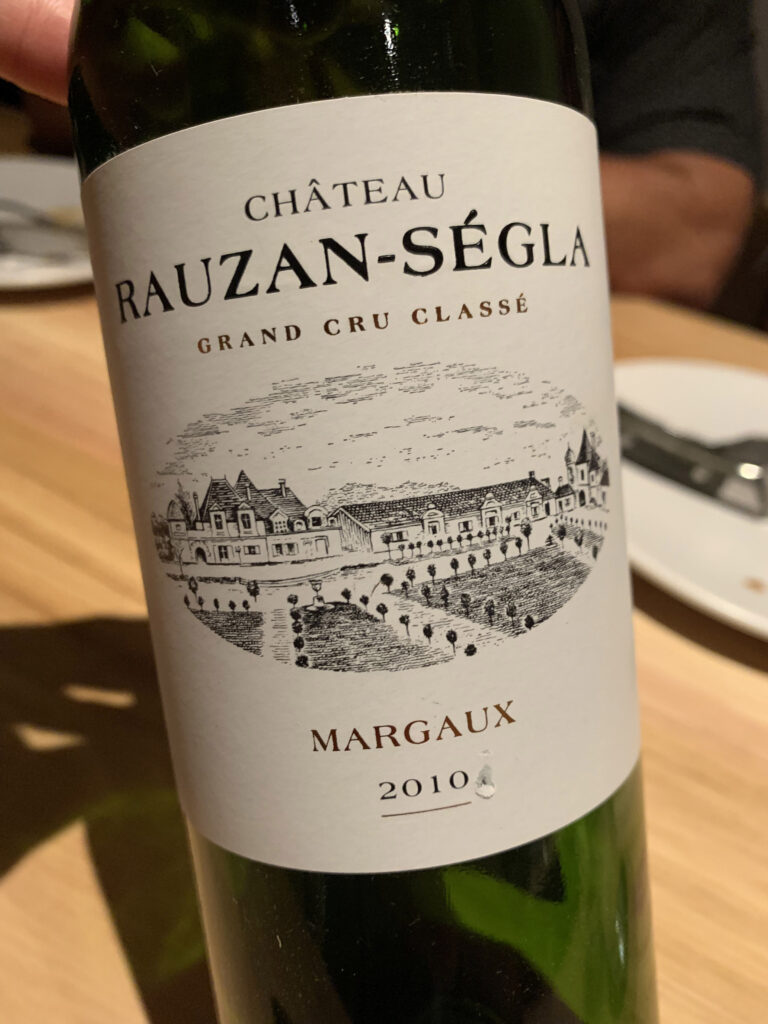
Last of all, the “Full Bodied Reds” features Rose Mary’s Sangiovese (Brunello di Montalcino and Chianti), its heavier Rhône wines, domestic Cabernet, Bordeaux, and a few oddballs. The latter category includes a well-priced 2008 “Tondonia Rserva” ($125), a highly-rated Zinfandel blend from Paso Robles ($165), and a Sagrantino from cult producer Paolo Bea ($375). A 2009 Amarone from Valentina Cubi ($99) and 2017 Cabernet from Matthiasson ($125) prove attractive values for those seeking “bigger” wines. The other expressions of Cabernet—to the restaurant’s credit—remain in the $80-$170 range.
Bordeaux proves the section of choice for those looking for something particularly indulgent. In some sense, they stand as the perfect foil for those who view Flamm’s steak as the sine qua non of the experience (though you bet his lamb would form a fitting partner as well). Despite the usual gouging shown for aged examples of Bordelaise wines, you find the 2008 Cantemerle ($196), 2009 Nenin ($256), 2012 Pontet-Canet ($345), 2014 Pape Clement ($370), and 2010 Rauzan-Segla ($415) to be quite a strong assortment that avoids delving into obscene territory. The more expensive bottles, surely, will continue to evolve for quite a while—making them fine stalwarts for the upper end of Rose Mary’s list. It also bears mentioning that the wine list features two magnums at present. Neither, perhaps, is particularly drinkable—but they certainly show the right intention!
Of course, Rose Mary would not be much of a tavern if it catered only to oenophiles. The restaurant’s “Wines by the Glass” list covers all the classic bases while maintaining a reasonable price range: Prosecco ($14), Lambrusco ($12), Chenin Blanc ($12), Sauvignon Blanc ($15), Riesling ($14), Chardonnay ($17), Barbera d’Asti ($18), and Pinot Noir ($19) form the stalwarts. By comparison, the most affordable options—like the “Cuvée White” blend ($12), Plavac Mali rosé ($10), Plavina red ($12), and Refošk full-bodied red ($17)—are sourced from Croatia.
The country’s fledgling oenological reputation, no doubt, ensures that its wines can be attained at competitive prices relative to other regions. Nonetheless, channeling customers seeking value towards varietals which express some dimension of the restaurant’s cultural identity is something Flamm should be proud of. It enriches the restaurant’s sense of place while educating drinkers on an up-and-coming wine scene. And, relative to spending a couple dollars more for a humble expression of a more familiar grape, the Croatian wines offer more singular character along with the same direct sense pleasure. In effect, it steers guests’ “default choice” towards broadening horizons without punishing those who are more particular.
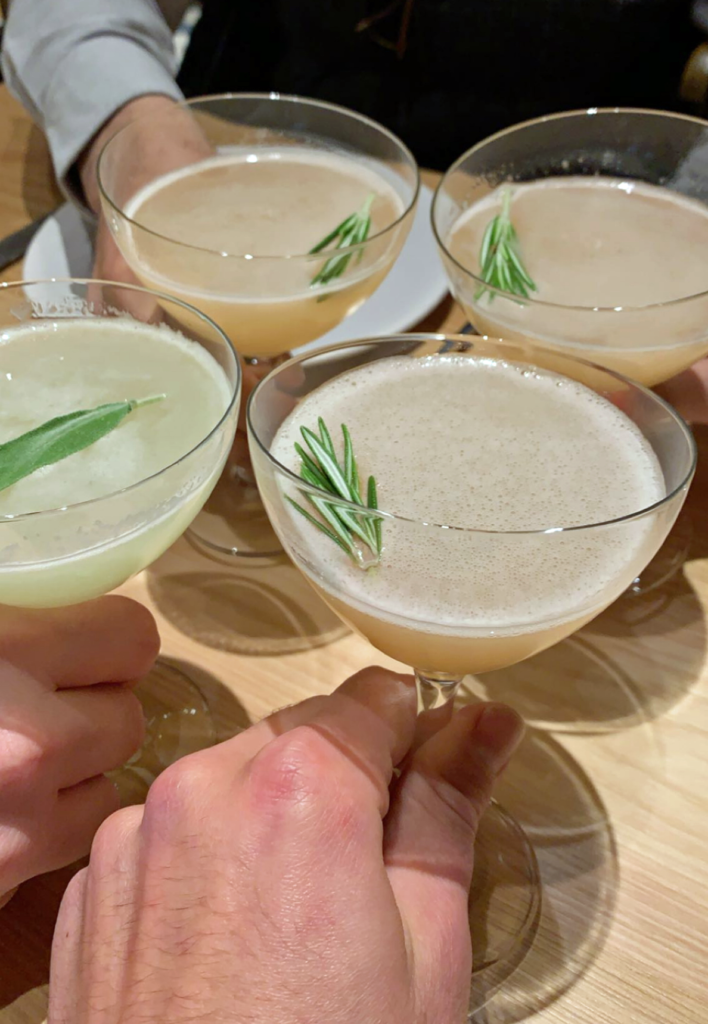
The program developed by Jen Newton—Rose Mary’s beverage director—is certainly worth a look. Out of five signature cocktails, the Golden Negroni is, no doubt, the headliner. The addition of Maraska Kruskovac (a Croatian pear liqueur traditionally served at weddings in the former Yugoslavia) lends the drink its beautiful hue. That golden sheen—and the negroni’s impeccable balance (achieved through the addition of Cocchi Americano and Luxardo Bitter Bianco)—make it something of a totem for the restaurant. However, you will also single out the Plum’s the Word for its excellence. That cocktail combines white rum with Maraska Silvovitz (a plum brandy made by the same distillery), Apologue Persimmon liqueur, and Grand Marnier. Once again, despite bringing together such a panoply of elements, the drink maintains a refreshing quality that allows its complexity to shine for a wider audience.
To that point, you would characterize Newton’s program is intelligent enough to appeal to cocktail nerds without turning off the average imbiber. Her vodka cocktail (with St. Germain, cucumber, and lime), tequila cocktail (with Strega, Aperol, and grapefruit), and whisky cocktail (with Amaro and fig) do not veer too far off into left field. And Rose Mary’s three spritzes—“Floral” (vermouth, honey, lemon), “Botanical” (rose liqueur, vermouth, olive), and “Fruity” (orange gin, Luxardo Aperitivo)—offer drinks of a lighter style but plenty of character. (Personally, they have not been to your taste but are certainly thoughtfully conceived). The staff behind the bar is every bit as friendly as the servers, and they’re talented to boot. Upon request, you have found that they make one of the very best espresso martinis in the city (a drink that, in the wrong hands, can taste absolutely abominable).
You typically start the meal off with a Golden Negroni then segue smoothly into a bottle of “orange” wine (Oranžista or Gravner) and the Buscemi “Tarataci” to finish the meal off. Even without a wine director or specialized sommelier on the floor, Rose Mary’s front of house handles beverage service impeccably. Bottles are opened in due time and decanted or chilled as needed. Stemware, of course, is never allowed to sit empty while, at the same time, servers do a great job of ensuring your red wine reaches the table in time to pair with meatier fare. The restaurant, naturally, is not opening the sort of bottles seen at Spiaggia; however, it does aspire to a higher level of wine service than fellow tavern Girl & the Goat (where the presence of fine wine was a bonus but not, strictly, part of the place’s identity—made clear by the stemless glassware).
Beverages ordered, you turn your attention to the main event: Flamm’s menu. Rose Mary’s bill of fare comprises five categories: “Vegetables,” “Pasta,” “Risotto,” “Fish,” and “Meat.” This overarching structure is reminiscent of Girl & the Goat’s format—and, surely, other “shared plates” restaurants. However, while some such establishments group their selections solely according to size—“small,” “medium,” and “large” headings each running a gamut of preparations—Rose Mary’s more specific subheadings steer guests towards building a balanced meal.
Within each category, the dishes are—indeed—still listed in ascending order of heft. This ensures customers retain some subtle form of guidance when deducing what amounts to a requisite number of items. But the dual filter of vegetable/fish/meat then size entices guests to pick the most appealing preparations from a progression of types rather than, potentially, overlook greener options in favor of the most seemingly decadent fare across generalized sections. (You, certainly, are guilty of following the latter form of logic in a bid to try all a restaurant’s “best” items on a first visit. Meat and fish, if merely by nature of being more expensive, simply read as being more “serious” and representative offerings for purposes of evaluation).
Of course, nothing stops guests from going all-in on pasta or forming a carnivorous feast of chicken, duck, pork, beef, and lamb. But missing out on Flamm’s vegetable preparations would be a travesty, and—however good the chef is at making pasta by hand—he knows something about risotto too. The format of Rose Mary’s menu encourages guests to appreciate just how deep the restaurant’s quality runs. And it provides the kitchen with an essential amount of discretion in designing just how all the pieces of each order will fit together during the course of the meal. These unforeseen synergies lend the experience a sense of surprise and discovery. They construct, as with so many other elements, the feel of a bustling tavern. And they ensure your tongue remains wagging until the very moment you cannot eat yet one more bite.
Even though dishes from each of menu categories are sure to comingle on the table at the same time, you will proceed in your analysis by tackling each section one by one. In this manner, as stated above, customers can best shape their meal to accommodate the greatest number of appealing items irrespective of their size. (In truth, only a few dishes are substantial enough to inhibit a broad survey of the menu).
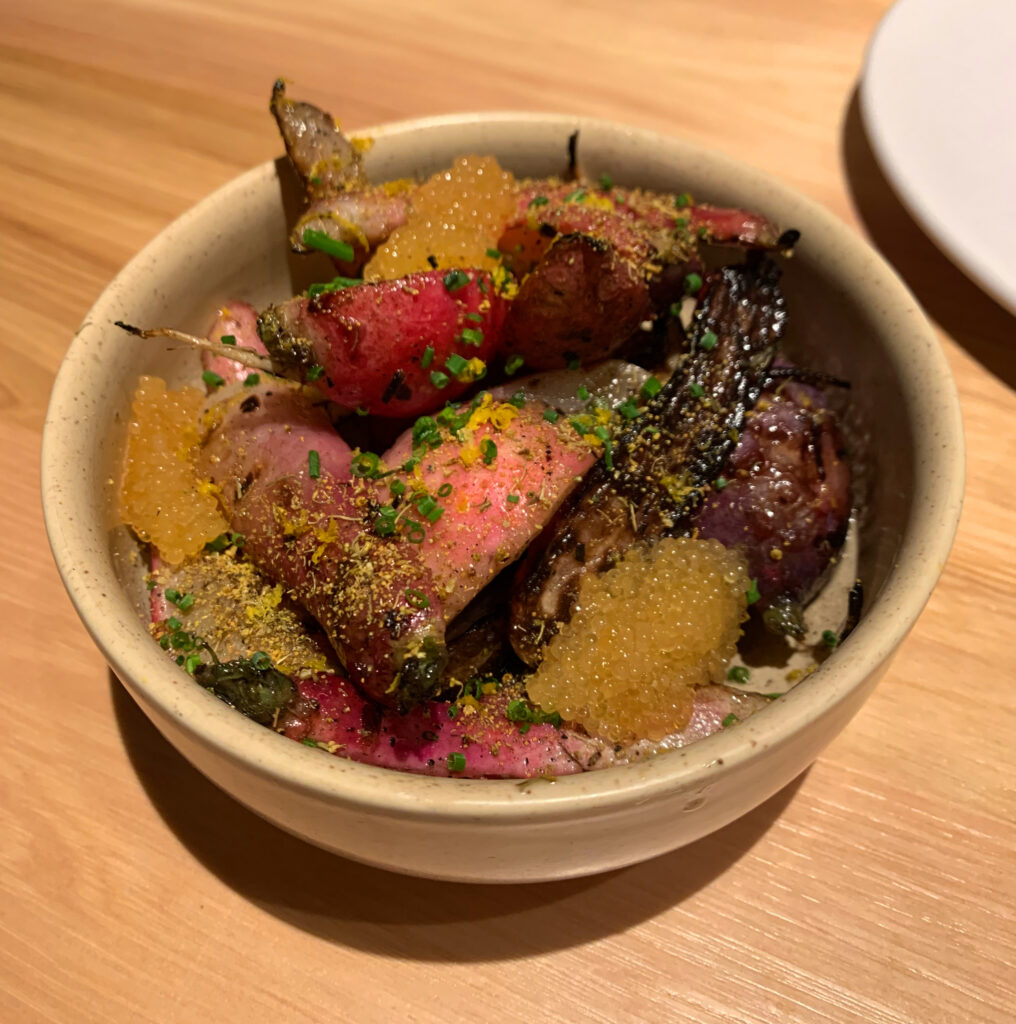
Starting off with the “Vegetables,” Flamm’s dish of grilled radishes might be the only “dud” on his menu. The roots are cooked tender—with just a bit of char—and lent a luscious mouthfeel via the addition of fennel pollen butter. A tinge of orange and gorgeous, golden orbs of whitefish roe add both a burst of flavor and an attractive visual accent to the dish. But, no matter how you dress them up, radishes maintain a bland, dense flavor profile that is hard to overcome. You were no fan of Daniel Humm’s buttered radishes at NoMad—despite the praise they received—and Flamm’s leave you feeling the same way: why try so hard to help an ingredient that has so little character of its own to give? Why damn those excellent accompanying elements of fennel pollen and roe to the Herculean task of putting “lipstick on a pig”? Radishes do seem to factor in a Croatian salad meant to accompany grilled fish, but, as an opening bite, this preparation signals a dearth of flavor that runs opposite the rest of Rose Mary’s menu.
Thankfully, Flamm’s zucchini fritters make everything feel okay. Though the recipe has not changed since opening, the dish’s execution has only grown better. What were once slightly flatter, softer potato pancake-like discs have grown crisper, crunchier, and a bit more rounded like their namesake fritter. Of course, their substance has always been excellent: the zucchini possesses a slight natural sweetness that shines through the addition of parmigiano and pine nuts. An accompanying pesto aioli has an attractive pastel hue—and it cuts through those savory flavors while also serving to cool the fritters’ steaming interior. In its current craggy, dark brown form, the dish is a must-order (and a testament to the manner in which Rose Mary refines recipes that are already quite good to begin with). It’s fried “drinking food” that draws on a deeper vegetal flavors while offering a texture that ensures nobody misses the potatoes.
Out of three salads offered on the restaurant’s menu, the coal-roasted beets are the only to have retained their essential form. However, as with the zucchini fritters, you have noted the extent to which Flamm has mastered his principle ingredient’s texture over the past few months. At first, the beets were smooth—almost slick—offering a clean bite with a marinated sour finish. They were tossed among (but not entirely coated with) kajmak (a rich, unripened cheese), pistachios, and honey. Later iterations of the dish have seen the beets roasted to a glistening hue in which their skins have begun to contract and form slight ridges. (Some even tout charred tips). The more ample roasting ensures that the beets melt the kajmak into more of a cream, leading to bites where the roots’ lap up a coating of the cheese which—along with the honey—allows a film of powdered pistachio to develop. That resulting bite—tangy, nutty, sweet, and sour—is divine. And the beets’ interiors remain every bit as tender as when they were more gently treated—benefitting all the more from the layers of blistered skin, kajmak, and pistachio.
The stracciatella—a dish centered around the shredded buffalo milk cheese of the same name—has gone through two main iterations. Both paired the strands of fresh, tangy cheese with a puddle of olive oil, a few drizzles of balsamic, and some leaves of basil. However, while the spring/early summer version drew on strawberries for brightness, the current rendition makes use of blueberries that lend the dish a darker fruit characteristic. You think, perhaps, that bursting into the latter addition offers a more pleasant mouthfeel. But both variations stand as a testament to the modular, seasonal manner of cooking Flamm has constructed. The exact form of the accent—in this case, a fruit component—might change, but the dish’s fundamental form proves well-conceived. It gets to show a different dimension as new pieces fall into place.
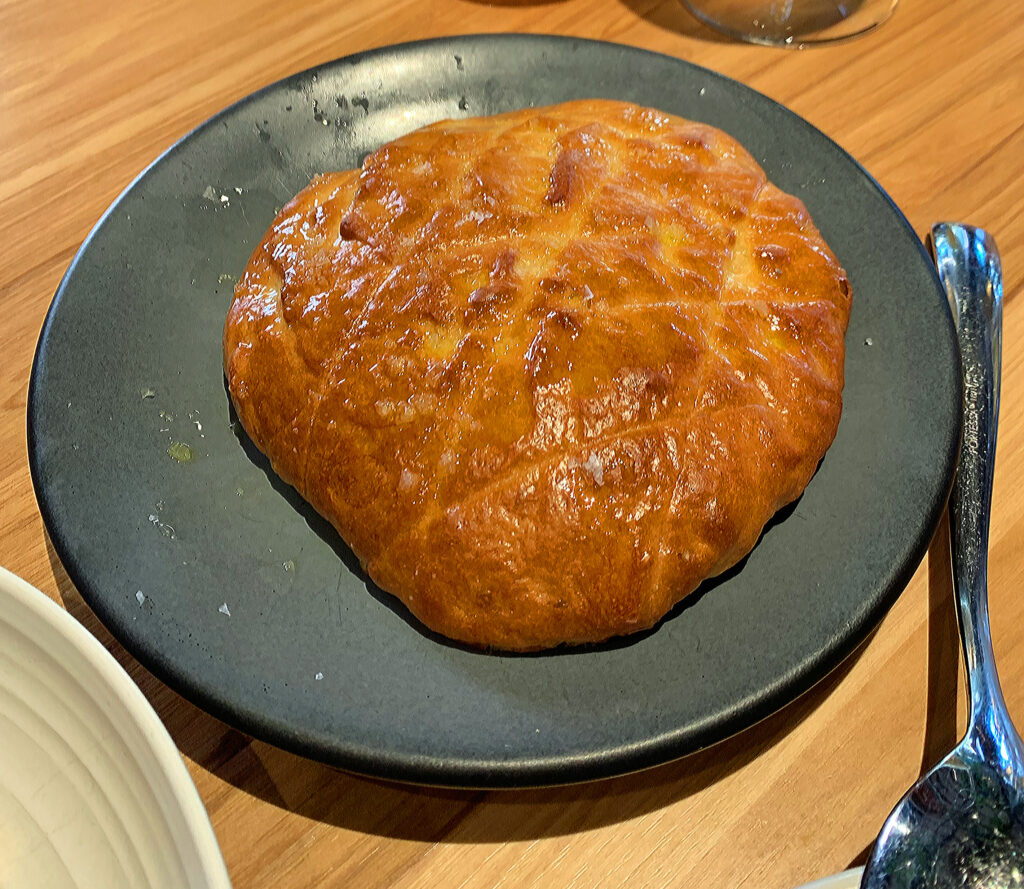
And the stracciatella also marks the first appearance of pastry chef Hillary Grossman’s lepinja, a Balkan flatbread that boasts a fluffy interior and glossy outer crust. It is not as airy as the premium pitas slung at Galit, but the bread possesses a robust quality that can soak up plenty of liquid while still amply sandwiching various fillings.
Originally, Rose Mary’s menu featured a Pinzimonio salad in the next spot. The dish referenced a tradition that dates back to the Renaissance banquets in which centerpieces of sliced vegetables were paired with a light dressing to be eaten at the beginning and end of the meal. If it sounds something like crudités, you are not far off. Flamm’s rendition featured thinly-sliced radishes, beets, and snap peas in an “herby bagna càuda” (that is, a cold version of the hot garlic-anchovy dip eaten in Piedmont). The salad was highly textural and rather cleansing in its character, but it never really sang. It might have been something of an offering to the vegan crowd—or just a means to shine a spotlight on Rose Mary’s vegetable sourcing—but excising the Pinzimonio proved a savvy move.
In its place—only recently—has arrived a salad of grilled cucumbers and red onion served atop a sundried tomato pesto with a beautiful, burnished tone to it. Black garlic, pecorino, and hazelnuts form the rest of the dressing—an incredible triumvirate of savory flavors that overcome the latent blandness of the unpickled gourds. Being grilled, the cucumbers are a little less watery and slightly softened. However, they retain a light crunch that—in some sense—speaks to the “crudités” inspiration seen in the salad’s predecessor. Relative to the Pinzimonio, Flamm’s grilled cucumber salad bursts with far more depth of flavor and a greater variety of crunchy textures. The dish retains something of a cleansing characteristic, but it rewards customers with an assemblage of powerful savory notes that tickle the palate with anticipation for the more robust preparations to come. Flamm did well to sub this salad in.
The next salad—in its first form—featured golden tomatoes, farro, and asparagus. In its second form, the farro remained, the tomatoes reverted to a classic reddish hue, and apricots replaced the asparagus—lending the dish their own yellow-orange color. Both renditions paired their ingredients with a shallot vinaigrette and thin sheets of ricotta salata—a crumbly number made from sheep’s milk that some call “the anchovy of the cheese world.”
Version #1 of the salad was carried more by its sweeter golden tomatoes. The chew of the farro, crunch of the asparagus, and mouthcoating crumbliness of the ricotta were highly pleasing. But it took the large, gushing chunks of tomato to refresh the palate due to the light touch of the shallot vinaigrette (which, you think, reflects a conscious choice for the salad’s constituents to harmonize as they are chewed together). Version #2 saw the ricotta crumbled a bit more finely, as well as the addition of some flat-leaf parsley. The red tomatoes struck you as a bit softer, meaning that the course’s overall sensation was a bit less crunchy. Of course, that has something to do with the apricots, whose tartness offers an added dimension of flavor relative to the asparagus’s textural aptitude. Considering the relative crunch of the beets and the cucumber salad, you prefer the version #2. The chew of the farro is accentuated by the more softly textured accompaniments, and the grain shines all the more through the sweet-tart-savory balance of tomato, apricot, and ricotta.
The last item within Rose Mary’s “Vegetables” category—titled Prosciutto—has not, to your knowledge, changed at all. It hasn’t needed to, for the dish represents a glorious hodgepodge of so many of the section’s ingredients. First, you take the lepinja (from the stracciatella dish) cut it in half, then in quarters, with the glossy crust facing down. Then you top it with the titular aged Italian ham, some peas (and pods, as featured in the former Pinzimonio), pecorino (as seen in the cucumber salad), and ricotta salata. A hearty drizzle of olive oil, cracked pepper, and some fava beans complete the construction, which calls to mind the kind of late-night sandwich you cobble together from whatever might be left in the fridge. Flamm’s dish, of course, is much more elegant: the thinner slices of cheese and pea pods form one texture, the peas themselves and the fava beans another. The chew of the prosciutto—along with its dose of salty goodness—brings the varied ingredients together in what is quite a pleasurable handheld bite. It really does, in its pleasantly heterogenous texture, call to mind a folded “cold cut” indulgence.
Flamm’s “Fish” section starts with a flash of simplicity. Cherrystone clams are grilled and served eight or nine at a time, on the half shell, with a small dab of smoked ramp butter—that’s it. While the tendency in many casual Italian restaurants is to dress the quahog up with breadcrumbs, cheese, and oregano to extend the amount of sustenance it may offer, Rose Mary has tailored a lip-smacking bite that belies its size. The smoked ramp butter does not only impart a gorgeous green halo around the clams, but it resonates with a deep, sharp garlic-and-onion flavor that imbues each small bite of seafood with an outsized presence on the palate. That “smoked” quality, too, really amps up the perception of the bivalve’s savoriness. You slurp shell by shell, take a couple chews, and feel that lovely tickle on your palate. It leaves you reaching for a gulp of white wine and desperate for the next dish to arrive—a great representation of so-called “Adriatic drinking food.”
The next dish, Rose Mary’s take on a tuna crudo, goes the opposite route. While the clams were dressed down, the fish gets dressed up. The usual light touch of olive oil that characterizes a crudo is substituted for a weightier veal aioli. The typical citrus notes that enliven such a raw preparation are exchanged for a shallot-beef fat vinaigrette. And, just to be sure his variant will never be outdone for want of umami, Flamm garnishes the plate with a handful of crispy capers (along with some chives and parsley too). It’s a clever inversion of vitello tonnato in which tuna is flavored with veal sauce (rather than veal with tuna sauce).
You think the crudo might prove a controversial dish for those who are salt averse, but you quite like it. The slices of tuna—typically four long, wide strips—dwarf those in almost any other version of the dish you have seen. Flamm is not trying to offer a dainty bite that goes toe to toe with actual sashimi. Rather, he has crafted a mouthfilling expression of tuna that showcases the beauty of the fish’s texture while extending and enhancing its natural umami qualities with a little bit of help. Are the veal aioli and beef fat vinaigrette overkill? You think they are delightfully intense, and they work to build a particularly pleasing bite where purity of tuna flavor is not quite the focus. The capers play double duty—further amping up the savory while also serving to contrast the softness of the fish. While early versions of the dish surrounded the tuna with aioli, the current plating allows for greater control of how much sauce one imparts. This decision should help moderate the dish’s powerful flavor for diners who might be sensitive to such a superlative expression of richness. But in your opinion, the crudo—along with the clams—form a perfect start to any meal at the restaurant.
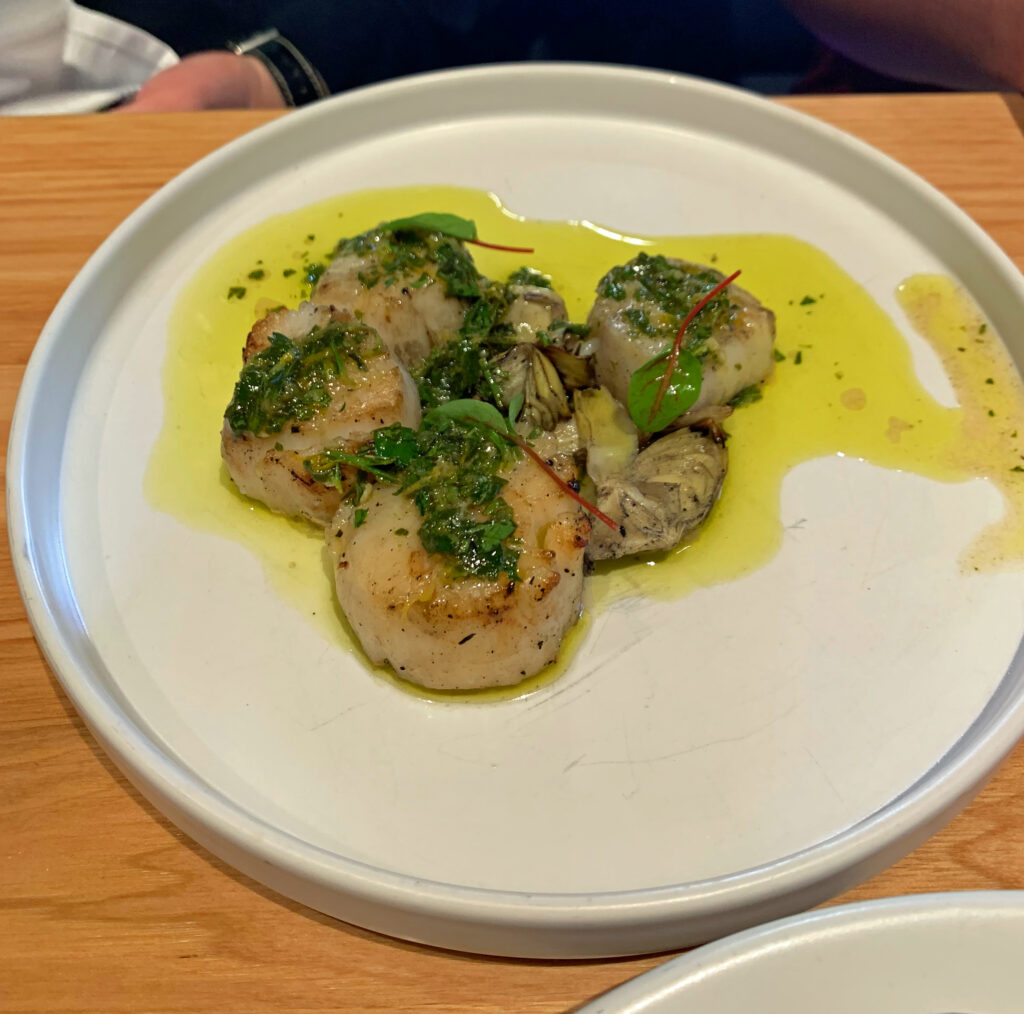
Following the tuna crudo, Rose Mary once offered a dish of grilled shrimp that was, frankly, forgettable. (To wit, it might be the only item which, across all your visits, you neglected to photograph). As best as you remember, the shrimp were tender and seasoned with a buzara sauce that, in effect, did little to distinguish itself from a classic scampi (olive oil, wine, garlic, herbs, and breadcrumbs). Flamm did a serviceable job with the dish, but that is simply not enough in a city where Shrimp de Jonghe once reigned supreme. It was simple but not distinguished, and its successor would prove better-suited to the role.
Flamm replaced the shrimp with four medium-sized scallops roasted until tender (but not aggressively browned). They are paired with baby artichoke—the ingredient’s only appearance on the menu thus far—and a burnt citrus salmoriglio, a classic Sicilian sauce made from lemon, garlic, olive oil, and herbs. The name of the sauce translates to “little brine,” and you’d be forgiven for thinking that it is essentially an emulsified marinade. However, the salmoriglio succeeds in accentuating the pure flavors of the scallops and artichokes (which also love lemon) with a far lighter touch than the scampi that came before it. Drawing on burnt citrus adds a unique, complicating note that counteracts any need to harshly sear the mollusks in order to impart some char. It helps the scallops retain a more delicate, buttery texture that defines the preparation. While one of Rose Mary’s less interesting dishes, it is well executed and fits the bill for a simple, shareable, but somewhat luxurious offering from the “Fish” section.
The next dish follows in much the same style: a piece of seafood treated with care so that it might unveil the full extent of its character. In this case, Flamm deals with baby octopus—the cephalopod whose preparation without any remnant of chewiness stands as one of the hallmarks of a great chef. He prepares the tendrils “peka style,” referring to an ancient technique in which meat, vegetables, or seafood are slowly braised with olive and wine in the eponymous domed clay cooking vessel. The method’s gentle nature ensures the octopus achieves perfect tenderness while absorbing all the aromatic elements trapped under the lid. The garlic, potatoes, and peppers it is cooked with sop up all the juices and display a stewed quality that matches the tendrils’ texture.
While early versions of the dish opted for larger chunks of potato and octopus, you have found greater pleasure in its current rendition. There, longer lengths of the cephalopod melt in your mouth like noodles while thinner bits of potato and pepper provide both body and a burst of the peka vessel’s braising liquid. Some stemmy lettuces, too, now provide a crunchy element that contrasts all the yielding textures at hand. The most recent iteration of the dish—that you tried only last evening—looks as if it could have come from Spiaggia’s kitchen. Its presentation has been refined to the point of elegance (rather than rusticity). Properly cooking octopus forms the mark of any Mediterranean restaurant, and Flamm’s recipe displays his technical skill while featuring a captivating form of cooking from Croatian tradition.
Closing out Rose Mary’s “Fish” category is a preparation of branzino that has greatly improved over the past couple months. The European bass is a mainstay of Mediterranean menus—and almost something of a trite fixture across all varieties of seafood restaurants these days. What more can one really do to distinguish the fish than grill it well and garnish with lemon? Flamm opts for charred lemon, a fine conceit, along with softened fennel and a “paprikas sauce” that calls Hungary to mind but, surely, spans the Balkan region. During your first visit, you found the branzino cooked well enough—its flesh soft and slightly flaky—but the sauce somehow both watery and bordering on sickly sweet. The dish was characterized most be the crunch of the fennel—which you enjoyed—but the overall impression steered you away from ordering the fish again in favor of other large plates.
However, on your most recent visit to the restaurant, you had the chance to try the branzino again. Its skin was grilled to a darker finish, and it lifted off of the fillet—in a feat of excellent butchery—cleanly. The flesh was more succulent—the flakes easily separated by only the edge of your fork. The “paprikas sauce” displayed a darker color than before and resonated with more of its namesake spice. With a bit of lemon squeezed on top, the mild branzino came alive with a balanced interplay of sweet, tangy, hearty (through the addition of tomatoes in the sauce), and lightly charred flavors. The fennel, of course, still provided a pleasing crunch. But you can say that Flamm transformed his fish dish from a flop into something you will now routinely order. (You really think the sauce’s change in tone says it all).
As you move on to Rose Mary’s pasta dishes, you will look to avoid treading the same ground as your previous article. However, it is worth noting that the pastas featured therein have already seen some slight changes since the time of publication.
Flamm’s Spinach Cappelletti has seen its original parmigiano fonduta replaced by a sauce of brown butter and an ample grating of cheese placed atop the pasta. Compared to the fonduta’s thickness, the brown butter does a better job of accentuating the little hats’ mouthfeel. Naturally, it possesses a pleasing intensity of nutty flavor that forms a perfect partner to the accompanying shaved truffle. And the parmigiano, no longer just melted into the sauce, shines all the more by offering the al dente pasta a crumbly textural contrast. (The most reason version of the pasta’s preparation, which you have yet to try, adds Sungold tomatoes and a tomato passata to the mix too!)
The Tagliatelle—with duck sausage, rapini, parmigiano, and chili flake—has now become a Spaghetti dish that features all the same ingredients. While the thick, “cut” ribbons of pasta offered a pleasing breadth on the palate, their width—truth be told—came close to matching that of the sausage chunks. Simply changing the tagliatelle to spaghetti has ensured that the chew of the duck shines against the smaller imprint (and greater chew) of the rounded noodle. The crunchy strands of rapini, too, seem to work better with this preparation. After only a small reconfiguration, the combination of meaty, bitter, nutty, and spicy flavors has started to shine as one of Rose Mary’s very best dishes.
The Cavatelli “Cacio e Pepe” tells the very same story. All Flamm did was exchange the shell-shaped pasta for radiatore (a wide, ridged shape that resembles an actual radiator coil) and magic happened. For, while Rose Mary’s Gnocchi stands as a testament to pasta’s tenderness, the Cavatelli wasn’t quite so melt in your mouth. Nor did that shape do very much to accentuate the decadent cacio e pepe sauce. The radiatore not only possess a wonderful chew, but their grooves do a great job of capturing the thick, cheesy sauce. This serves to release an added dose of richness as one masticates, making for a superb pasta that one can truly savor one bite at a time.
Of all the tweaks you have witnessed across your visits to Rose Mary, the preceding changes to its pastas stand as some of the most consequential. While Flamm has been billed as a master of the form, he is in no way above embracing a fundamental structural change that would better allow his ingredients to sing. It is incredibly rewarding to see his recipes come to fruition through the vehicle of an alternate pasta shape, and those oblivious to the menu’s dynamic, ever-improving quality are missing a large part of the story. Cooking, particularly of this seasonal Mediterranean style, is a process of discovery. Subtle adaptation and refinement must be prized over readymade recipes that sit, unchanged, for months or years at a time because they are judged “good enough.”
When it comes to risotto, Rose Mary does that delicate form proud. And, as with his handmade pastas, Flamm has sought to refine his rice preparation over the course of your visits. Early examples were a bit more loosely textured—the sauces paler and, dare you say, a bit watery. It’s the same old story as the zucchini fritters or the branzino, and the restaurant must be commended for improving their execution over the course of time. Growing pains are acceptable—“good enough” definitely isn’t. And Rose Mary’s risottos now uniformly feature a tighter network of rice grains that pleasantly caress the palate. Their sauces are darker and more concentrated, lending dishes of such delicacy an ample punch of flavor.
The restaurant’s signature risotto is undoubtedly the “Skradin” (after the Croatian town of the same name). There, Skradinski rižot is prepared over 10-12 hours from “veal rump, a bit of ham, some beef, onions, a bouillon of capon, rooster, or beef, and rice” that is finished with nutmeg and grated cheese. Flamm simplifies his version just a bit, combining veal breast and chicken thigh with a tomato-based broth and plenty of parmigiano. The pieces of meat are served on a skewer—offering diners a few delightful nuggets to much on. Meanwhile, their combined flavor lends the rice a doubly savory depth of flavor that forms a fitting partner with tomato and parm (surprise, surprise). The rice is creamy—and the flavors robust—in a manner that makes fine dining’s truffle risottos seem wimpy. Some might say the Skradin lacks restraint, but it smacks of pleasure—and that seems to be Flamm’s goal throughout the menu.
The “Crni” risotto takes its name from the crni rižot (black risotto) popular throughout the Dalmatian region. However, while traditional recipes make use of cuttlefish (and their ink), Flamm does the job solely using squid—perhaps a more approachable cephalopod for Chicago. The skewer that arrives, on this occasion, boasts a couple well-charred pieces of the squid’s mantle along with one crispy piece made mostly from the arms. Its ink, of course, is mixed into the rice to lend the dish that striking black color. But the chef’s real innovation comes from basing his sauce on a mixture of lobster brodo and tarragon. Anyone who has worked with squid ink knows that its impact is purely cosmetic. Thus, drawing on those classically herbed flavors of lobster infuses the rice with a luxurious flavor that stands distinctly on its own from the crni tradition. Guests can enjoy the color and chew of squid, but they are treated a more complex shellfish essence as they enjoy their rice bite by bite.
The third risotto began as “Ramp” (with grilled trumpet mushrooms and pecorino) then later transformed into “Pesto” (with swiss chard, roast onion, pickled carrots, and parmigiano) in accordance with ramps’ painfully short season. While the former version boasted a pretty pale green sauce and an attractive garnish of mushroom slivers, you think the ramps shone more brightly when placed opposite the grilled clams. Of course, it is hard to resist using the ingredient when it is in season. However, as a distinctly savory preparation—lacking any particular twist—the “Ramp” risotto read as a vegetarian option rather than an opportunity for creativity. The “Pesto” replacement solves that problem by balancing more robust vegetal flavors with a hint of sour and crunch from the pickled carrots. It still displays ample richness in the same manner that “Skradin” and “Crni” do, but the greenness is more forceful. It offers a counterpoint to—rather than merely being a substitute for—the other risottos. (And a Midwest Roast Corn risotto—which has recently replaced the “Pesto”—promises to be an even more pleasing preparation).
The closing category of Rose Mary’s menu—“Meat”—is an ode to decadence. You’ll find no lousy tartares or piddly little servings on skewers here. Flamm aims to please those with a carnivorous craving, and he does so with overwhelming force.
Chicken wings, of course, are right at home in the tavern setting. Rose Mary’s are grilled then made “Adriatic” through the addition of a Calabrian chile and basil vinaigrette. That “sauce” is worlds apart from the sappy, sticky substances that characterize everyone’s favorite wing specialists. Honestly, as excited as you were to sink your teeth into drums and flats at such a trendy restaurant, your first experience left you cold. The chicken was tender but not distinctly crisp, and, while that texture might have been fine, the vinaigrette added only a mild heat backed by a dominant note of basil.
But, as with so many other dishes, Flamm’s team quickly found a way to make all the pieces fit together. By the second time you tried the wings, they touted a beautifully charred crust. They were still every bit as tender; however, they now possessed a triple-layered texture of basil leaf, crispy skin, and succulent flesh. All the more, that touch of burnt character from the grill accentuated the smoky character of the Calabrian chile. The vinaigrette now struck you as better balance—a bit of heat, a bit of smoke, and an herbaceous finish that emphasize the pure essence of barbecued chicken. Surely, good wings aren’t rocket science. But the restaurant has nailed the recipe, and the dish—consistent in its execution—has become a fixture on your table across subsequent visits.
The “Beef Burek,” on the other hand, has been a smash hit from the start—and a preparation pastry chef Hillary Grossman should be proud of. Burek (or Börek) is a form you were unfamiliar with, but one that other guests might know, in some form, from its Turkish, Bosnian, Serbian, or myriad other versions throughout the Balkans. The dish has been dated to the Ottoman Empire and—in its simplest use of the term—refers to “a family of baked filled pastries made of thin flaky dough known as phyllo.” The exact shape of the dough and the constituents of its filling change from country to country. But, suffice it to say, the Croatians are big fans: burek has been called the country’s “adopted national street food.”
Rose Mary’s rendition takes the form of a tightly-coiled phyllo dough filled with beef, onions, and mozzarella. While the earliest version was a bit bulkier, the current execution is compact with a nicely browned, glossy finish. Phyllo, of course, is known for its flakiness, and the burek offers a lovely sense of crispness without any unwanted disintegration. You simply want to savor a pastry with such a superlative texture, and the timeless filling of meat, onion, and cheese ensures that the dish’s form—itself—is the star. Some might decry how basic the combination is, but the beef is tender and richly flavored, the cheese is well-melted, and you find yourself increasingly tempted to order a separate burke for every member of your party—it’s that good. (The term “highbrow Hot Pocket” has been thrown around in describing the dish, and you cannot deny that it touches on some dimension of that childhood nostalgia for those uninitiated to the pastry’s tradition).
The next dish in the section stands, in your opinion, as the absolute best use of that lepinja flatbread Grossman makes (and that appears beneath the “Prosciutto” as well as alongside the “Stracciatella” dishes). Here it stands as the perfect vehicle for a Croatian take on the sausage sandwiches eminently eaten throughout Chicago. “Cevapi,” the title of the dish, refers to a kind of caseless sausage made throughout the Balkans—typically a blend of beef, lamb, and onion with other ingredients like garlic and paprika appearing. Flamm ensconces his links within a hollowed out lepinja and surrounds the meat with ajvar—a sauce made from roasted red peppers and eggplant—kajmak (the same unripened cheese from the beet dish) and red onions.
In its original form, the cevapi arrived as one wholly-constructed sandwich in which the layers were beautifully arranged to offer the perfect bite after bite. It’s the sort of thing Flamm could have made a killing selling from a window facing out at the street, but—only recently—the chef opted for an alternate presentation that encourages sharing. For, however nicely the sausages were tucked into their pita blanket, taking a knife to the dish inevitably smeared its innards all over the plate. Now, guests are presented with a lepinja cut into quarters. They can take one of four, appropriately-sized links and construct their own flatbread pocket using ramekins filled with the ajvar, kajmak, and red onions. Though you will dream of the days you can once again gorge yourself on your own fully-stuffed lepinja, the dish is excellent whatever way you slice it. Like a gyro meets a sausage sandwich, the “Cevapi” combines charred meat, chewy bread, cleansing dairy, sweet peppery condiment, and sharp onion. It’s a brilliant hodgepodge that just screams pleasure, and you have ordered it time after time across all your visits.
As if wings weren’t enough to send tongues awagging, Flamm puts out a plate of ribs too. Like the chicken, however, they needed a bit of time to come into their own. The chef opts for a “Pampanella” preparation that references a signature sweet and hot paprika combination used when roasting pork in Molise—a small, mountainous region of Italy just south of Abruzzo that touches the Adriatic. While it would be all too easy for Flamm to simply prepare his ribs with paprika in accordance with the dish’s inspiration, he instead adapts the spirit of the recipe. His “sweet and sour” interplay comes by way of a Calabrian chile agrodolce—a “sticky, tart-sweet condiment made by reducing sugar or honey, vinegar, and sometimes fruit and/or vegetables.”
Thus, rather than a “dry rub” finish, Rose Mary’s ribs tout the kind of sappy glaze commonly associated with American barbecue. It is first iteration, you thought the agrodolce was a bit sickly, a bit clumsy in its execution. Of course, it’s hard to be unhappy with well-charred, tender ribs. But the kitchen, as with other items, has tightened up its execution and crafted a sauce that now, consistently, treads a delightful line between mild spice and a twang of sweetness. An accompanying smattering of walnuts form a beautiful partnership with the agrodolce and help accentuate the texture of the meat through their contrasting crunch. Meanwhile, a cabbage and yogurt relish serves to cool things down and offer the palate a bit of reprieve from the sauce’s clinging consistency. At the end of the day, you find Flamm’s pork ribs to be even more successful than his wings: they somehow reference Italian, Chinese, and American traditions while remaining plain delicious. They stand as yet another dish you perpetually order.
At this point, you arrive at the “closers”—shared plates that, like the half branzino, would occupy the “large” section of some other concept’s menu. The first of these meat items—“Duck”—is by far the most refined. It arrives at the table in a fan of about a dozen blushing slices leaned up against each other. Each possesses a crisped crown of skin with a rendered fat deposit beneath it. The garnish is simple: some flaky salt, a glaze made of plum, and a large chunk of cabbage that has been intensely charred on one side and flavored with caraway.
While the duck’s skin does not quite achieve a crackling finish, the flesh itself is supremely tender and juicy. The plum glaze, too, provides a light touch of sweetness that avoids dominating the meat’s own flavor. The cabbage has a pleasantly stewed consistency that is offset by the structure retained by its charred layers. And the presence of the caraway, it seems, is a coy reference to prisiljeno zelje, a Croatian cabbage stew in which it features. The dish, perhaps, does not scream for attention. However, it is technically sound—perhaps even impressive when it comes to the duck’s tenderness. The flavors are well-conceived but on the lighter side, making the item a good option for those indulging in fine wine or who, otherwise, find Flamm’s cooking at the restaurant to be too intense for their personal taste.
Rose Mary’s “Lamb Shoulder” goes the opposite route. It hardly makes for as pretty a photograph as the duck, but it resonates with a more substantial array of flavors and textures. The meat itself is pull-apart but benefits from some large sections of well-browned, crispy skin. It is joined in the bowl by blitva—a Croatian dish of swiss chard, garlic, and potatoes. And the dish is finished by the addition of a lamb fig jus—which, in some sense, follows in the footsteps of the pork ribs’ agrodolce.
In that sense, you did not enjoy the lamb shoulder that much when you first sampled it. Yes, the meat was tender—and you did not particularly mind what a mess the presentation was—but the fig jus was heavy-handed and left each of the ingredients with a cloying aftertaste. It amounted to something like a sweetened stew whereas now, like so many other things, Rose Mary has refined its execution. The fundamental combination of toothsome (sometimes crispy) lamb with softened char and potatoes has a pleasant stick-to-your-ribs quality to it. Now, the jus is a little less fig and a little more lamb. The dish now strikes you as a hearty lamb stew enlivened by just a bit of the deep sweetness offered by the fruit. It is robust, rustic tavern cooking—“peasant food” that cries out for the heaviest of red wines. You enjoy the dish, but still think the ingredients could be configured in a more pleasing manner (for it might be the only example on the menu that resists recognition and lacks visual appeal). However, based on your visit to the restaurant last evening, the presentation has, indeed, been rectified (note the pictures above).
Capping off the savory side of the menu is that Chicago stalwart—the bone-in ribeye. You, certainly, remember the excellent Bistecca Fiorentina served during Flamm’s time at Spiaggia. And you, certainly, consider Grueneberg’s prime bone-in ribeye (with grilled spring onion, dried cherry tomato, and balsamic) at Monteverde one of the city’s best. Rose Mary distinguishes their steak by way of Split rub—whose capitalization leads you to believe it cleverly references Split, Croatia (where tourists, funnily enough, “rub” the toe of a statue of national hero Grgur Ninski for good luck). You’re not sure what that means when it comes to the seasoning—“split rub” being a term in American barbecue that refers, moreso, to the splitting of the meat onto which it is rubbed. Flamm’s ribeye also features charred ramps and a drizzle of hot paprika oil to finish.
And, you must say, the steak is rather good. It boasts—like so many of the restaurant’s grilled dishes—a wondrous charred crust. The interior is a perfect medium rare, and its nuggets of fat burst pleasurably in the mouth. Despite its dressings, the dish is meat-forward. The rub, the ramps, and the paprika oil are surely there—but in a measured manner. They work against the blandness that can strike any thicker cut of beef. Yet the ribeye, as a ribeye, shines. Monteverde’s rendition might benefit from the sweet finish of its vinegar, but Rose Mary’s speaks more directly to its rustic, tavern tradition. Like the duck and the lamb before it, Flamm’s steak screams for red wine. However, the meat’s lusciousness and the restraint of its accompaniments allow for a wide range of options. The portion is sizeable, and every bite is pleasing. The ribeye—proudly charred, maddeningly savory—stands as the jewel in the crown of the restaurant’s inspired drinking food. Some might view the offering as a failsafe; you think it is a testament to how earnestly the chef seeks to please his customers.
That role of guaranteeing pleasure is often ascribed to dessert—a category for which Rose Mary has taken some flack. You, too, must admit confusion at the menu’s dearth of sweet options. But Grossman, surely, has her hands busy ensuring the quality of the savory baked goods that play a crucial part in several dishes. Those few items on the dessert menu have, indeed, been well-conceived. And, best of all, the category has already seen growth—as well as expansions—that bodes well for its long-term development.
You are never one to order ice cream for dessert—frankly, unless utilized in some larger sundae preparation, it bores you. But Rose Mary’s gelati and sorbetti are striking. The flavors—strawberry vanilla, pistachio honey, and chocolate stracciatella for the former; Meyer lemon and Klug Farm cherry lime for the latter—sound traditional enough. Yet Grossman imbues each example with an impressive intensity of flavor and bit of all-important textural contrast. Freeze-dried strawberries, crumbled pistachios, and fine bits of chocolate keep you coming back for another bite. Of course, the accompanying waffle cookies are quite good too. But each flavor, in its essence, is pleasingly smooth and impressively rich. It allows the frozen delights to carry a good deal of weight in a section of the menu bereft of choice.
Opposite the gelati and sorbetti, originally, stood “Fritule.” The dish comprised two rosewater-flavored, flower-shaped fritters of the sort typically made in Croatia during Christmas. The pastry contained a black walnut citrus filling and was served with a curd made from roasted stone fruit along with a few blackberries. As donuts, Rose Mary’s fritule were puffed, airy, and delicate. This worked well, given that patrons were expected to break the pastry open with their spoons and smear the bits around on the plate. You never really thought to pick the fritter up to eat it given that the dish was always shared. Perhaps a bowl filled with numerous, smaller fritule could have been more hands-on and decadent (but, at that point, the restaurant would come dangerously close to imitating BomboBar). However, largely due to the intensity of its black walnut citrus filling and the lightness of its texture, the dish made for a fine dessert at the time. “Fritule” was a fitting doughy foil for Grossman’s gelati and sorbetti, but it never had the feel of a signature item. It offered a couple pleasant closing bites while ensuring guests had little extra reason to linger at their coveted table.
A couple months after the restaurant’s opening, the “Fritule” would finally be replaced by “Puff Pastry.” While missing any nominal relation to Croatian or Italian cuisine, the dish demonstrates a higher level of technical skill and strikes you as more of a dessert proper. The first iteration of the puff pastry featured two stacked, flaky layers of the namesake dough from which a glistening whipped cream oozed. The cream obscured an additional, thicker filling of custard revealed only upon breaking apart the structure. The upper layer of puff pastry was dusted with powdered sugar and topped with a few blackberries. More of the berries decorated the plate along with a couple drizzles of olive oil that rooted the dish (if ever so slightly) in Rose Mary’s cultural identity.
The second—and current—iteration of “Puff Pastry” most noticeably swaps the blackberries out for strawberries. Grossman also makes greater use of edible flowers to gussy up the plate. But she really deserves praise for the dish’s textural transformation. The early puffy pastry displayed tighter, compact layers that—towards the middle—could sometimes be a bit chewy. The later execution of the dough boasts wonderful, jagged ridges that crunchy and crumble as the dessert should. This ensures that the whipped cream and custard have something brittle to contrast their thick mouthfeel and smooth consistency. You favor the strawberries over the blackberries due to the manner in which the former is cubed, lending a more standardized textural component. The bit of olive oil, in both cases, serves to mellow out the acidity of the fruit and accentuate the doughy quality of the pastry. Its presence might be token, but it does positively influence the overall flavor in what is an enjoyable, more substantial dessert.
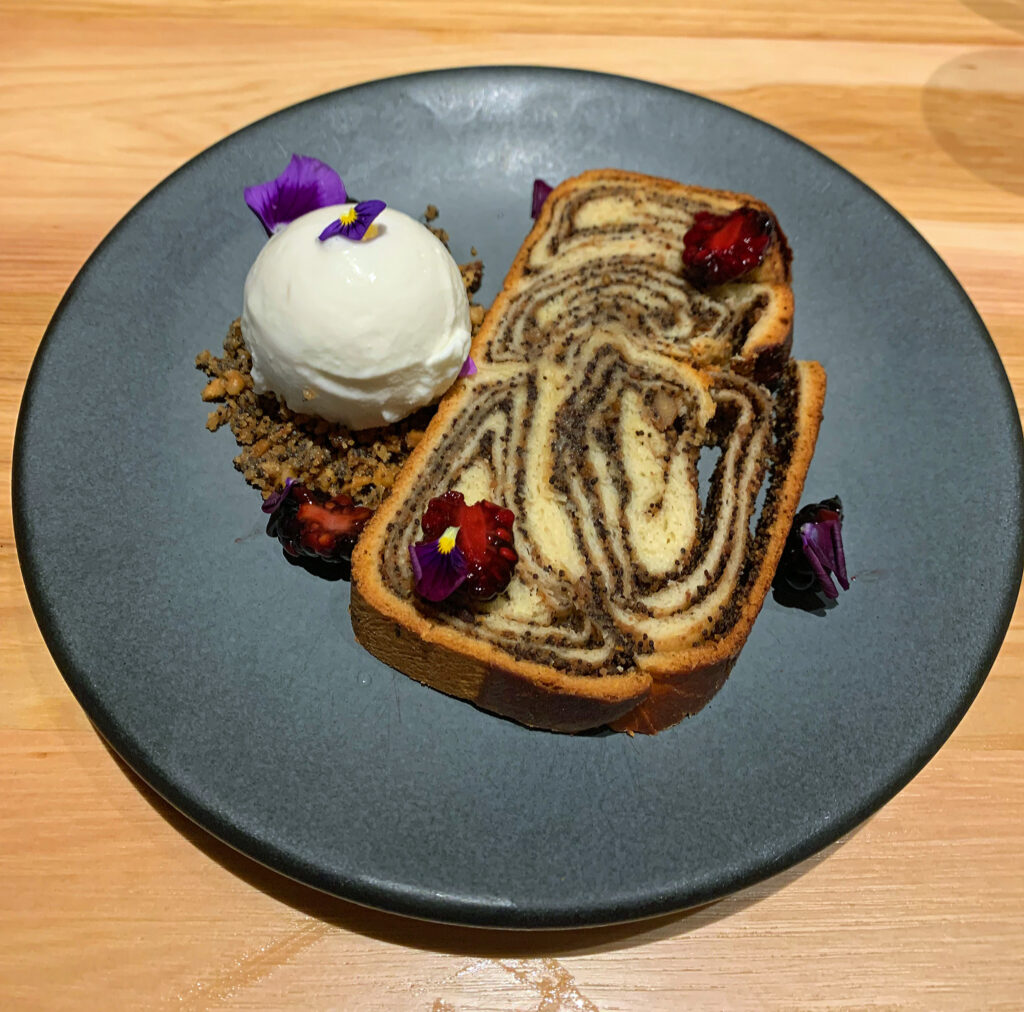
As of last week, Rose Mary added a third dessert, meaning guests can now order two composed plates to accompany their gelati and sorbetti. Titled “Poppy Seed Povitica,” the dish references a popular Croatian bread (of the same name) in which the dough is rolled around a filling (like a cinnamon roll) and then baked as a loaf. Not at all dissimilar from the method employed with certain types of babka, this technique yields the development of flaky inner layers that retain moisture and flavor from the stuffing. The most common of those—when it comes to povitica—is walnut. But, by combining the nut with poppy seed, Grossman references another Croatian (and broadly Balkan) dessert: makovnjača.
Together, the walnuts and poppy seeds lend the bread a double dose of nuttiness with two distinct textural expressions: the former being rougher and the later finer. Both of these work to enliven the softer interior portions of the crumb—while the crust, in contrast, is beautifully browned and crumbly. Blackberries—extricated from the puff pastry preparation—reappear here and offer a few bursting bites of acidity that work well with the poppy seed. But the star accompaniment is undoubtedly Grossman’s cinnamon gelato—a special flavor reserved only for this dessert. It sits atop a mound of the crumbly filling used in the povitica and infuses the dish with a final dimension of flavor. The cinnamon is not only cleansing, but it often features alongside the walnuts in recipes for the bread. So, while the poppy seed provides depth of flavor and textural support, the cinnamon still appears in such a manner as to enrich the entire dessert. The “Poppy Seed Povitica” fulfills your expectations for Rose Mary’s dessert menu, and you feel that Grossman is only now starting to put a firmer stamp on the program. Given the recent rate of change, more is sure to come.
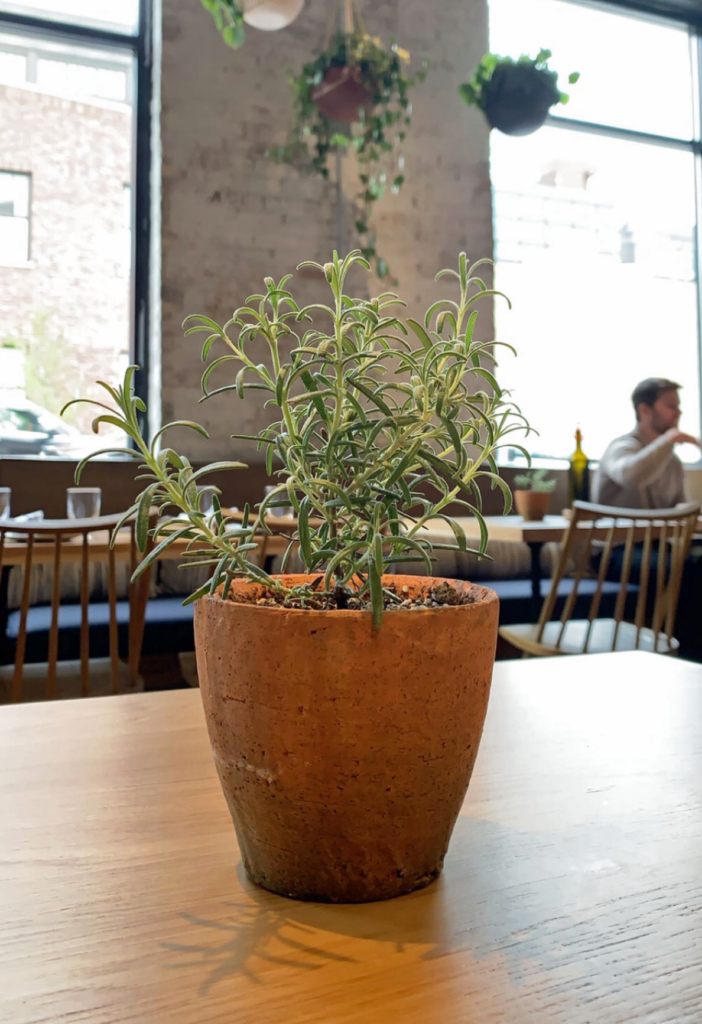
Thoroughly sated, you ask for the check. It arrives in due time, but never with the slightest bit of rushing from your server. Yes, your seats will be perpetually filled until the evening ends. But Flamm is not running a mass operation. He’s not slinging food and sauntering around the dining room just for show. Rose Mary is a tavern—but a family tavern. It is eminently accessible and welcoming to all—a testament to the chef and his staff’s character. It is expert in its mechanics and forever devoted towards achieving greater refinement—a testament to the chef and his staff’s talent. Yet, despite the national spotlight, Rose Mary is still a family tavern.
Flamm’s goal is to please his community—to satisfy them through hearty food and to offer some small education regarding the culture that has captured his heart. The restaurant stands as an expression of his personal story: South Side Chicagoan by birth, Italian-American by heritage, Italian-Italian by his professional experience, and Croatian by marriage. Rose Mary is an “exploration” of these culinary threads. It is home to a process of self-discovery through cuisine. It is a living organism in which Flamm—as both craftsman and leader—realizes the untapped dimension of creativity that can only come with the freedom to be one’s most genuine self. (Judging by the brimming positivity and warm presence of the team, they, too, benefit from that freedom).
Such a process—creatively speaking—demands taking risks. And that means making mistakes, but you have been struck by the manner in which no dish at Rose Mary is ever “good enough.” Flamm is fearless in his tinkering, and—as you have noted several times in this article—he often, intuitively, finds that last piece of the puzzle that allows the core of his original idea to shine. Nothing on the menu has been an out-and-out dud; however, a shared plates format in which a table shares a dozen different items can allow for some lulls. Those lulls, on a given night, might be disappointing. One expects, from all the hype, absolute perfection. But Flamm is only interested in the ceaseless process of self-perfection that fights bit by bit, evening by evening, to make his restaurant the best it can be.
While Monteverde and Girl & the Goat reliably offer great experiences, their menus have grown more and more static. Their concepts—being broadly “Italian” and eclectic “American”—naturally invite higher expressions of creativity within their respective, crowded genres. But that can often mean formulating a range of novel preparations and leaving them largely unchanged for many months—maybe even years—at a time. Such a strategy helps ensure the highest level of satisfaction for legions of visiting guests who might struggle ages to secure a reservation. They’ll receive all the dazzle of the “greatest hits” without any of the disappointment risk-taking with seasonal ingredients entails. But this “big picture,” touristic pleasure speaks to a readymade manner of cookery that stands distinctly from what Rose Mary is doing.
As a tavern, Rose Mary nimbly serves its neighborhood. It acts as a stage for experimentation—not of the molecular sort, but the fundamentals of Italy-meets-Croatia and Europe-meets-Midwest. To do a modern reimagination of an Italian classic or to obscure the nature of Croatian tradition in a bid towards refinement would simply not fit. Such conceits might please a media elite with nothing to offer the public but a smarmy “expertise,” but they impede the pure enjoyment of food. They stuffily try to lecture an exuberant, easygoing crowd and work contrary to the restaurant’s spirit.
The tavern plays within its audience’s (Flamm’s audience’s) comfort zone and only forges new combinations of flavors in a bid to please—not impress. Deconstruction and reconstruction might offer intellectual delight, but they—and the crowd they attract—are anathema to the mood Rose Mary seeks to build. The tavern is a place to laugh, to have a few (or more) drinks, to fill your belly, and forget your troubles. “Foodies” or conspicuous consumers looking to impress their sycophants with faux luxury need not apply. Champions of “authenticity” forever looking to assert some asinine claim to the definition of culture can take a hike. Flamm does not try to be anything he is not. His experience at Spiaggia is, no doubt, indelible—but he in no way trades on that history to fleece the Michelin-chasing crowd. And the chef’s time in Croatia—whatever inspiration that yielded—is clearly filtered through a personal lens.
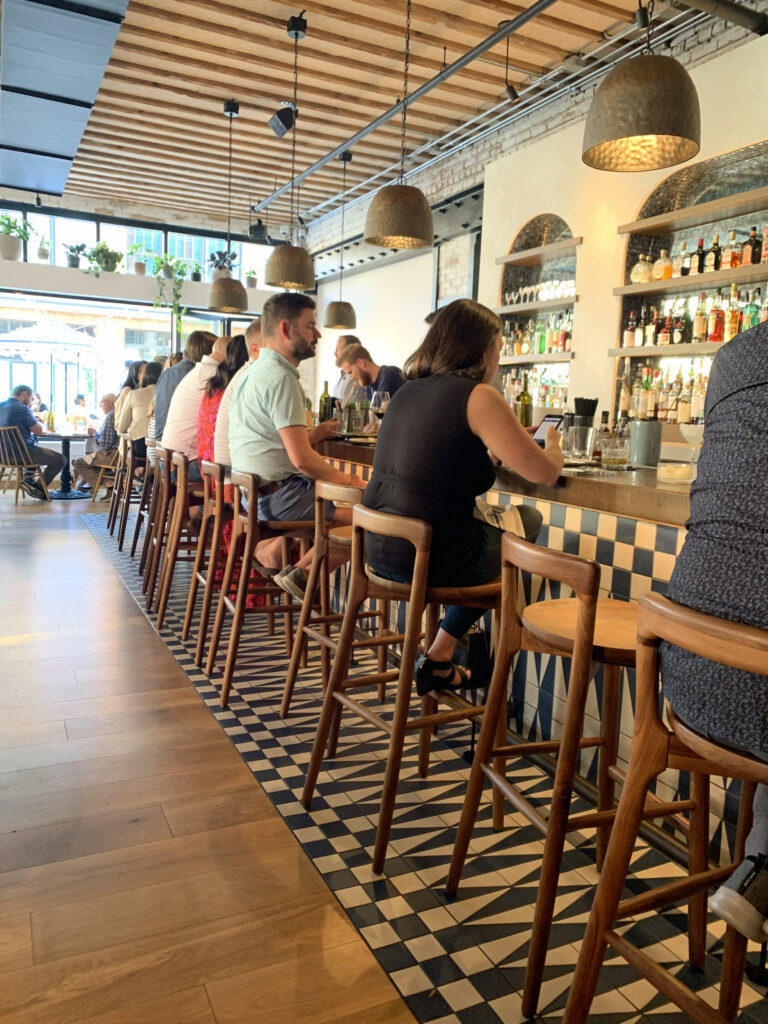
To sit at Rose Mary’s bar, alone, and cherry pick only a couple dishes from the menu is to miss the point of the concept entirely. The man drinking alone at the tavern is rarely one you want to meet. The one drinking alone and who has deluded himself into thinking he is having anything approaching a proper “dining experience” is an even sadder sort. He’s a bad-faith voyeur, a culinary hitman, content to take a tiny taste and cluck his tongue without truly throwing himself into the thick of things. Perhaps he’s ashamed to see Chicago’s tavern legacy perpetuated despite all the effort to spin the city’s dining scene in a different kind of way?
Flamm’s food—despite a few flourishes, classic as can be—is not meant to be analyzed, but enjoyed. Eating at Rose Mary is not accomplished with head bowed towards the plate, but starry eyes cast towards the mass of diners who feel affirmed by the establishment’s spirit. You slurp, munch, nibble, and chew your way through an evening surrounded by friends old and new. You lick your lips and your fingers clean. Maybe you fight over the last bite of a favorite pasta. You marvel, together, at the way the risotto walks across the plate. You cower, already stuffed beyond belief, in the face of the bone-in ribeye—but, somehow, it keeps you coming back for more.
Sancerre Hospitality, it must be said, has shown itself capable of opening a thoughtful concept. They picked out a perfect building, brought in a new designer, and built a wine list of some generosity. They let Flamm do what he does best—though, to some degree, they also deserve some credit for helping form the superb team that he leads. The chef, clearly, is not constricted in manners creative. He reflects all the dynamism of a cook deeply engaged in the day-to-day of his craft. And, it must be said, few craftsmen in this city have the forum and ability to create and flesh out new dishes week after week for a willing audience.
That, you think, is what makes Rose Mary so special. Shallow minds might point to this or that technical error on a given evening. But the experienced diner notes how ceaseless the improvements have been, how firmly some items (like the clams, ribs, burek, and cevapi) already stand as totems of the restaurant. They know how faultless the service has been, and that Flamm and team will do all it can to ensure your party has a rollicking evening. (And that includes correcting any supposed mistakes vis-à-vis the food).
Rose Mary’s foundations for longstanding success are clearly there. To you, it is already of the same caliber as a Monteverde or Girl & the Goat (or, frankly, of a higher caliber given the sorry state of the latter twos’ wine lists). Some diners, no doubt, will be annoyed by the wait for reservations (is that not true of Grueneberg and Izard’s establishments?) But they can trust that, in the interim, Flamm will be working day-by-day and week-by-week towards an ever-better menu. He will be working to define just what his restaurant’s “classics” might well be. He will, no doubt, be excising dishes that may never be seen again. For an experienced diner, engaging in such a process with a chef is one of the art’s greatest pleasures. Flamm is in his creative prime, and he now possesses the perfect outlet from which to forge a manner of cooking that is distinctly his own. You count yourself—and Chicago—lucky to be able to join him on that journey.


